- Work With Us
- Blogging Bootcamp

- Van Conversion Academy
- Campervan Shop
- Campervan Rentals
- Plan a Trip
- Itineraries
- Destinations
- Responsible Travel
- Family Travel
- Budget Travel
- Scuba Diving
- Travel Credit Cards
- Digital Nomad
- Teach English Abroad
- Blogging Resources
- Income Reports
- Travel Shop
- Meet Katie & Ben
- About Two Wandering Soles
- Personal Stuff
- Portfolio & Press

35 Expert Tips for Visiting Japan (Dos and Don’ts!)
Home » Blog » Japan » 35 Expert Tips for Visiting Japan (Dos and Don’ts!)
In this article we’re covering essential tips for visiting Japan, plus helpful advice we learned from personal experience that’ll ensure you enjoy your time in the Land of the Rising Sun even more!
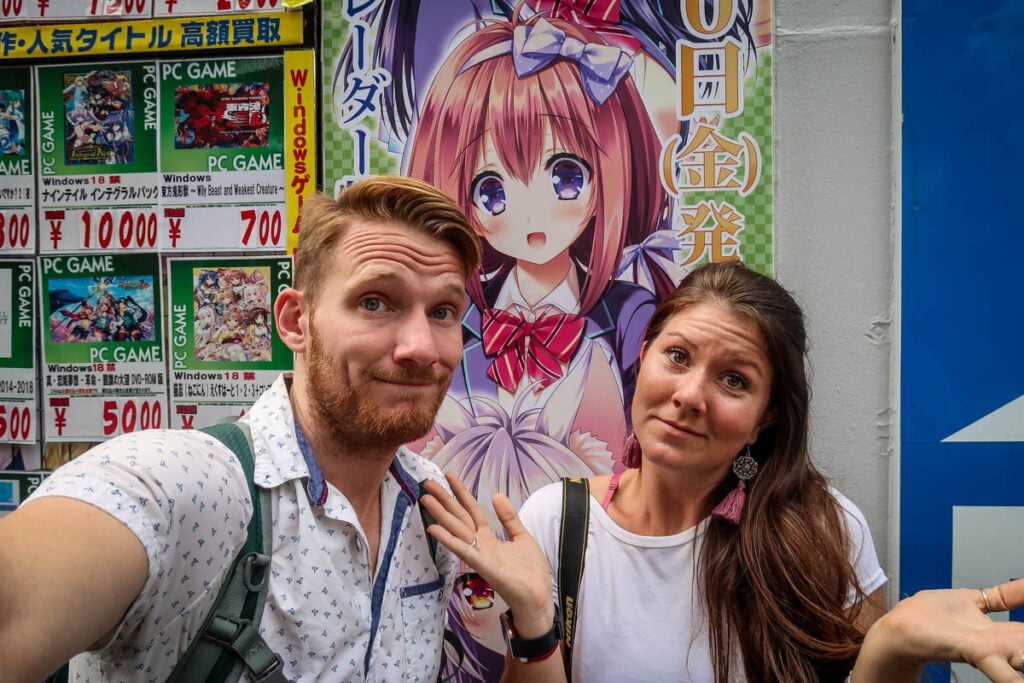
Before you hop on that flight to Japan, there are some things you should know.
This country has a complex culture, and there are definitely some manners and “norms” you should be aware of. There are also some Japan-isms that will leave you scratching your head… like, what are all those buttons for on Japanese toilets anyway?!
Don’t worry, we’ll give you the scoop! We’ve traveled to Japan three times now (and counting!) and have picked up some pretty good travel tips along the way. In this article we’re going over the essential tips for visiting Japan you should know before you go.

If you’re planning a trip to Japan, we have the ultimate resource for you!
This FREE PDF download includes everything you’re going to want to pack for your Japan trip, including what NOT to bring, plus tons of insider tips!
Sign up for our ultimate Japan packing list now and get a copy sent straight to your inbox.
1. Don’t worry too much about the language barrier
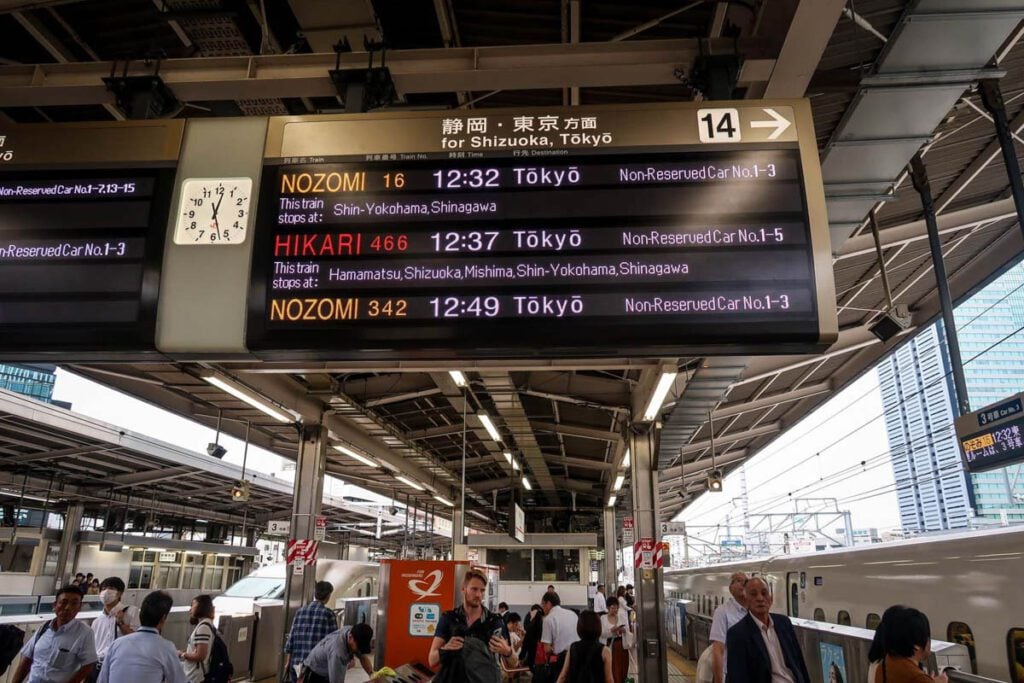
One of the things we get the most questions on is the language barrier in Japan. And after reading guide books and articles online, it can seem like traveling in Japan without speaking Japanese is impossible. But that’s far from the truth.
Honestly, we didn’t feel like the language barrier was too bad. (That said, we’ve spent a cumulative 3+ years living in and traveling through Asia, so we are used to language barriers.)
It is always respectful and recommended that you learn a few helpful words or phrases in the country you’re visiting, but we want to point out that it is possible to have a fantastic trip to Japan without having mastered the language.
This should put you at ease:
- In the event that you have a question, go to the JR counter and speak to an employee. They should have a translation device, which will help in the event that they aren’t confident with their English skills.
- Oftentimes restaurants have English menus (some even have pictures!)
- Hotel staff usually speak a bit of English
- At most restaurants there is at least one staff member who will be able to communicate with English speakers
- Oh, and the Google Translate app is literally the BEST THING EVER. Read about more apps we recommend downloading for your trip to Japan !
- Japanese people, in general, are very polite and kind. While they may not approach you, if you ask for help they will usually do their best to assist you or point you in the direction of someone who can help.
Learn a few words in Japanese, as it will show you’re trying. And be patient. Remember, you are a guest in another country, and while some people may know a bit of English, it is not their first language.
Helpful words & phrases in Japanese
- Hello: Konnichiwa (also means “good afternoon’)
- Good morning: Ohayō gozaimasu
- Thank you: Arigato gozaimasu (the “u” on the end of the word is almost silent)
- Excuse me: Sumimasen
- Cheers!: Kanpai!
- Delicious: Oishī
- More practical Japanese words and phrases
If you take one thing away from this point, I hope that it’s this:
There will be a language barrier while traveling in Japan, and you can’t expect people to speak English. BUT, it is definitely possible to communicate with simple vocab words, the Google Translate app, and a bit of patience.
2. Japan is super safe
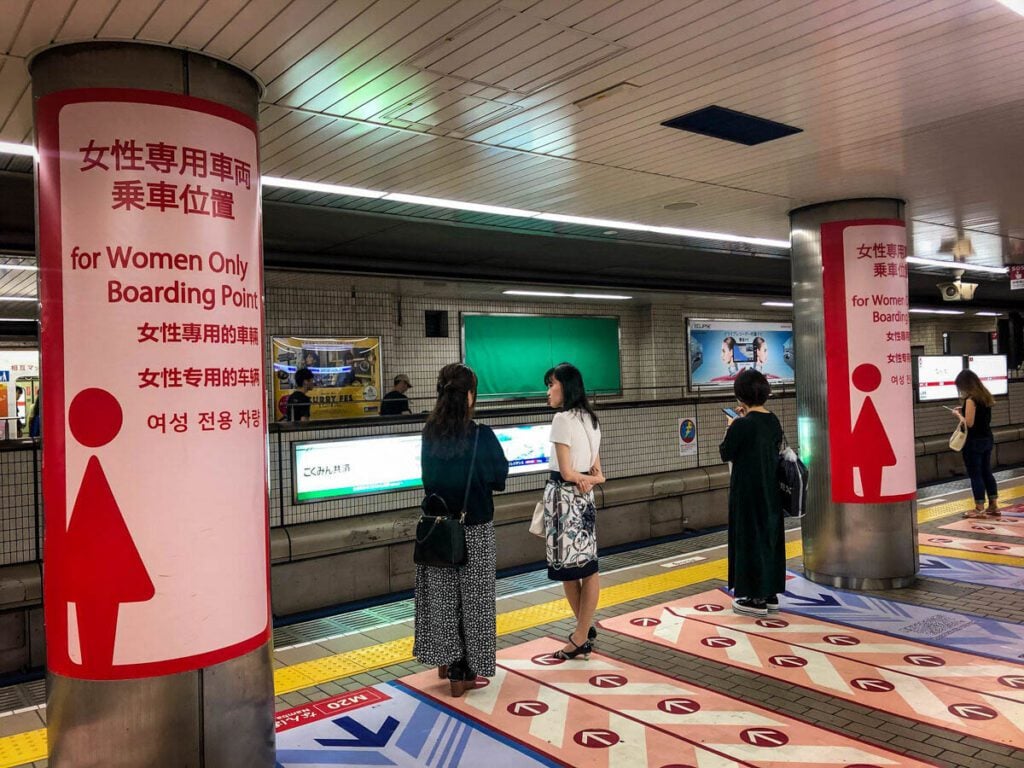
Like, very safe. Of course, you’ll still want to use common sense on your travels in Japan, but the chances of you encountering any dangerous situations or theft are very slim.
We’ve known people who have left their wallet on a crowded subway in Tokyo, only to have it hand-returned to them hours later. The thing we had to get used to was being mindful of our belongings when we returned to the U.S. after our trip to Japan!
Psst! Here are some essential travel safety tips you should know before any travels!
3. Do look into getting a Japan Rail Pass to save money
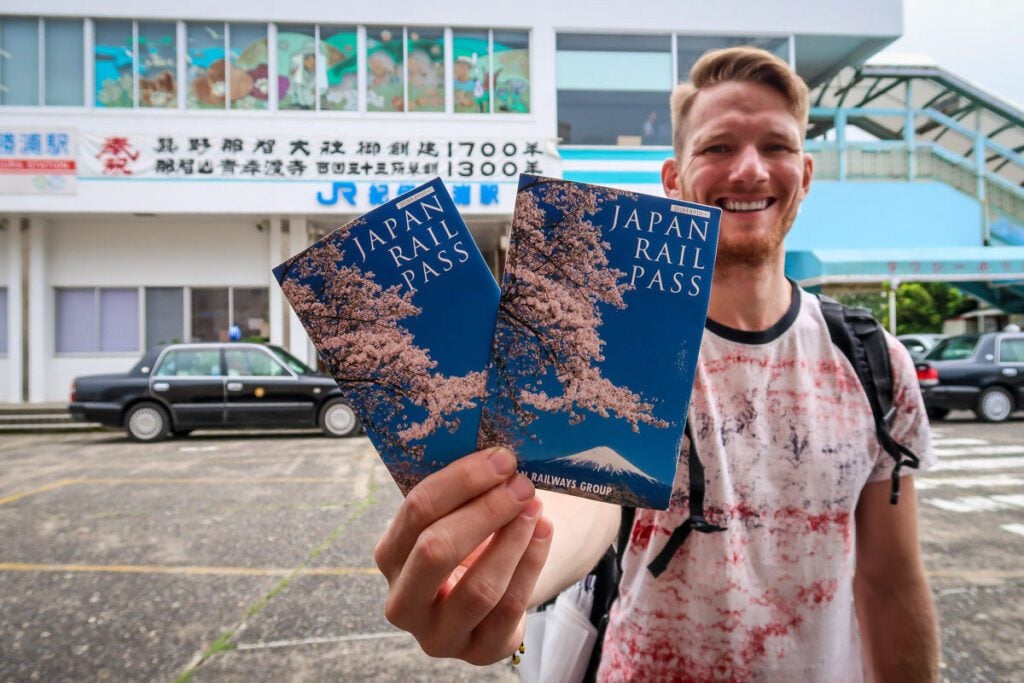
Essentially, if you plan to visit more than 2 cities during your trip to Japan, the JR Pass will almost definitely save you money .
We have a whole article detailing it and even a quick way to calculate whether or not it will be worth it for you… but chances are it WILL .

Good to know: A JR Pass is essentially the same price as a roundtrip ticket from Tokyo to Osaka. So many travelers in Japan will save lots of money by getting the pass.
Also, we didn’t know this until we were in Japan, but Japanese citizens actually cannot get this pass, and therefore pay a lot more than most tourists for train travel.
4. Book your major train routes ahead of time

Many popular routes get fully booked up, so don’t wait until the last minute to reserve seats. For example, we had to stand for the 1.5-hour ride from Hiroshima to Osaka because we didn’t book our tickets in advance.
When you have the JR Pass , all train routes are free (there are a few lines that are not included, but you really don’t have to worry about those).
We’d recommend on your first day in Japan, to go to the JR ticket counter at the train station and reserve all your seats for your routes at once. You can always change your time and book another ticket later, but it’s good to have seats reserved.
If your route is fully booked, on every shinkansen train (bullet trains) there are a couple of cars that are for passengers that don’t have reserved seats. However, there is a high chance that you’ll be standing for that ride.
5. Do eat more than sushi and ramen
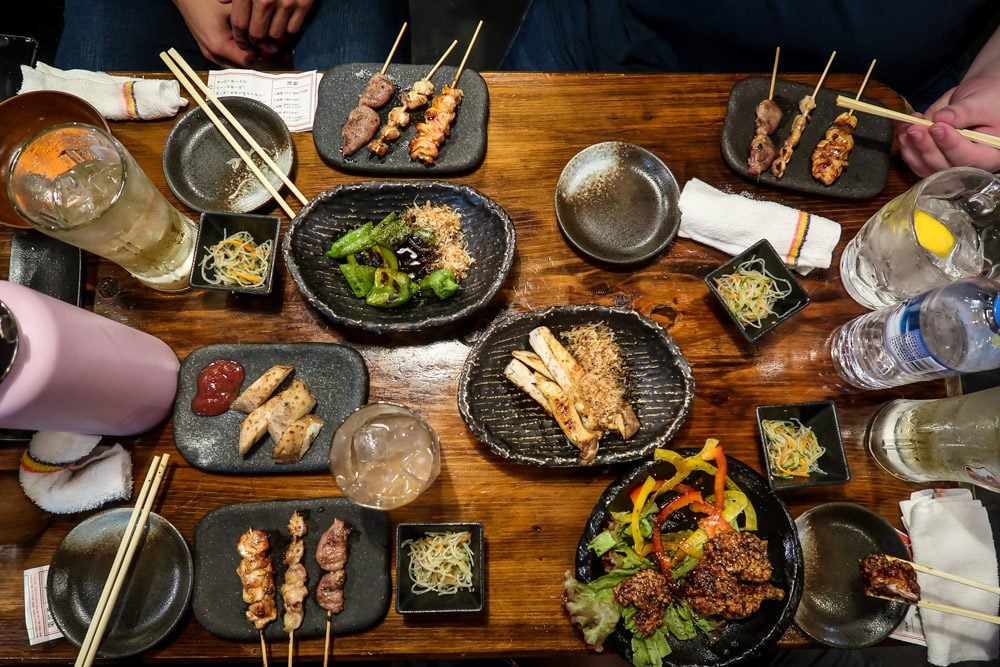
Before our first trip to Japan, our knowledge of Japanese cuisine started and ended with sushi and ramen. We didn’t know much else about it. But we’re here to tell you there is SO much more to this cuisine.
Check out our guide to the best foods to try in Japan , which even has a checklist you can download so you can make sure you don’t miss any foods! The more you know before your trip, the more you’ll be able to try.
6. Mind your manners
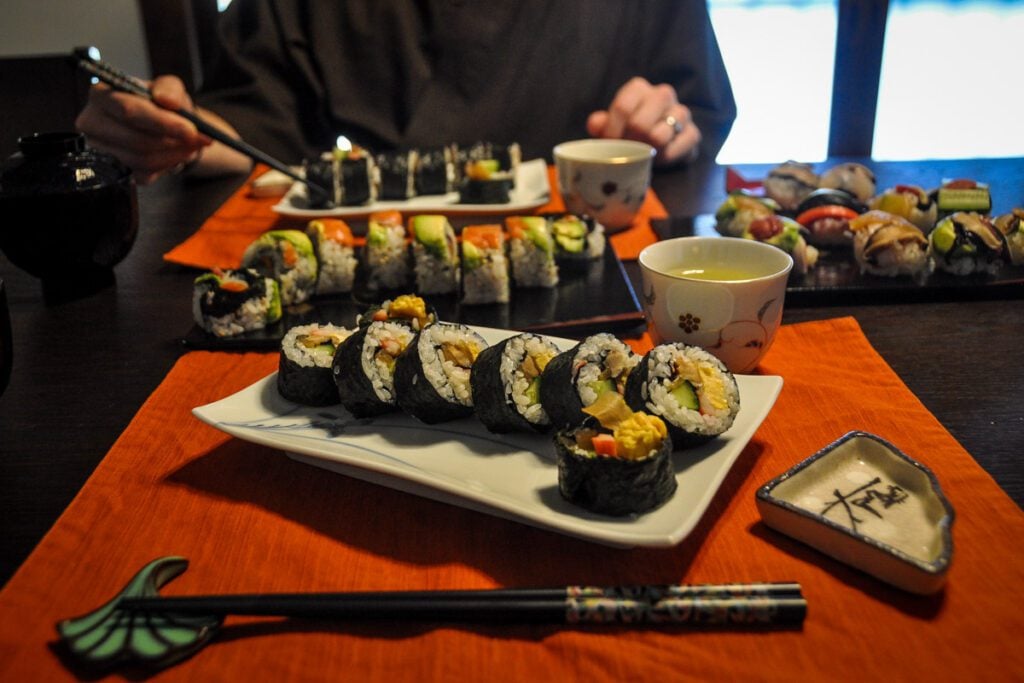
Manners are important in Japan, and it’s a good idea to read up on some Japanese etiquette before your trip so you don’t embarrass yourself or offend someone.
Here are a few manners to keep in mind:
- Instead of pointing with one finger, use your entire hand
- Avoid physical touch, like hugging, until you know if someone is comfortable with it. Also, public PDA is kind of a no-no
- Don’t eat while walking
- Be quiet on public transportation and avoid taking phone calls if possible
7. Don’t tip your server
While it is a common practice in North America, Europe and many other parts of the world, tipping is not part of Japanese culture and can be seen as mildly rude in some instances.
The Japanese believe that good service is expected (whether it be at a restaurant or tour) so there is no need to add extra money in the form of a tip.
Try to show your appreciation for a meal or tour by verbally thanking the staff, cook or guide. Leaving a review is always helpful so other travelers know what to expect.
8. Forks are few and far between
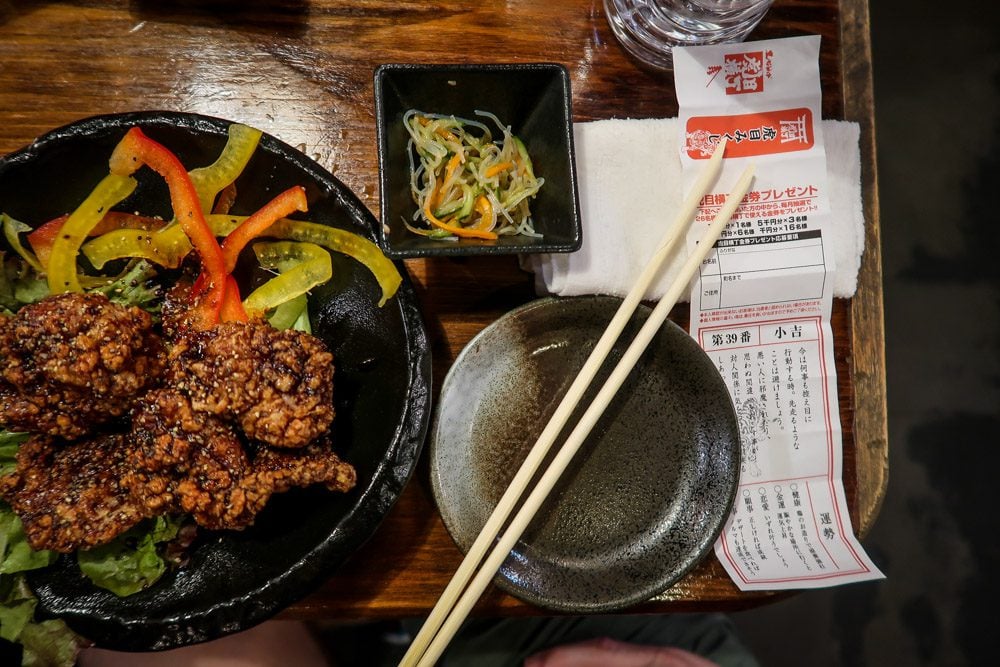
You’ll want to practice your chopstick skills before your trip to Japan because it is the utensil of choice, and very rarely will you find forks.
Hint: Chopsticks also make a great souvenir from Japan !
9. Do slurp your noodles
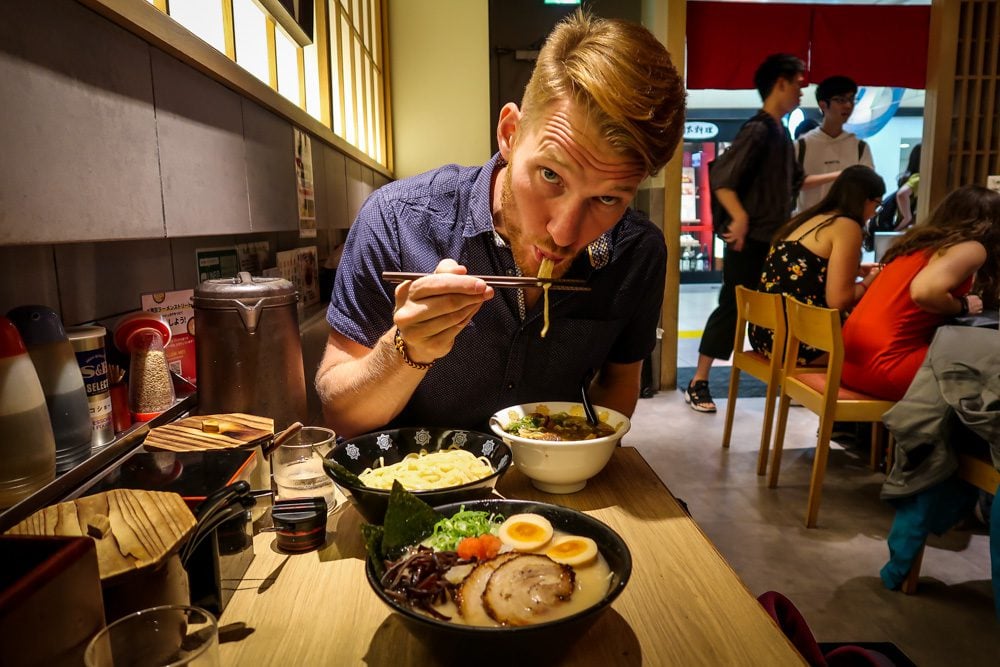
Everyone knows that slurping noodles is the best way to enjoy them , right? Well, here’s a fun fact about Japan you didn’t know you needed: it’s actually not considered rude!
In Japan, slurping your noodles is actually considered a sign of appreciation . It shows the restaurant or chef that you’re enjoying their food. Plus, slurping can even enhance the flavor!
10. Don’t forget to take your shoes off
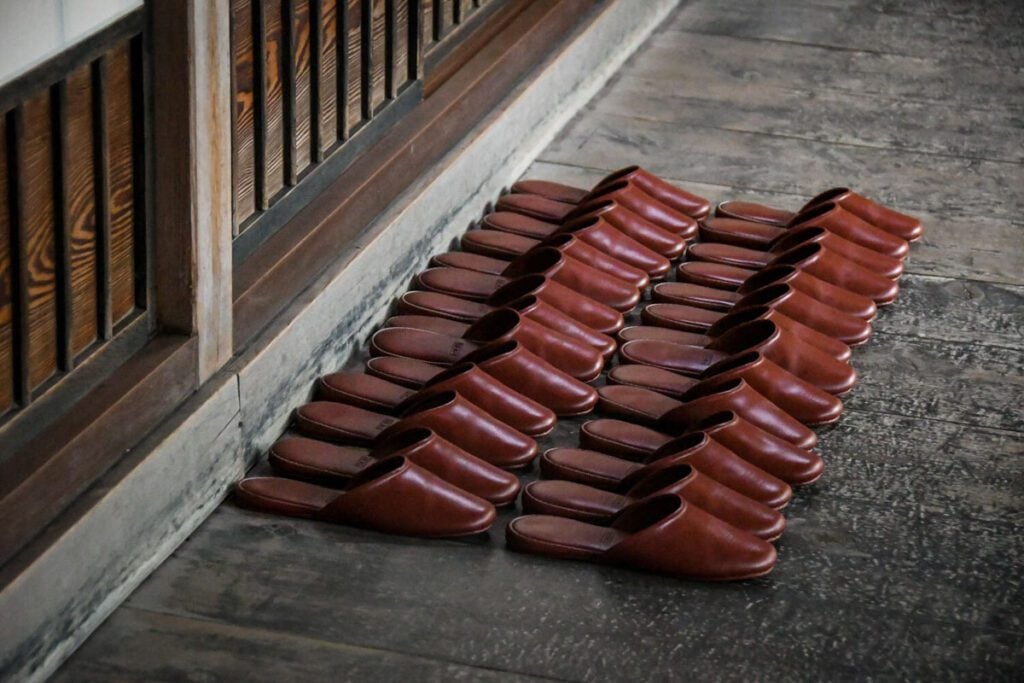
When entering guesthouses, homes, holy sites, and some stores, you will need to remove your shoes. This is typically indicated by floor that is different levels — either raised or lowered once you enter.
Usually there are indoor slippers that you can wear once you remove your shoes. The exception to this is in rooms where the floor is tatami mats — a delicate traditional flooring made of rice straw. These are common in traditional guesthouses and teahouses, inside which you can wear socks.
Also, some guesthouses have bathroom slippers. Yes, you read that right, shoes for the potty. Typically they will be sitting just inside the bathroom door and you’ll leave your indoor slippers outside of the bathroom.
11. Do learn onsen etiquette
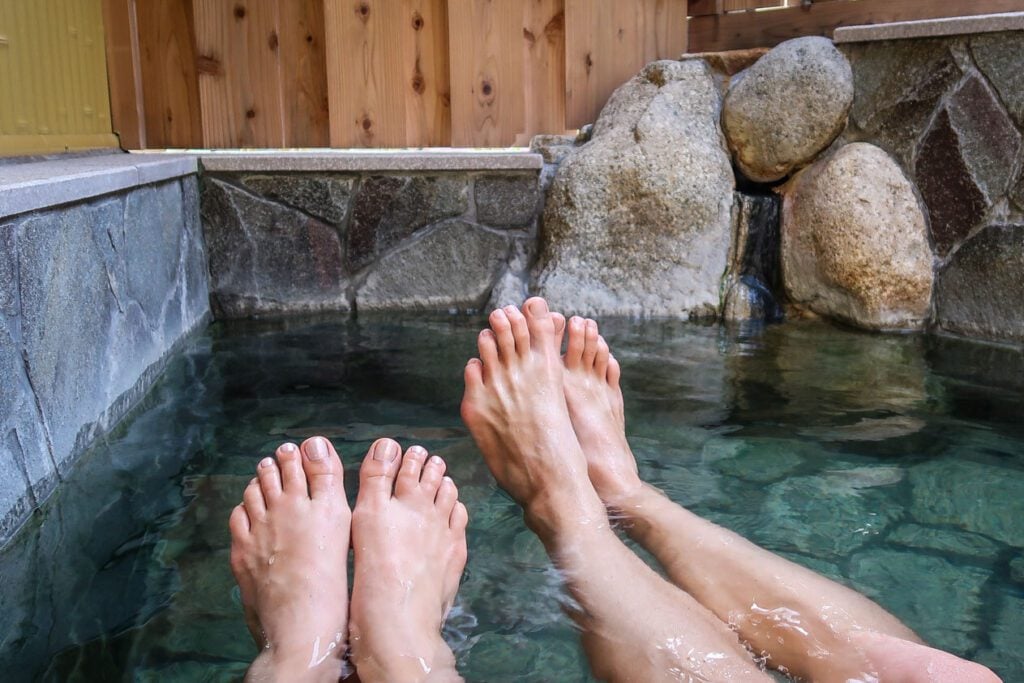
Soaking in an onsen should definitely be on your list of top things to do in Japan !
Hold up, what is an onsen, exactly?
An onsen is a Japanese hot spring with a bathing facility.
Japan has a lot of volcanic activity, meaning there are many onsens to choose from all around the country!
But before you start shedding your clothes, there are some important rules you should know so you don’t embarrass yourself…
Basic onsen etiquette
- Shower before you get in , oftentimes it’s at a shower where you will sit on a stool and rinse yourself off.
- Unless otherwise noted, do not wear a bathing suit.
- You can bring a towel into the bathing area, but don’t let it touch the water (many people put it on top of their head).
- Tie up your long hair so it doesn’t touch the water.
- Know the onsen’s policy on tattoos. Many onsen do not allow guests with tattoos, so you’ll have to seek out onsen where it is accepted or opt for a private onsen facility.
We go into more detail about onsen rules in our Japanese etiquette article.
Alternative: For those of you who just can’t get over the whole naked in public thing (I get it!), you may want to consider staying at a ryokan with a private onsen. This means you can reserve a time slot for yourself (and a travel partner if you wish).
11. Understand the difference between a shrine and a temple
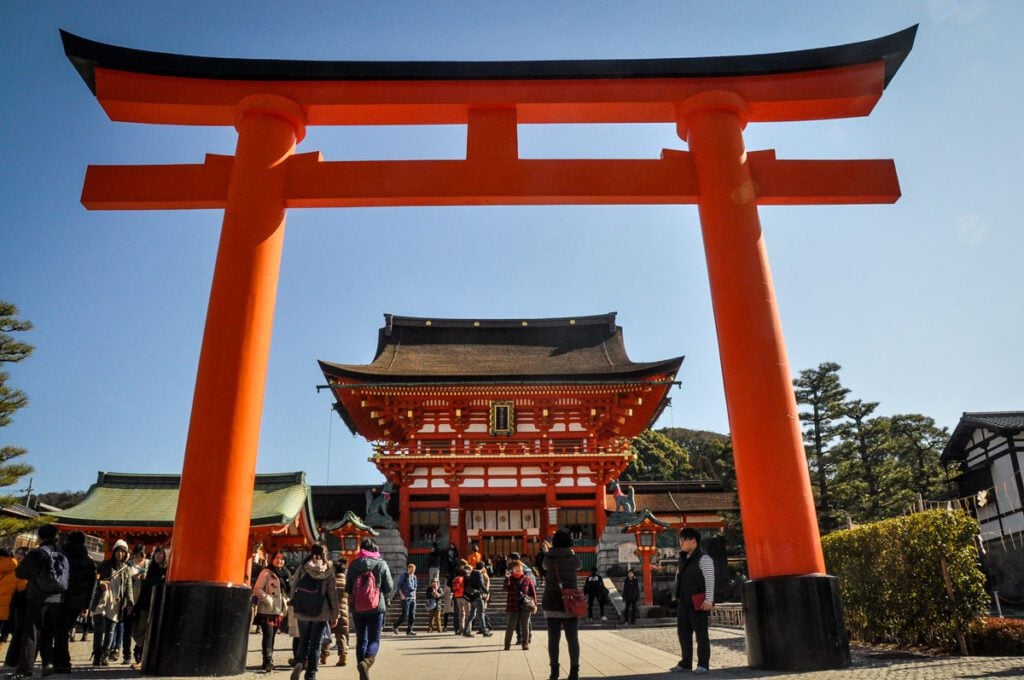
Before traveling to Japan, it’s very useful to know the difference between a shrine and a temple. Here is a general guide to help you:
Shinto Shrine:
- recognize them by the tori gates
- purification fountain (called chozuya ) with ladles
Buddhist Temple:
- large incense burner
- statues of Buddha
- sometimes a graveyard is attached
We have a whole section on how to visit a shine and a temple in our Japanese etiquette article.
12. Japan is not as expensive as you might think
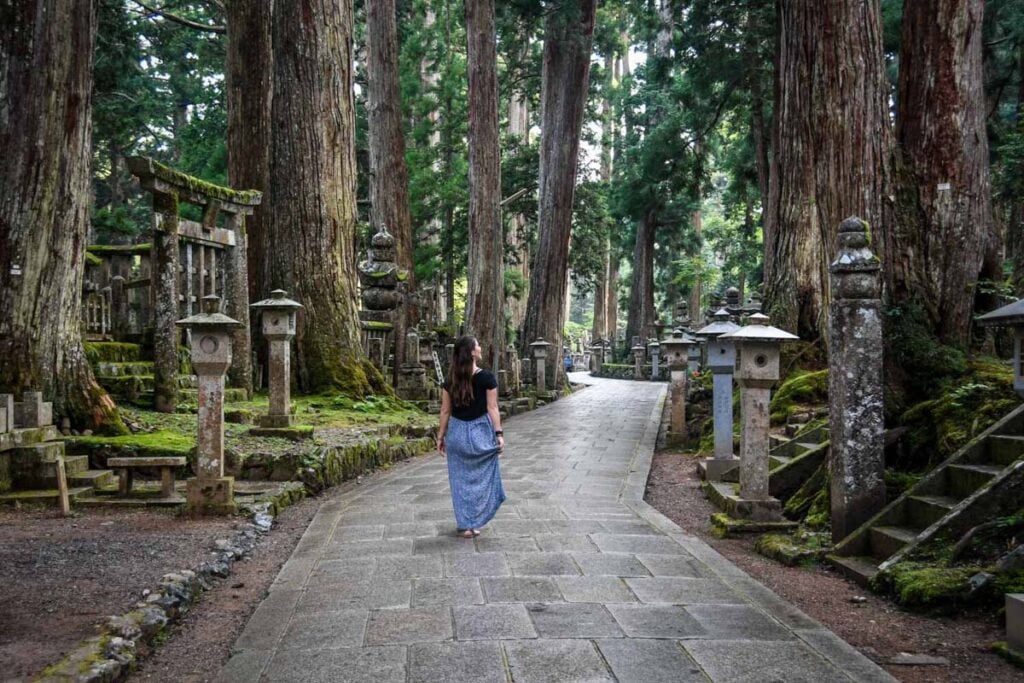
We’ve traveled extensively around Asia, and it’s true — Japan is one of the more expensive places we’ve visited in this region of the world. That said, it is still possible to travel Japan cheaply.
You can find budget accommodation in hostels, capsule hotels, or even Airbnbs . You can save money on food by eating at convenience stores, cooking some meals yourself, and planning out “splurge meals”. Cut transportation costs by getting the JR Pass , and enjoy all sorts of free things to do around the country.
Psst! We have loads of info on how to book Airbnbs , including red flags to watch out for when booking and our favorite Airbnbs.
Traveling to Japan doesn’t have to be crazy expensive. We’ve rounded up some of our top tips for traveling to Japan on a budget .
Moral of the story: If Japan is a country you’ve been dreaming of visiting, don’t let costs inhibit or deter you from making your dream a reality!
Related: We’ve got tons of super practical tips to show you how we afford to travel !
13. Do carry cash AND credit cards
Many places in Japan accept foreign credit cards with no problem. And if you have one with no foreign transaction fees that earns good rewards, you’ll definitely want to bring it along and use it as much as possible.
That said, there are still small shops, restaurants, and even guesthouses that only accept cash , so you’ll definitely want to have some Japanese yen on hand.
14. Withdraw cash from 7-eleven ATMs
The ATMs in 7-elevens are the most reliable ATMs in Japan with no fees for international cards. As a bonus, you can find 7-elevens everywhere! However, it’s good to note that some of the 7-eleven ATMs in popular spots do now charge a fee, so try to withdraw in less touristy areas.
Insider Tip: We always get foreign currency by withdrawing from ATMs, as it gives you the best exchange rate. To avoid those pesky ATM fees, we use our Charles Schwab debit card, which reimburses all ATM fees at the end of each month. It is the BEST card ever! Read more about which travel credit cards we recommend .
15. Don’t throw out your coins
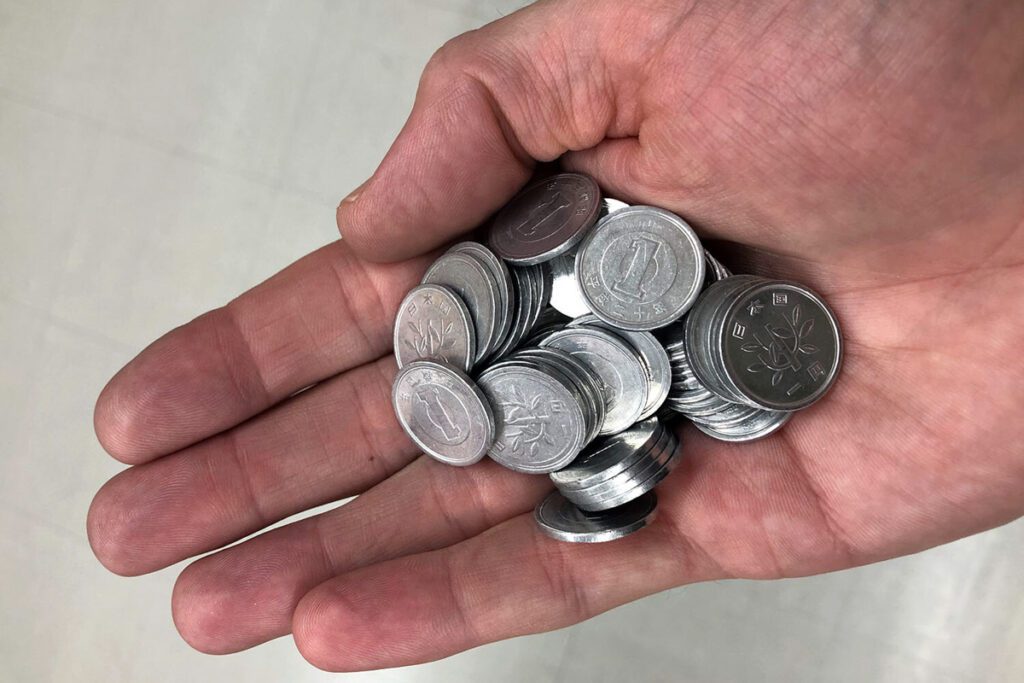
Some of those yen coins are worth almost $5 USD! I don’t know about you, but I typically throw coins around without much care — I mean, it’s no big deal if I misplace 12 cents… But in Japan, losing a handful of coins could add up to big money.
While on a train, a bunch of coins fell out of Ben’s pocket and we had to get down on our hands and knees to find them all before our stop. When we counted them all up we realized we nearly lost $24 USD in coins. Yikes!
When traveling in Japan it’s a good idea to have a coin case to keep them secure.
Tip: We met another traveler who had two coin purses — one for the large coins and one for the small ones to keep them organized.
16. Don’t get lost
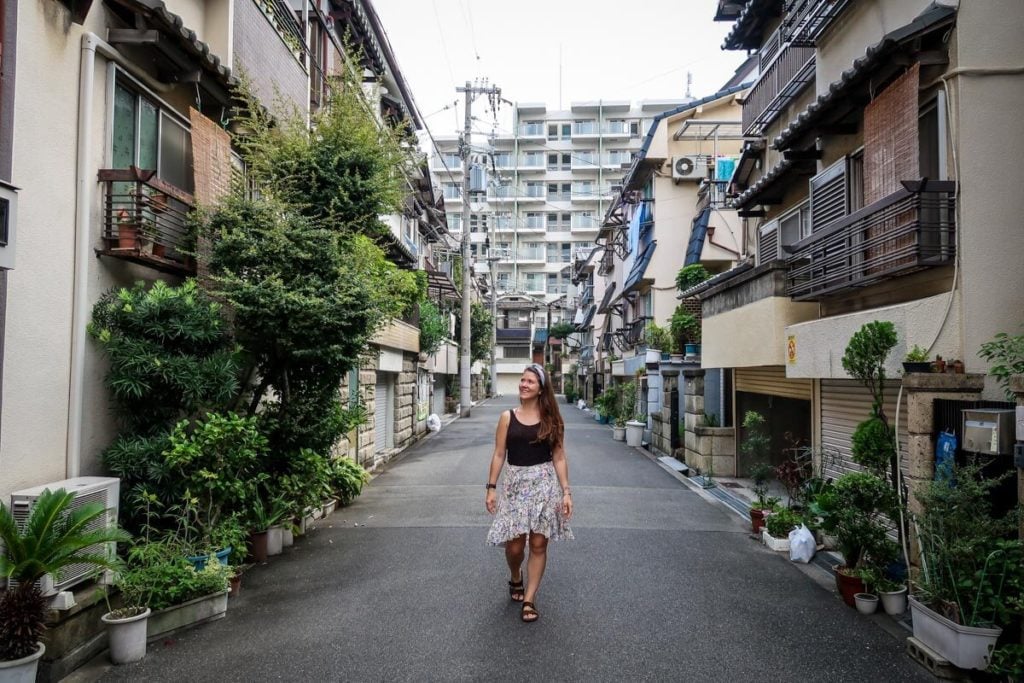
If you’re someone who’s not great with directions, you may find it alarming to find out that streets don’t have names in Japan… So how the heck are you supposed to find your way around?!
Although there are no street names, it isn’t a free-for-all. Addresses in Japan use an area-based system, where each area is divided into smaller areas .
The largest of these is called a prefecture. Prefectures are broken down into cities, and the cities are divided into wards.
Getting around and following directions in Japan is definitely a learning curve, so it’s worth studying some maps and taking time to research the numbering system before visiting.
17. Hold onto your trash
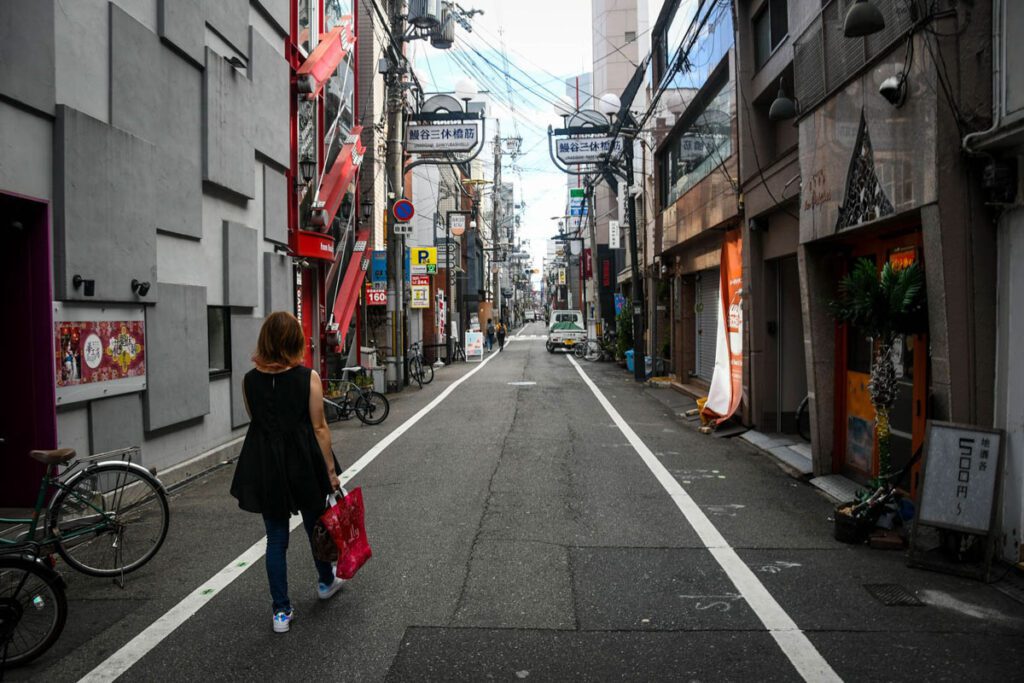
There are few trash cans on the streets in Japan. After hearing this, you might be surprised to learn that even though there is a shortage of garbage bins, there is very little litter in Japan.
Cleanliness is a big part of Japanese culture, which is reflected in the (mostly) litter-free streets.
So do as the Japanese do, and hold onto any wrappers until you find a bin. There are typically trash cans at convenience stores, meant for customers to dispose of their garbage.
18. Do the work to avoid plastic waste
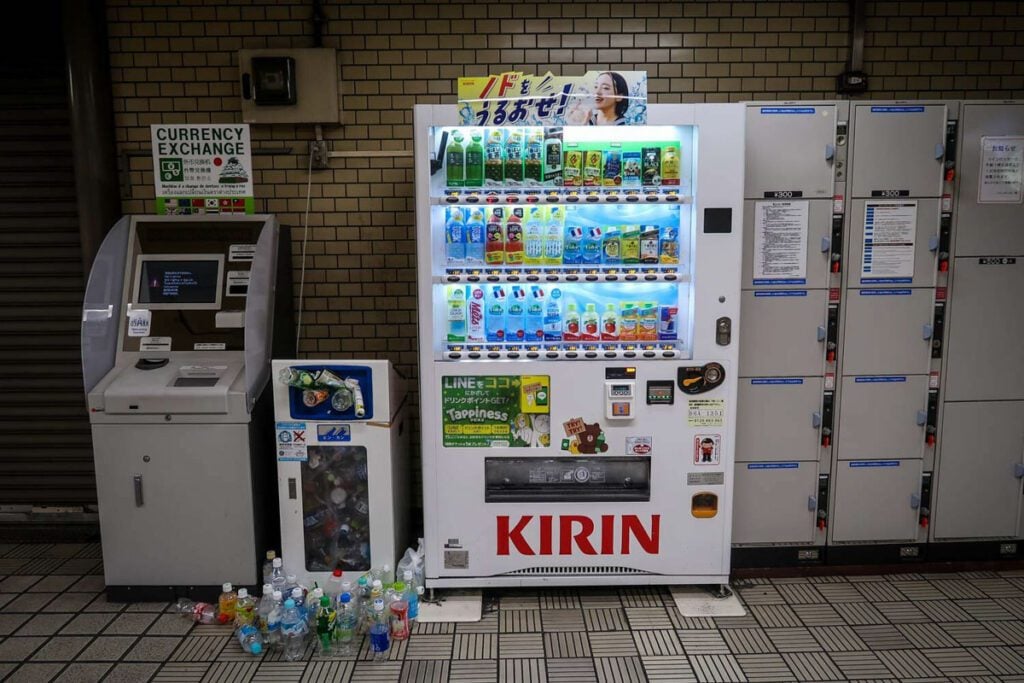
On the surface, Japan seems to be environmentally conscious: there are recycling bins every so often and the streets are very clean.
But as soon as you stop into a convenience store, you’ll notice that this country, like much of Asia, relies heavily on plastic packaging. And the super unnecessary kind, like plastic wrappers around single bananas.
As a traveler, there’s not too much you can do to change this, but you can reduce your own plastic waste by packing items that’ll help you turn down single-use plastic items.
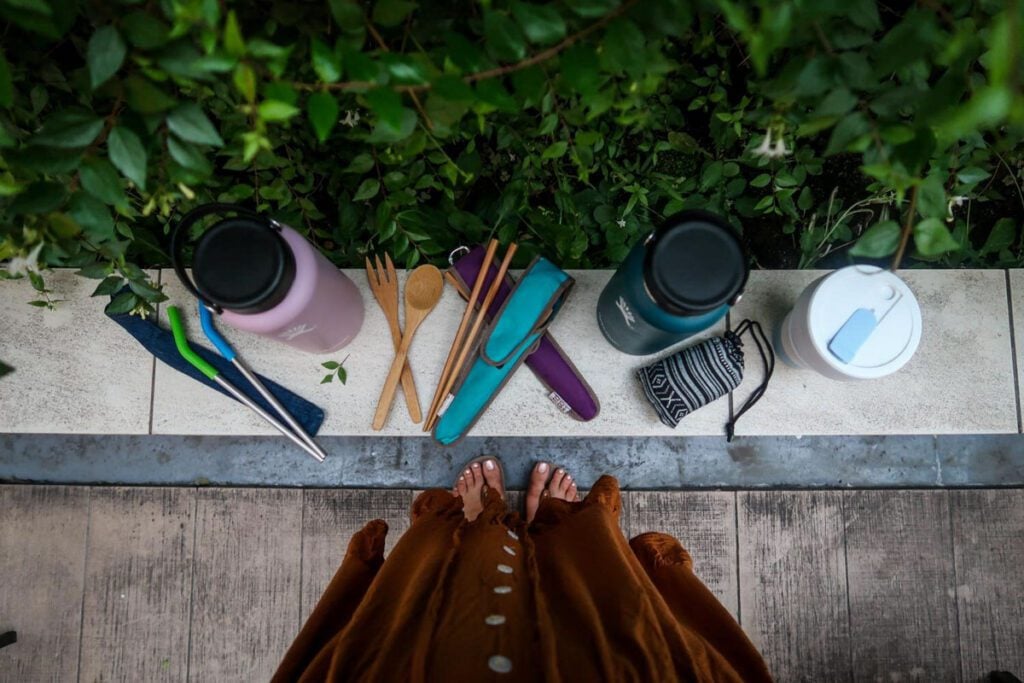
Here are some items we’d recommend packing:
- reusable utensils
- reusable straw
- water bottle *
- reusable bag
*Yes, you can fill up from the tap and drink the water in Japan! There’s an app called MyMizu that has a map of refill stations (mostly in larger cities, but I’m sure they’re expanding it as data is available).
Check out our eco-friendly packing list for some more ideas!
19. Choose an interesting hotel option
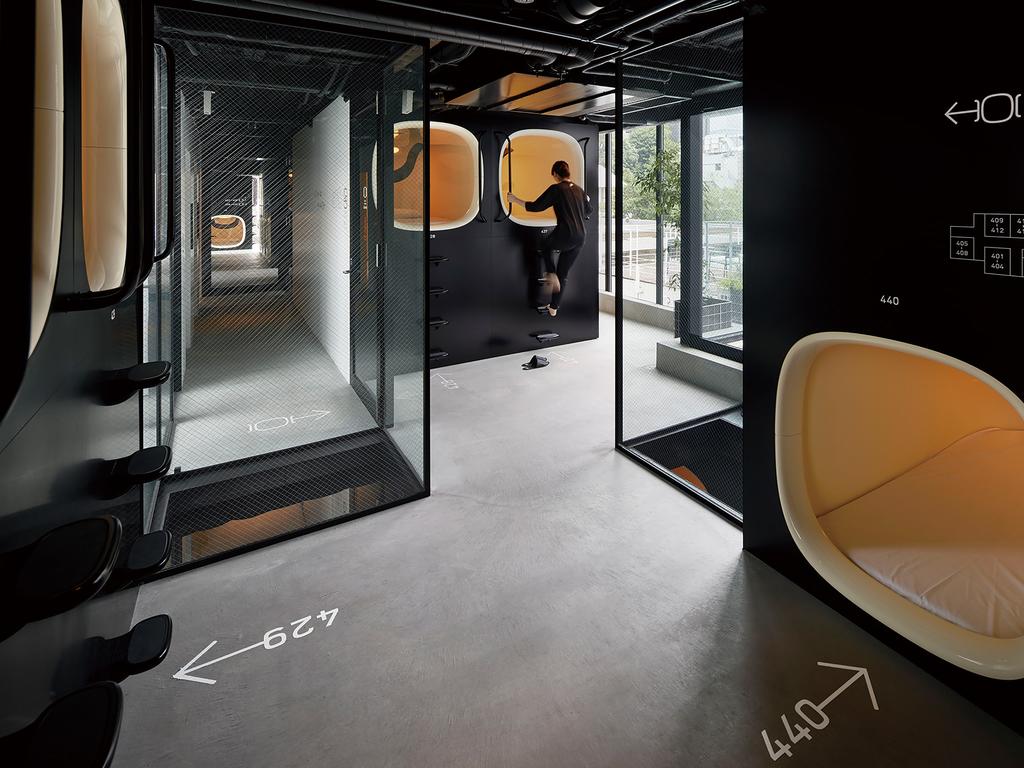
While traveling in Japan, you might want to try out a few unique hotel stays that you can find only in Japan.
- Ryokan: This is a traditional Japanese inn that typically provides guests with robes and meals. There is often a shared bathroom and onsite onsens that can be used by guests.
- Capsule Hotel: Made to maximize space in crowded cities, capsule hotels provide guests with privacy and an affordable stay. However, don’t expect to stand up in your pod! Staying in a capsule hotel is definitely a top Japanese experience to try out on your trip!
- Robot Hotel: There are even hotels run by robots! Like we said, #OnlyInJapan
20. Learn how to use a Japanese toilet
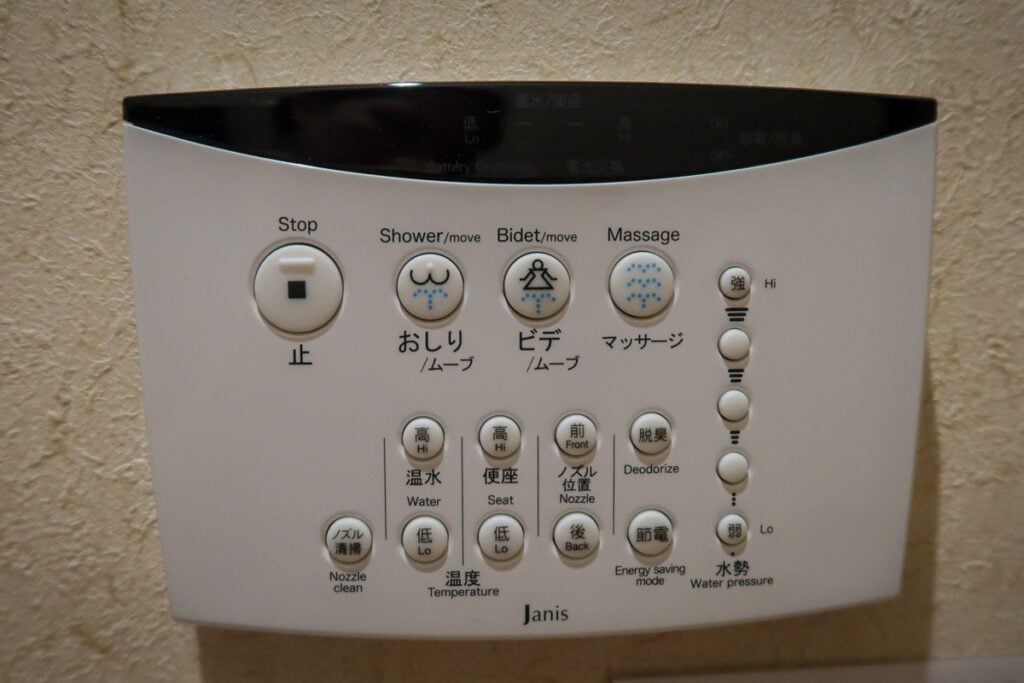
You’ve probably heard about Japanese toilets, and what the rumors say is true!
There are all sorts of buttons that perform different functions. For example, one button may play waterfall sounds or music to cover up— ehem —some other sounds you may not want the person in the next stall to hear. Other buttons will trigger a bum wash and can be set at varying pressure strengths.
All those buttons can be a little intimidating at first, but try them out (locate the STOP button first) and take advantage of those fancy toilets while you can. Because you surely don’t have those fun features at home!
21. Download these apps before you get to Japan
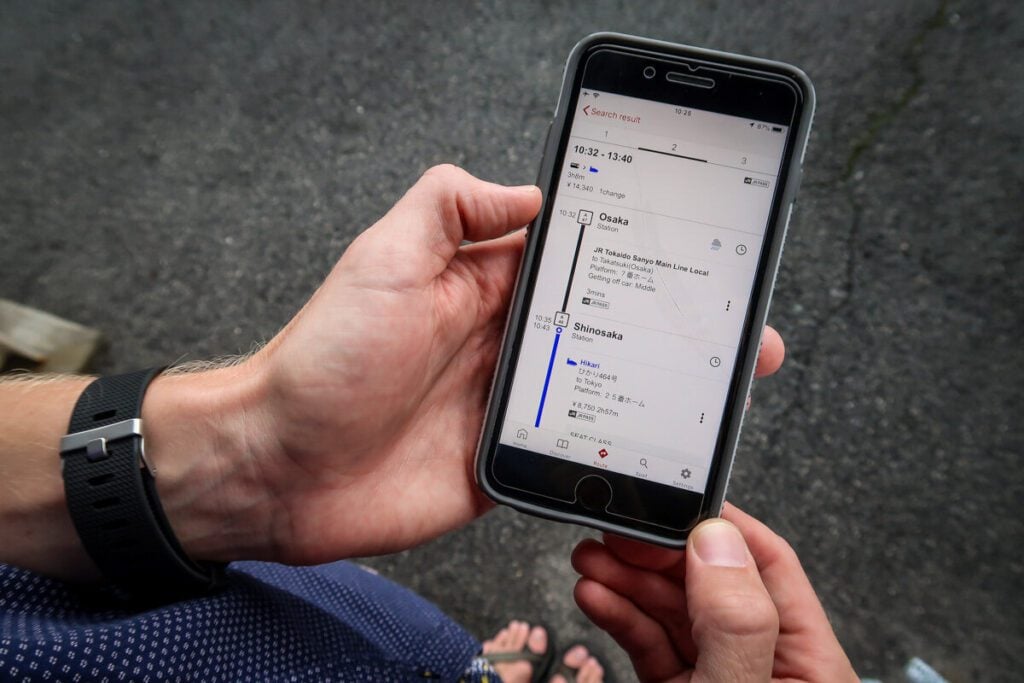
We have a whole article detailing all the best Japan travel apps you should download before your trip, but the 2 best ones that you NEED to download are:
- Japan Official Travel App
- Google Translate
You will thank us because they will come in so handy during your trip!
22. It’s difficult to be gluten-free in Japan
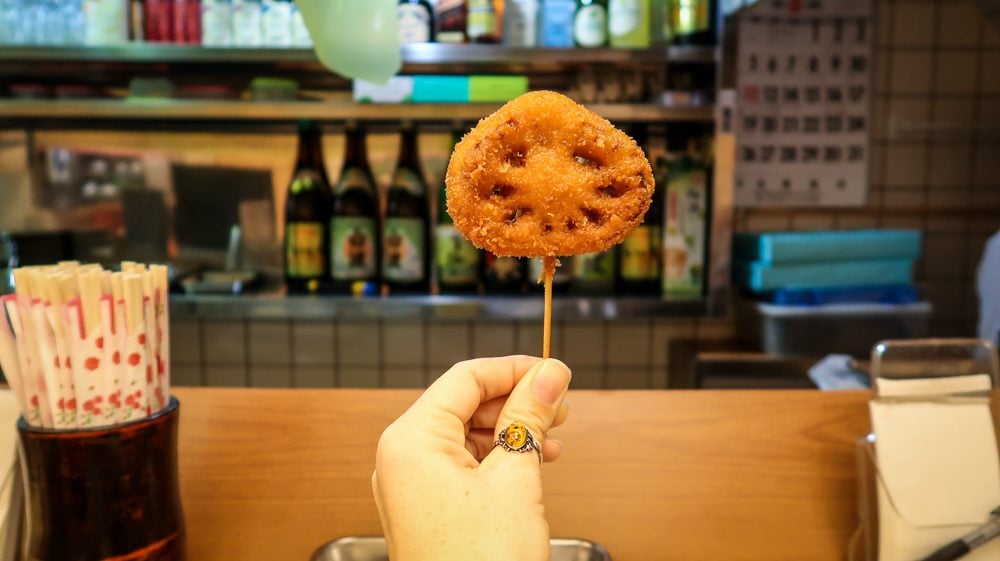
While the abundance of rice may make you think Japan would be an easy country for gluten-free travelers, that’s simply not the case. Soy sauce and other wheat-based seasonings are an integral part of Japanese cuisine, making it hard to avoid gluten.
Read this for more info on gluten-free travel to Japan .
23. Be on time
In Japan, it is seen as rude to be late, and thus, everything in Japan is run very strictly according to the clock.
This means trains leave exactly as scheduled and guests are often asked to show up to guided tours 15 minutes in advance. If you have a tendency to be late (I’m right there with ya!), be sure to pay extra careful attention to the time during your trip to Japan.
24. Utilize coin lockers to make things easy
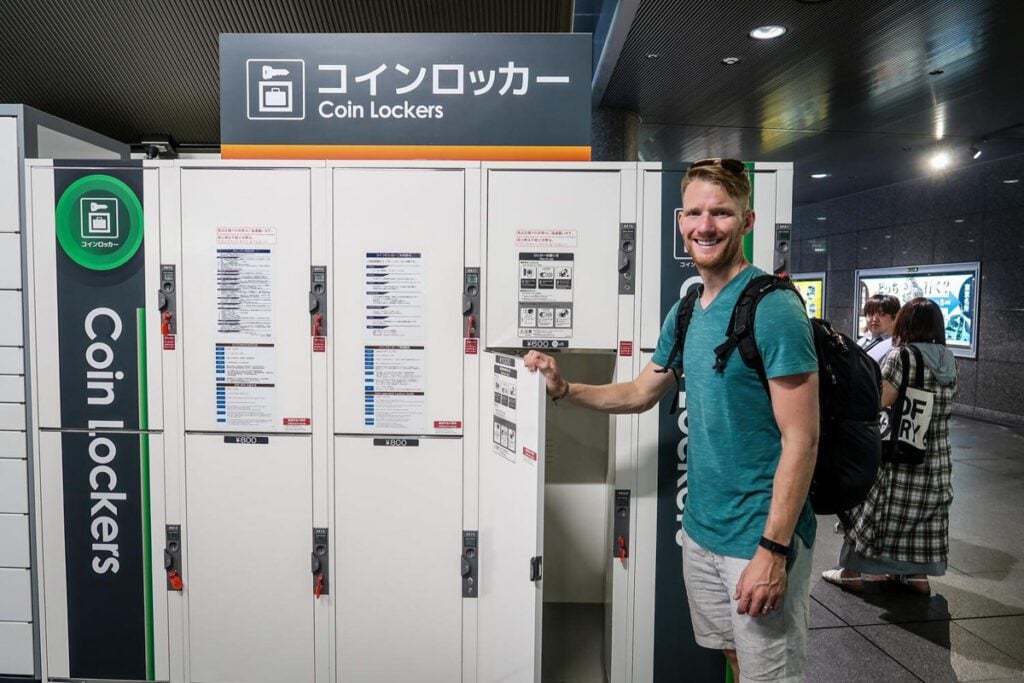
Nearly every train station has lockers which you can use to store belongings for a reasonable price. There are usually different sizes available, so you can store anything from a purse or small daypack to a large suitcase.
This is handy when you need to check out of your hotel but want to spend the day exploring.
Insider Tip: If you have a suitcase that you don’t want to bring with you on the train, there are luggage transport companies that can get it to your final destination for you!
25. Theme cafes are part of the experience

Japan is known for all things quirky, and this applies to restaurants and cafes.
The famous Robot Restaurant , with its laser beams, giant robots and scantily clad performers, is an example of something you can only find in Japan. But the theme restaurants don’t stop there. There are plenty of other over-the-top themed restaurants and cafes in Tokyo and Osaka you can visit to get the full experience.
However, it’s important to beware and do a little research before patronizing them.
Some of these theme cafes have a dark side. For example, many of the animal cafes (hedgehog, owls, sheep, etc.) do not have a safe and healthy environment for the animals. Also, there are anecdotes of young waitresses being exploited in the infamous “maid cafes”.
And no matter which cafe you go to, just remember, you’re not there for the food, which is usually sub-par. And it’s also worth noting, you’re paying for the experience as well!
26. Staying connected is easy
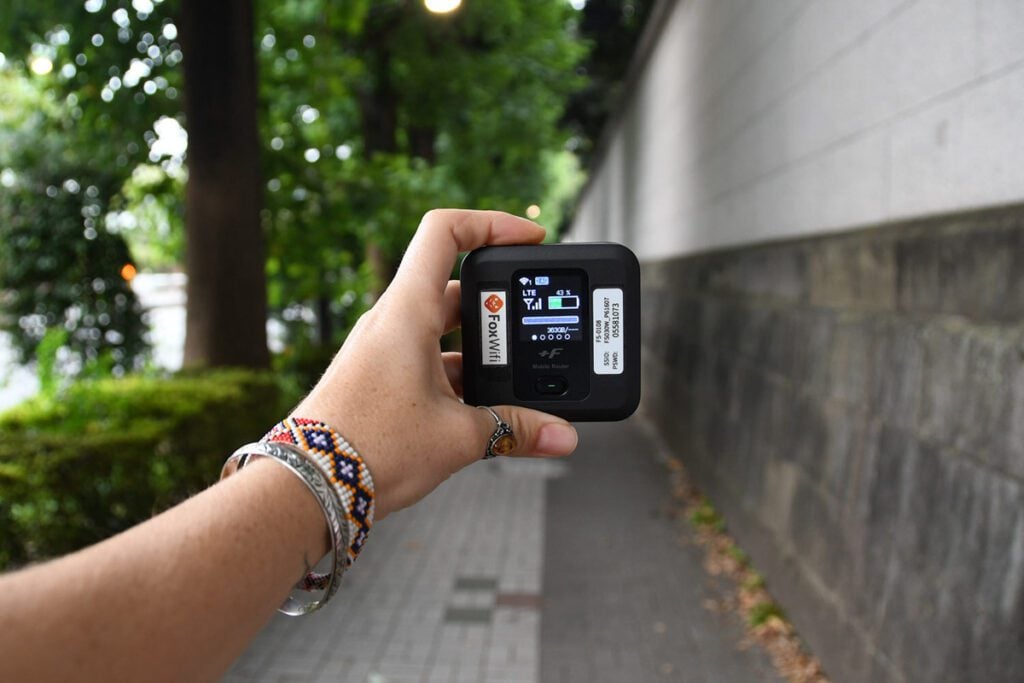
Staying connected to the Internet is very useful when traveling in Japan. And not just because you can post your pretty pictures to Instagram to make all your friends jealous…
Having an Internet connection will make your travels SO much easier when it comes to translating Japanese writing and getting directions for the notoriously confusing train and metro systems.
Trust me, having translating and navigating abilities in Japan is an absolute LIFESAVER.
The two best ways to stay connected is with a SIM card or via a hotspot. The best option is going to totally depend on your needs and budget, and we’ve compared them here so you can choose the best one for you.
27. Convenience store culture is a thing
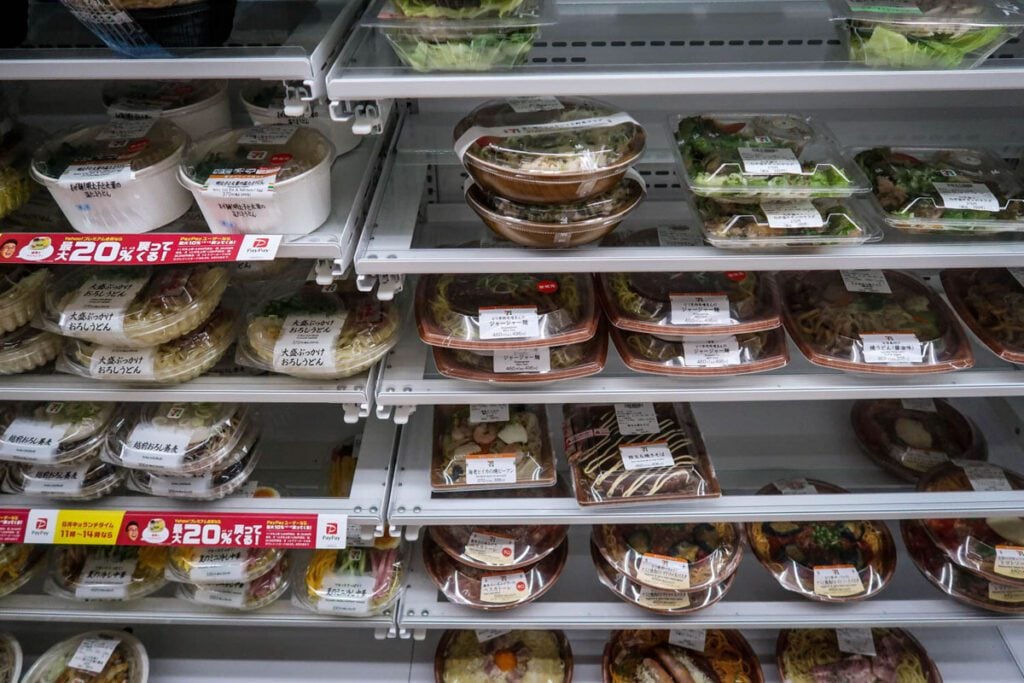
Convenience stores are a big deal in Japan.
And the food options in Japanese convenience stores are much larger — and less sketchy — than in most other places around the world. I mean, I would NEVER get sushi from a convenience store in the U.S., but I definitely did just that in Japan. And it was good!
You can literally eat breakfast, lunch, and dinner (and all your snacks too!) from convenience stores. The most popular chains are 7-Eleven, Lawsons, and Family Mart, and you can find them on just about every city block. No joke.
I will say that at the end of the day, the food you’ll find — while good — is still processed, packaged food. Some people claim they would live off of convenience store food in Japan. I am not one of those people!
I did enjoy it in moderation, and loved being able to try some super quirky treats, like Sugar Butter Sand Tree Cookies , which are weirdly delicious and familiar-tasting!
28. Don’t expect to eat lots of fresh fruits & veggies
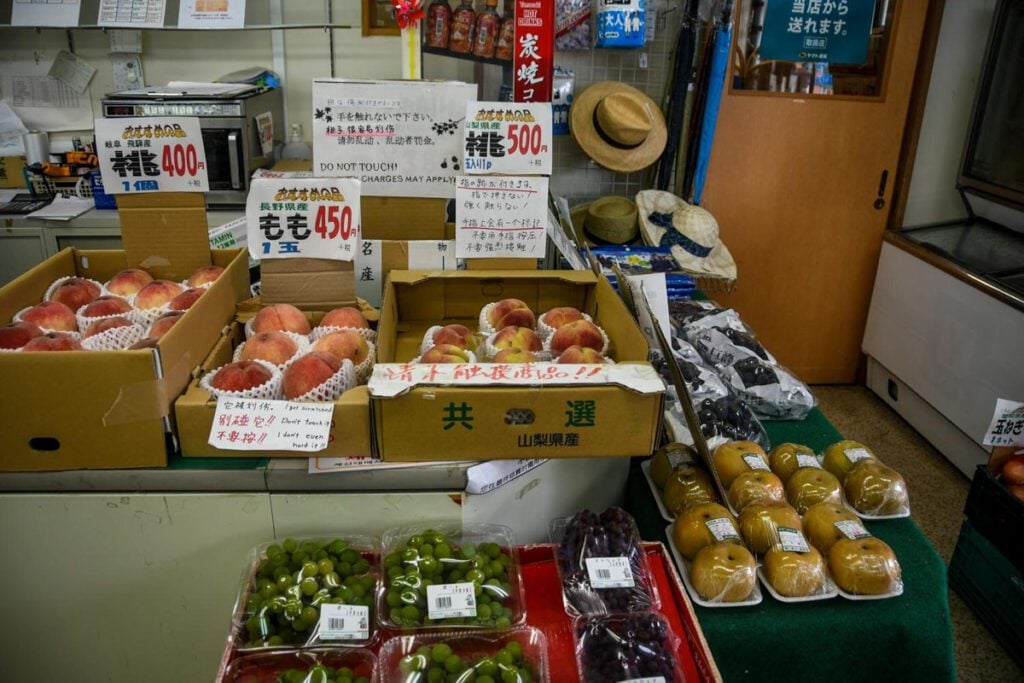
It might be good for some travelers to know that you should be prepared to go without a ton of fresh veggies and fruits for a while. We usually eat lots and lots of fresh vegetables and fruits, so we felt a bit “heavy/bloated” during our time in Japan.
You’ll find some vegetables cooked or fried in your meals or a shredded cabbage “salad” on the side, but not too much more than that. And fresh fruit is pretty expensive, so it’s more of a treat than a typical snack.
We had been living in Bali for 3 months before our trip to Japan, where our daily diet consisted of giant fresh salads and smoothie bowls. Let’s just say that Japan goes a lot heavier on the rice, noodles, meats and seafood than on fresh veg!
If you don’t eat that much fresh produce regularly, you might not notice too much of a difference.
Tip: Also, while convenience stores are great, and just that — super convenient! — I found it hard to find healthy snacking options. Next time I travel to Japan, I’ll pack some dried fruit (not covered in sugar), nuts, protein bars, etc.
29. Get a pre-paid transport card on the app
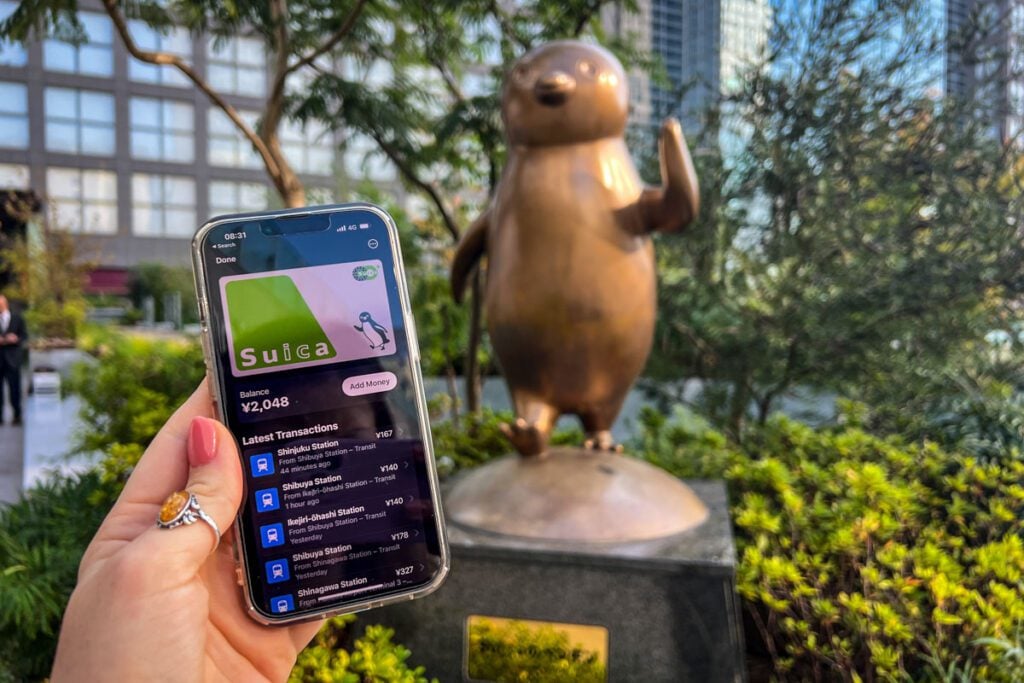
These are essentially the metro cards in Japan ( Suica is for Tokyo and the surrounding area, and ICOCA is for Kyoto/Osaka and the greater Kansai region).
They will save you money on each trip , and are more convenient than having to purchase a ticket each time.
Due to a shortage of physical cards, you are now required to get an app on your phone . Simply tap on and off, eliminating the hassle of purchasing individual tickets. Note that Visa isn’t accepted, so rely on Apple Pay, Mastercard, or American Express for top-ups.
You can use your card for purchases in convenience stores, which is handy when you don’t have cash.
30. Do pack light for Japan
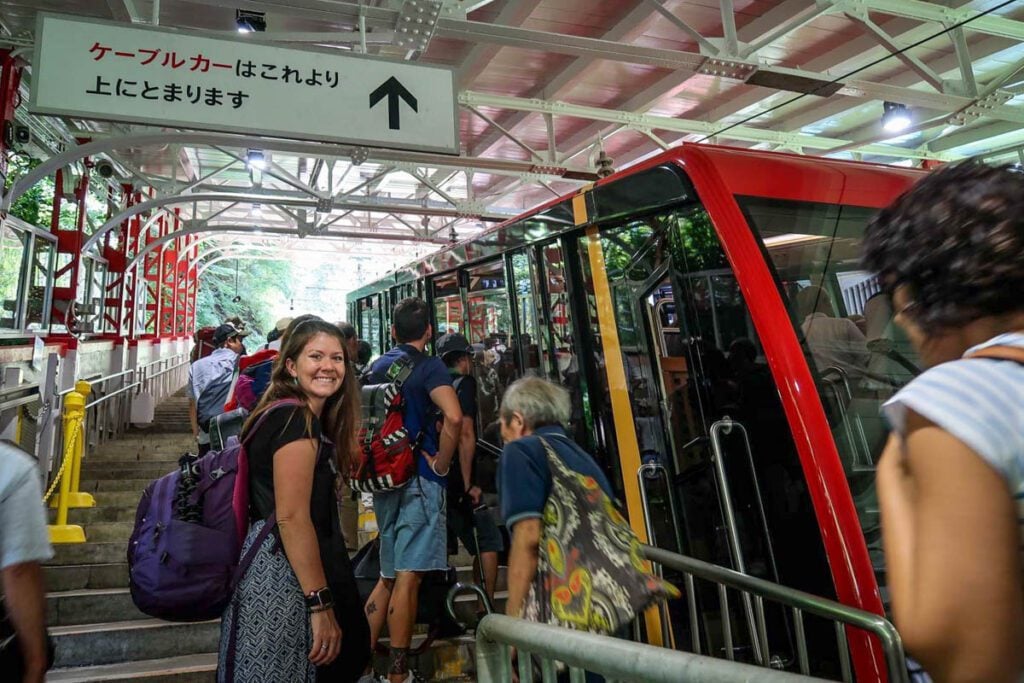
We actually broke this rule, as we had been living in Asia for a year and were in the midst of bringing all our stuff back to the U.S.
But trust me when I say that carrying big backpacks or suitcases through crowded metros, trains and intersections is NOT fun.
We found a luggage transfer service that was able to send the luggage we didn’t need from Osaka to our hotel in Tokyo and store it for us. It was super simple and cheap! I’m sure there are more services out there, but it was a little hard to find when we were searching.
Before you leave, check out these super helpful guides full of packing hacks and tips for traveling in Japan that you won’t find anywhere else:
- Our Japan packing guide lists all the essentials (many of which you might not think about), as well as what you should NOT pack for a trip to Japan.
- This article on what to wear in Japan will help you create a perfect capsule wardrobe for every season and let you in on some cultural taboos so you can be sure to dress appropriately.
- With this FREE Japan packing list PDF download , we’ll send checklists straight to your inbox for everything from clothing and toiletries (for both women and men!) to what shoes to pack and extra stuff you may want to have on-hand just in case. Click the image below to get your free copy!

31. Bring comfortable walking shoes
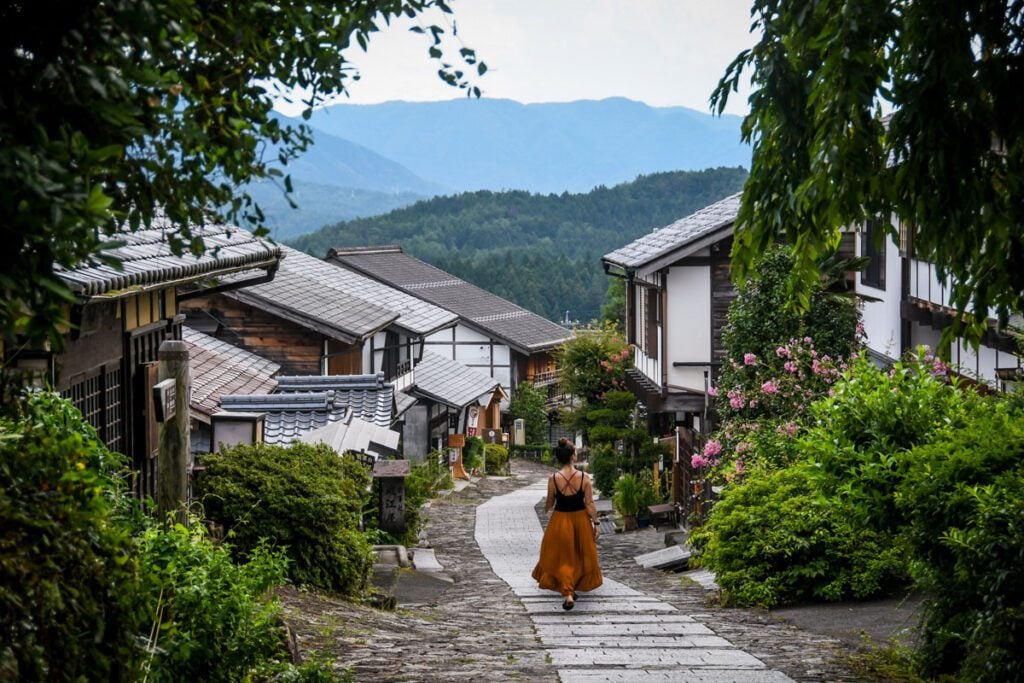
When people say you’ll be walking a lot in Japan, they ain’t lying! We walked an average of 10 miles (16 km) each day, so comfortable shoes are a MUST.
Psst! We have a list of must-see landmarks in Japan that’s sure to give you some inspiration for your itinerary!
32. Know about cover charges at Izakayas
Even though you’re not expected to pay gratuity in izakayas, it’s good to know that many establishments charge what’s called a otōshidai, or a “cover charge”.
Sometimes you’ll be given a small (aka TINY!) dish, otōshi , for which the charge is attributed on your bill. However, it’s really just an extra fee for the seat you are occupying.
Usually it’ll be between 200 – 500 yen. It’s good to expect this so you’re not confused when your final bill comes.
33. Don’t try to split the check
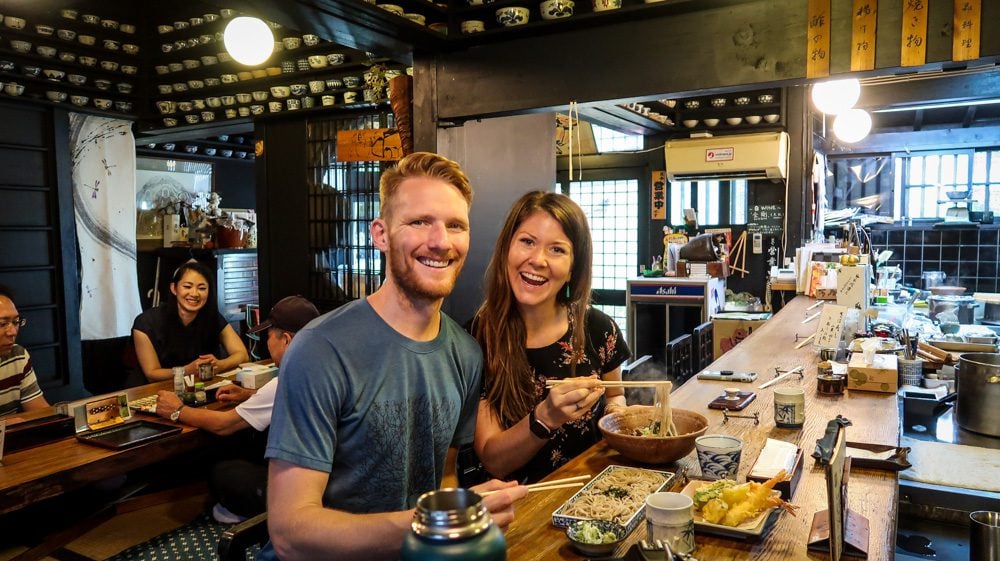
Sometimes when we’re traveling on a budget, we like to split one large meal. Often times, we don’t feel the need to order two full entrees, plus, it cuts our food costs in half.
However, this is usually considered rude in Japan since seating is often limited and you are taking up a spot in the restaurant.
So for instance, it would be frowned upon for two people to go into a ramen shop at a busy hour, and only order one bowl of soup. If one party doesn’t feel like eating, it would be best to wait outside (I know, I know!).
An exception to this would be if you go at an off-hour, say 3 in the afternoon, when a restaurant is less busy. You can ask if it’s okay to split one meal.
We did this once at a restaurant where they served large seafood dishes. The restaurant was pretty much empty in the middle of the afternoon and we just wanted a light meal, not 2 huge entrees. They said it was fine, but I wouldn’t have done this at a busy time of day.
Note: When we say this, we don’t mean you can’t try each other’s meals — we did this ALL the time — and find it the best way to taste as many dishes as possible.
34. Know you can’t see/do everything …
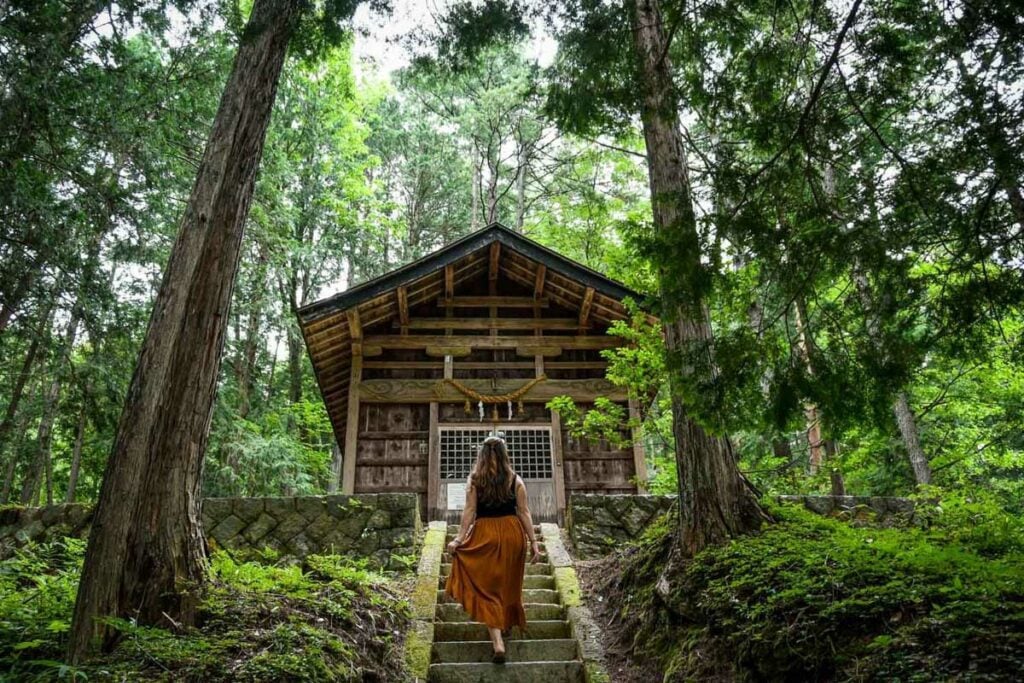
This can be a hard one to come to terms with, especially when you see all sorts of posts and advice. It can honestly get overwhelming (been there!). Just know that you’ll need to narrow down and prioritize the things you really want to do.
If you don’t get to everything — you likely won’t, there are ENDLESS cool things to do in Japan — you can always come back for a second, third, seventh visit down the road.
Need help deciding how long to plan your trip for? Our guide to how many days to spend in Japan will help you figure out how much time you need based on what you want to do.
35. Planning is your friend in Japan

We usually love to travel with a lot of room for flexibility. However, unless you’ve got a lot of time to travel around Japan, planning your route and accommodation in advance is going to help you maximize your time.
Add in some “flexible” time where you can just wander or relax, but our advice would be to come with a pretty solid plan (even if you don’t usually travel this way).
Be sure to check out our ultimate Japan planning guide to help prepare for your trip!
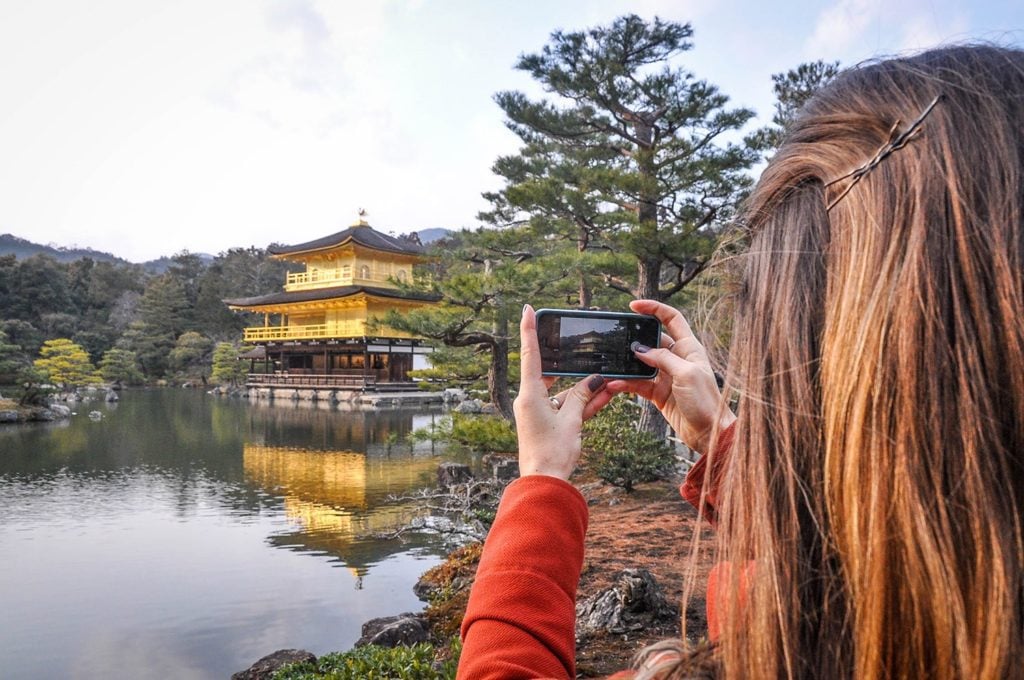
Japan Trip Planner: How to Plan Your First Trip to Japan
This information-packed Japan trip planner has the answers to all your questions. Find out the best places to visit, which Japanese foods to try, and how to ride the bullet trains. All the research is done for you to assist in planning a trip to Japan.
More resources for traveling in Japan
We have TONS of resources on travel in Japan and destinations throughout the country. Check out our Ultimate Japan Travel Guide for all the answers to your most burning questions, or read some of our favorite articles below!
- Best Time to Visit Japan: When to Go & When to Avoid
- Japan Rail Pass: Where to Buy & Is It Worthwhile?
- Renting a Car in Japan: Essential Driving Tips You Need to Know!
- Japan Travel Cost: Exactly How Much is a Trip to Japan?
- Japan on a Budget: Money-Saving Tips + Free Things to Do
- One Week in Japan: Best Itinerary for Your First Visit
- Japan Pocket Wifi vs. Japanese SIM Card: Review & Comparison
- Best Japan Travel Apps
- Foods to Eat in Japan: Guide to Japanese Cuisine
- Helpful Japanese Words & Phrases to Know for Traveling in Japan
Save this article to Pinterest for later!
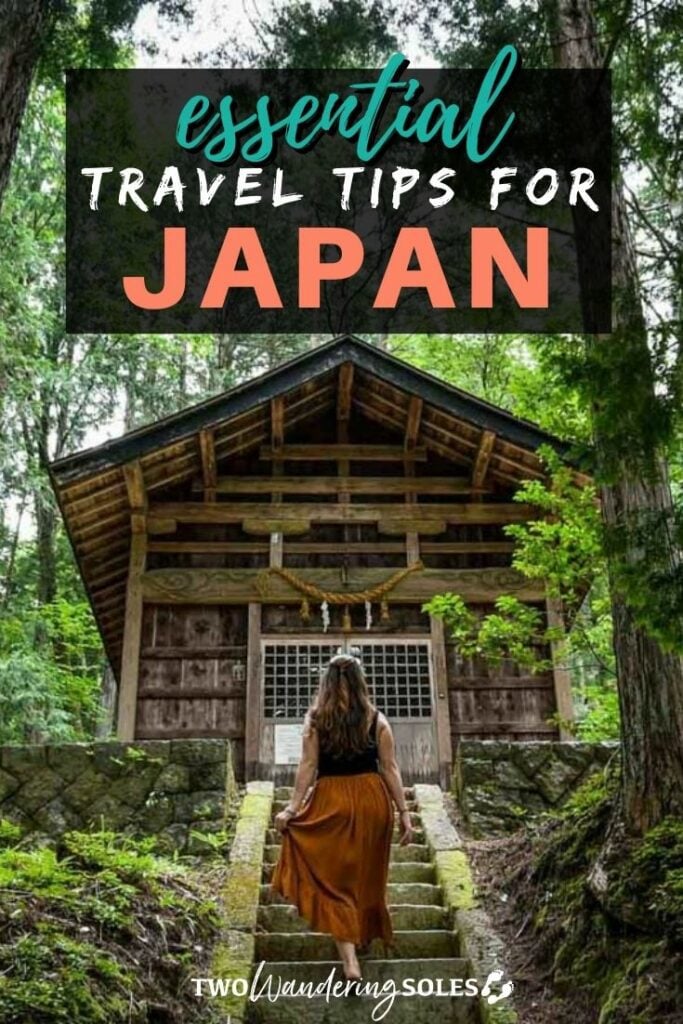
We want to hear from you!
Are any of these tips for visiting Japan surprising to you? Do you have any more Japan travel tips you think we missed? Let us know in the comments below!
Leave a Reply Cancel reply
Your email address will not be published. Required fields are marked *
Save my name, email, and website in this browser for the next time I comment.
- Media & Industry
- Meetings & Events
- Select Language 简体中文 繁體中文(香港) 繁體中文(臺灣) India (English) Bahasa Indonesia 한국어 ภาษาไทย Tiếng Việt Singapore (English) Philippines (English) Malaysia (English) Australia/New Zealand (English) Français Deutsch Italiano Español United Kingdom (English) Nordic countries(English) Canada (English) Canada (Français) United States (English) Mexico (español) Português العربية Japan(日本語) Global (English)
- India (English)
- Bahasa Indonesia
- Singapore (English)
- Philippines (English)
- Malaysia (English)
- Australia/New Zealand (English)
- United Kingdom (English)
- Nordic countries(English)
- Canada (English)
- Canada (Français)
- United States (English)
- Mexico (español)
- Global (English)
- Fujiyoshida
- Shimonoseki
- Ishigaki Island
- Miyako Island
- Kerama Island
- Tokyo Island
- Koka & Shigaraki
- Hida Takayama
- Ginza, Nihonbashi
- Beppu & Yufuin (Onsen)
- Ginzan Onsen
- Nagasaki Islands

- Kumano Kodo
- Shikoku Karst
- Amami Oshima
- Hachimantai
- Omihachiman
- Aizuwakamatsu

- Diving in Japan
- Skiing in Japan
- Seasonal Flowers in Japan
- Sustainable Outdoors
- Off the Beaten Track in Japan
- Scenic Spots
- World Heritage
- Home Stays & Farm Stays

- Japanese Gardens
- Japanese Crafts
- Temple Stays
- Heritage Stays
- Festivals and Events
- Theater in Japan
- Japanese Tea Ceremony
- Cultural Experiences in Japan
- Culture in Japan

- Local Cuisine Eastern Japan
- Local Cuisine Western Japan
- Local Street Food
- Japan's Local Ekiben
- Japanese Whisky
- Vegetarian and Vegan Guide
- Sushi in Japan Guide
- Japanese Sake Breweries

- Art Museums
- Architecture
- Performing Arts
- Art Festivals
- Japanese Anime and Comics
- Japanese Ceramics
- Local Crafts

- Scenic Night Views
- Natural Wonders
- Theme Parks
- Samurai & Ninja
- Iconic Architecture

- Wellness Travel in Japan
- Japanese Ryokan Guide
- A Guide to Stargazing in Japan
- Relaxation in Japan
- Forest Bathing (Shinrin-yoku)

- Experiences in Japan
- Enjoy my Japan
- National Parks
- Japan's Local Treasures
- Japan Heritage
- Snow Like No Other
- Wonder Around Japan

- Visa Information
- Getting to Japan
- Airport Access
- COVID-19: Practical Information for Traveling to Japan
- Anime Tourism
- Countryside Stays
- Accessible Tourism
- Hokkaido Great Outdoors
- Scenic World Heritage in Tohoku
- Shikoku’s Nature and Traditions
- Southern Kyushu by Rail

- Traveling by Rail
- How to Travel by Train and Bus
- JR Rail Passes
- Scenic Railways
- Renting a Car
- Sustainable Travel in Japan
- Travel Brochures
- Useful Apps
- Online Reservation Sites
- Eco-friendly Accommodation
- Luxury Accommodations
- Traveling With a Disability
- Hands-free Travel
- How to Book a Certified Tour Guide
- Volunteer Guides
- Tourist Information Center

- Japanese Manners
- Spring in Japan
- Summer in Japan
- Autumn in Japan
- Winter in Japan
- Cherry Blossom Forecast
- Autumn Leaves Forecast

- Japan Visitor Hotline
- Travel Insurance in Japan
- Japan Safe Travel Information
- Accessibility in Japan
- Vegetarian Guide
- Muslim Travelers
- Safety Tips

- JAPAN Monthly Web Magazine
- Arts & Cultures
- Nature & Outdoor
- Festivals & Events
- Insider Blog
- Things to do
- Local Guides
- Food & drink
- Traditional
- Hokuriku Shinetsu

My Favorites
${v.desc | trunc(25)}
Planning a Trip to Japan?
Share your travel photos with us by hashtagging your images with #visitjapanjp

STORY Top 10 Japan Travel Hacks 10 hacks to make traveling in Japan a breeze
- Stories & Guides
- Top 10 Japan Travel Hacks
Visiting Japan can be daunting with its sheer density and complexity — utilize these 10 tips for a smoother experience
A lot of tourists come to Japan with little idea of the available conveniences that can make traveling much easier. From coin lockers to manga cafes, these hacks are invaluable for making a more manageable trip.
1. Convenience Stores

These are one-stop-shops for all your instant food and drink needs. With thousands of stores spread throughout Tokyo, the nearest one is usually no further than a few blocks away. Open 24/7, they offer ATM services, alcohol and cigarettes, printers and copying machines, as well as restrooms at certain locations.
2. Train apps
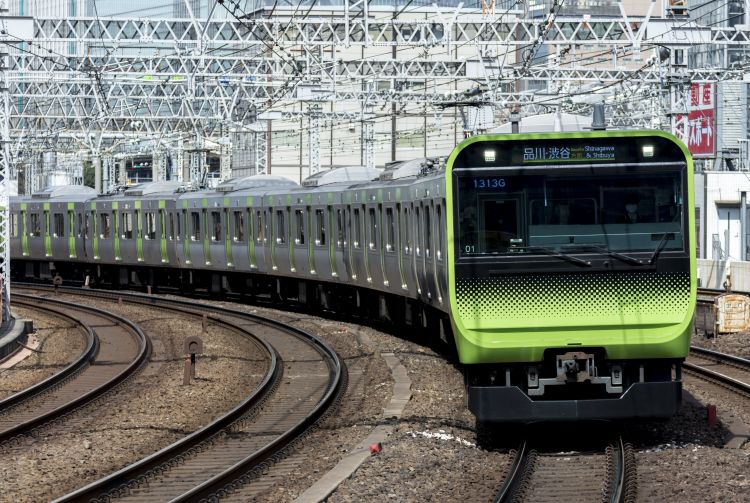
Use one of the many train schedule apps available to help you navigate Japan's public transportation system. From Hyperdia to Jorudan, most of the apps allow you to input a departure time or arrival time, and give you tons of options for transfers and routes.
3. Train cards

Trying to buy the right-priced train ticket for fare in Japan can be a hassle. Avoid any potential stress by buying a Pasmo or Suica train card, which allows you to charge set amounts of cash that will be automatically deducted as you travel from station to station. Charge up your card at any station — an initial 500 yen deposit is required — and you are good to go. These cards are becoming increasingly useful as vending machines, convenience stores and more are starting to accept them.
4. One-day metro passes
5. manga cafes.
Known as net cafes or manga cafes, these spaces allow you to rent tiny personal rooms with access to all-you-can-read manga comics, drink machines and depending on the location, pay-to-use shower rooms. While the rooms are only semi-private (they're interconnected and have relatively low walls), these establishments offer the cheapest way to sleep and get a quick shower without having to make a reservation.
6. Love Hotels
All of Japan's major cities generally have a number of “love hotels” situated near big stations. Don't be put off by the name, they can just as easily be used by single or couple travelers looking for a more interesting hotel option. With themed rooms, jacuzzis and more, these establishments are only rentable on a same-day basis. Although you might find them fully booked on weekends, on weekdays they provide a reliable and often cheap place to stay.
7. Coin Lockers

You'll notice that nearly every station and many department stores are equipped with walls upon walls of coin lockers. Costing between 200 and 900 yen, they offer temporary storage for those on day-trips and are ideal if you've just finished a shopping spree, but want to see more of the sights. Be careful though, the daily rental period for many coin lockers lasts until the date changes. After that, you will be charged extra for overtime.
8. Kuroneko Yamato
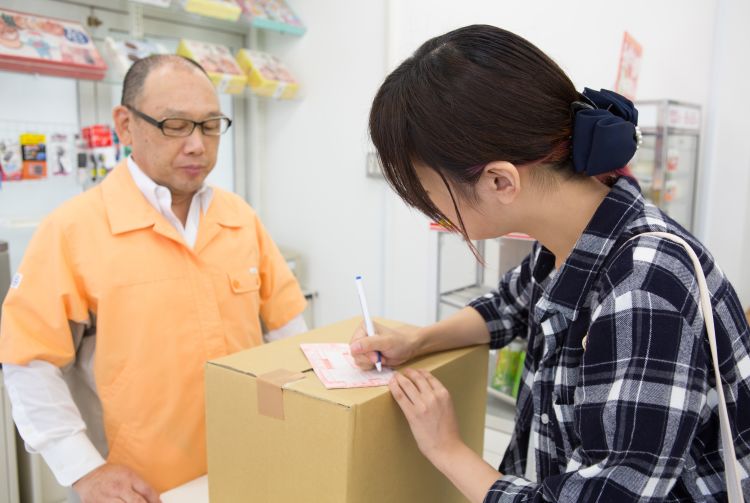
If you can't fit everything in your baggage, use Kuroneko Yamato's delivery service to send packages back home. Conveniently located in the airport and at many other locations — including convenience stores — they have reasonable prices and offer a straightforward service.
9. Koban (police boxes)

Police are often stationed in outposts called koban, or police boxes. These are usually near stations, or other high-traffic areas, and can be used for more than just reporting crime. Nearly all police officers in Japan are trained to memorize the area around their jurisdiction, and as such are often the first people locals approach to ask for directions. While there is no guarantee they'll have English speaking ability, they can generally get you going in the right direction with gestures and maps.
10. Rental bicycles

While not as developed for cyclists as some other countries, rental bicycles are generally available around major tourist hubs in Japan. These bikes are a cheap way to explore, letting you go off the main paths while staying green and burning a few calories. Most of Japan's major cities will have designated bicycle rental stores. Research the options before your trip begins.
The latest information may differ, so please check the official website
- Story & Guide
- Travel Tips
Did this information help you?
out of found this information helpful.
Thank you for your feedback.
Recommended for you.

Please Choose Your Language
Browse the JNTO site in one of multiple languages
- Meet the Team
- Work with Us
- Czech Republic
- Netherlands
- Switzerland
- Scandinavia
- Philippines
- South Korea
- New Zealand
- South Africa
- Budget Travel
- Work & Travel
- The Broke Backpacker Manifesto
- Travel Resources
- How to Travel on $10/day
Home » Budget Travel » 27 Japan Travel Tips You NEED to Know! • 2024
27 Japan Travel Tips You NEED to Know! • 2024
Japan! With over 14,000 islands, the Land of the Rising Sun is truly a place of mystery. This is where the traditions of the past gone ages graciously dance with the bustling craziness of the present.
Here you’ll find ancient villages living in harmony with skyscrapers and futuristic tech. This is the birthplace of anime, home to sushi perfection, and a land of mystical mountains and tropical island dreams.
What truly makes Japan special is its culture – it stands strong and is utterly unique, drawing travelers from far and wide. But, for first-time travelers, Japan can be a tad perplexing, occasionally intimidating, and even rather overwhelming.
In October 2023, I spent over a month backpacking and hitchhiking across this wonderful country, so fear not, friends… I’ve compiled the ULTIMATE list of 27 Japan travel tips that I wish I’d known before setting foot in this enchanting world.
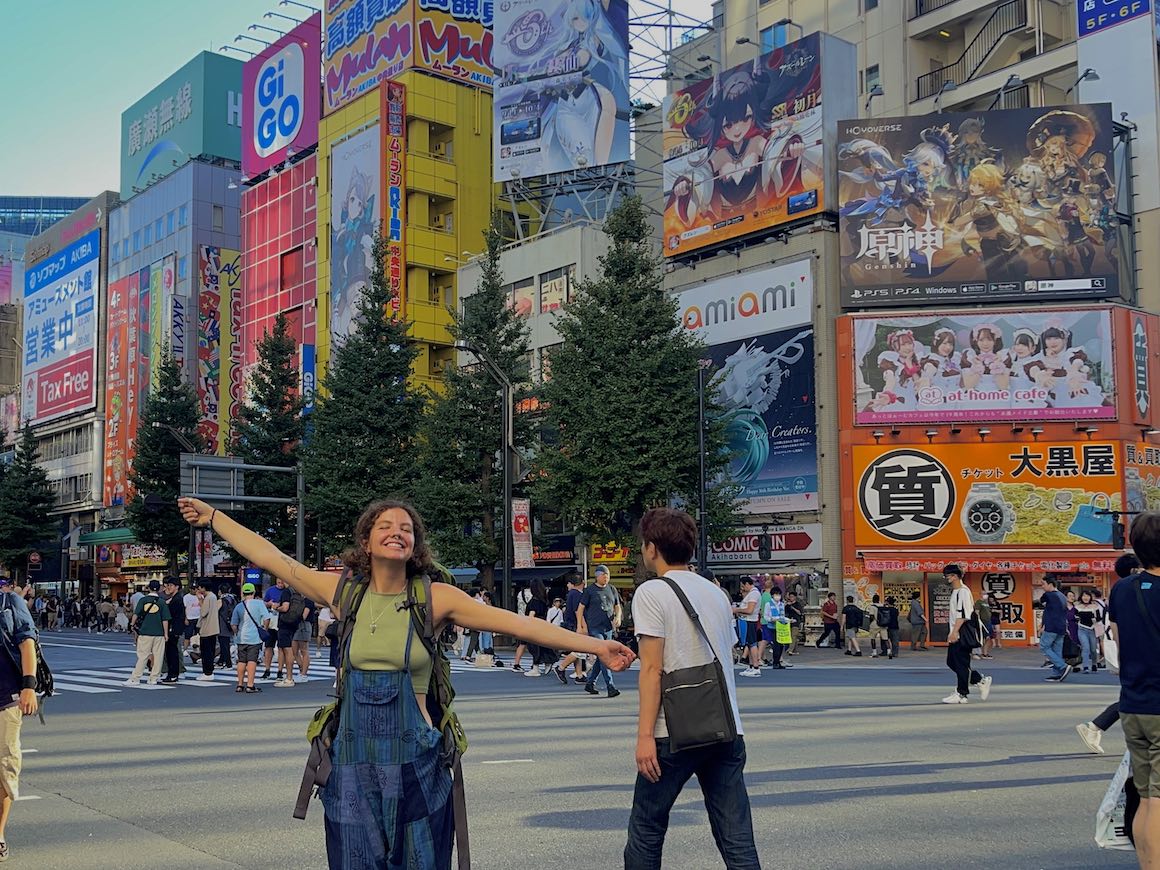
Do You Want to Travel FOREVER??
Pop your email in below to get a FREE copy of ‘How to Travel the World on $10 a Day!’.
1. Think About Hitchhiking
2. get an ic card – godsend, 3. try staying at k’s house hostels, 4. your ultimate japan travel tip: don’t tip, 5. trash disposal, 6. carry cash, 7. be prepared to walk…. a lot, 8. invest in a cultural experience, 9. before you go, get familiar with the language, 10. shhh-inkansen, 11. travel during off-season, 12. chopstick etiquette: pro japan travel tip, 13. don’t order too much food, 14. eat your breakfast at the convenience stores, 15. japan is not all sushi and ramen, 16. being vegan is difficult in japan, 17. try to make it to one of japan’s festivals, 18. get a japan rail pass, 19. understand japanese religions, 20. always travel with insurance, 21. head to the ocean, 22. and don’t forget about the mountains, 23. you can drink the tap water, 24. amazingggg public bathrooms, 25. onsen etiquette, 26. get pocket wi-fi or a sim card.
We all know something that holds people back from traveling to Japan is the cost . But the main cost of backpacking in Japan is actually the transportation. So why not make it free, stick it to your thumb, and see how it goes?
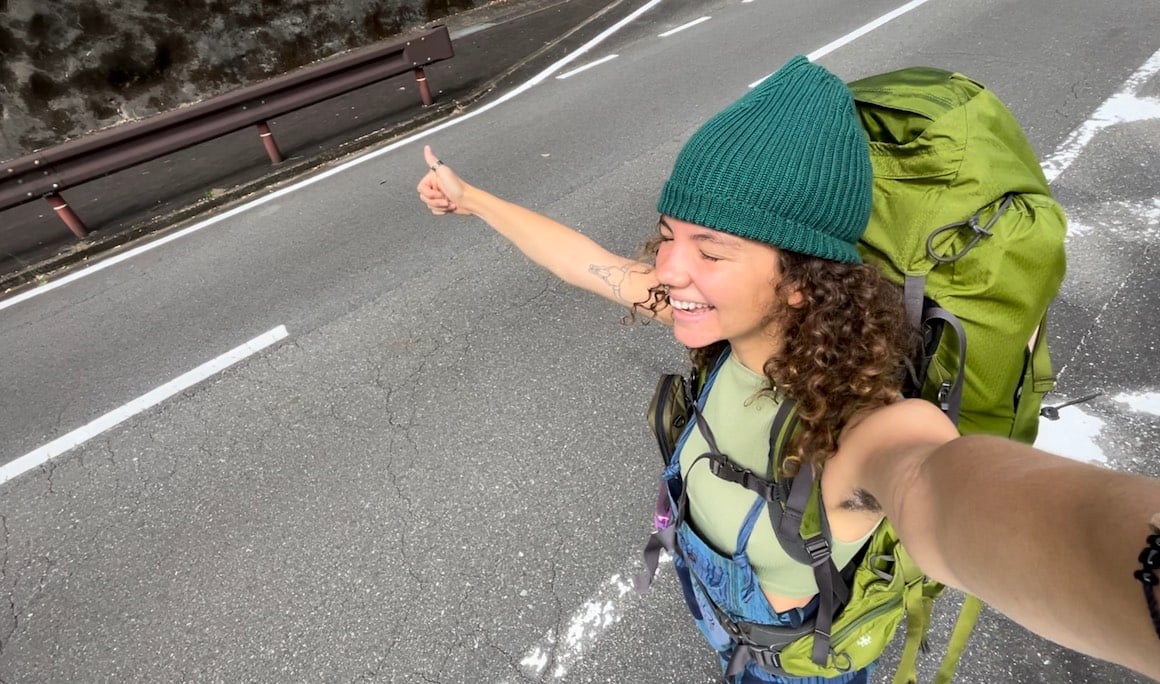
I was pleasantly surprised by how smooth it was to hitchhike as a woman here. I made new friends, learned more of the language, and saw places public transport never could have taken me. Even more remarkable is how my perspective on the Japanese people has deepened.
Japan is a very safe place to travel, which makes it a wonderful place to begin your hitchhiking journey.
This Japan travel tip is a GAME-CHANGER. I can’t believe I spent a week backpacking in Japan without one, grappling with the confusing ticket machines EVERY TIME I tried to take the subway.
Trust me, grab an IC card like Suica, Pasmo, or Icoca.
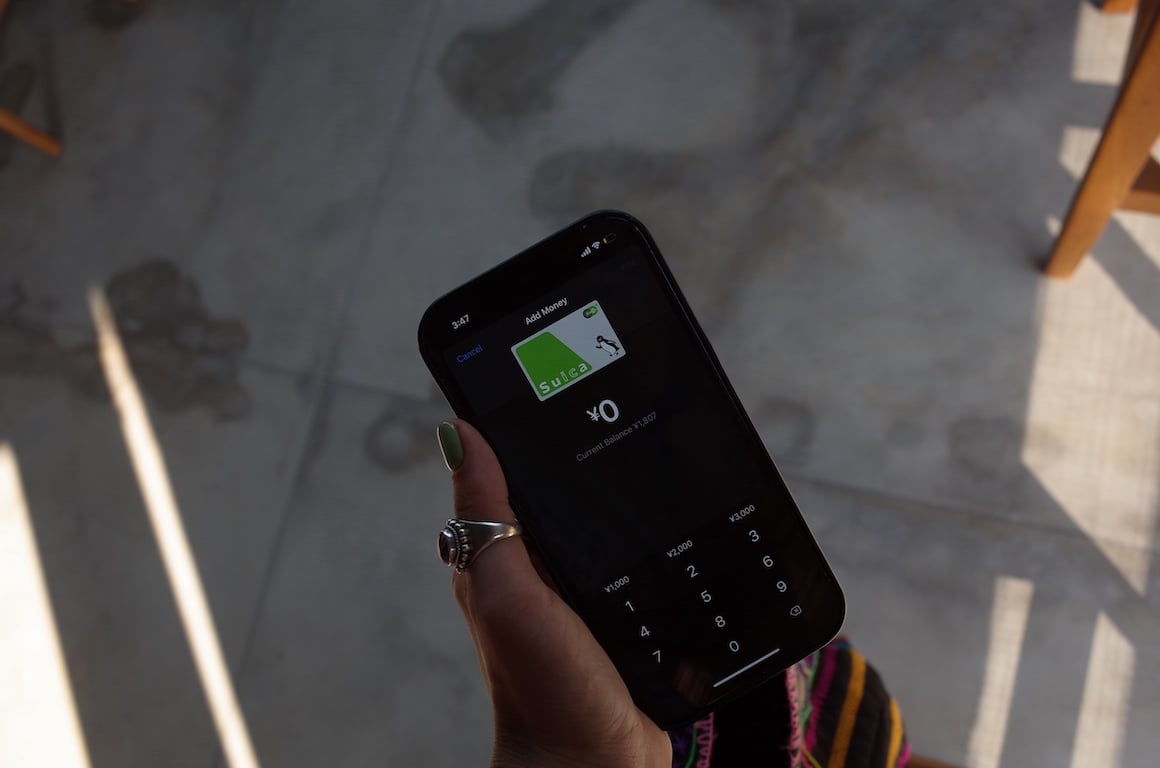
You can add them to your Apple Wallet in a matter of seconds. Just tap when you enter and tap again when you exit, and your fare is automatically deducted.
You can use them at convenience stores and some grocery stores too which is great if your debit card has foreign transaction fees.
K’s House Hostel is a hostel chain in Japan. Unlike other hostel chains, where they’re exact replicas of each other just in different locations, this hostel chain caters to each hostel’s surroundings and local culture.
Some are renovated 150-year-old Japanese buildings, while others are normal homes in lakeside neighborhoods.
But one thing they all have in common is a very friendly atmosphere, freshly brewed coffee in the mornings, and clean shared kitchens.
If you stay at K’s house repetitively, you get a 10% discount, which really adds up for budget travelers looking for where to stay in Japan !
Tipping is generally not practiced or expected in Japan, it can actually be seen as unusual, awkward, or even rude.
The reason behind this is deeply rooted in Japanese culture, where service is considered an integral part of the job and employees take pride in providing excellent service as part of their duty.
Tipping could imply that the staff isn’t paid well enough. Instead, expressing gratitude with a simple “arigatou gozaimasu” (thank you) is appreciated.
Japan’s limited public trash disposal system can be a bit puzzling for newcomers, especially for me when I started my journey backpacking in Tokyo and couldn’t find a bin for the life of me…
The reason for this? Well, it’s largely due to the Japanese culture of personal responsibility.
People are expected to take their trash home with them and sort it meticulously into categories like burnable, non-burnable, and recyclables.
Then wash it before putting it in the relevant trashcan. It’s all about minimizing waste and maintaining clean public spaces.
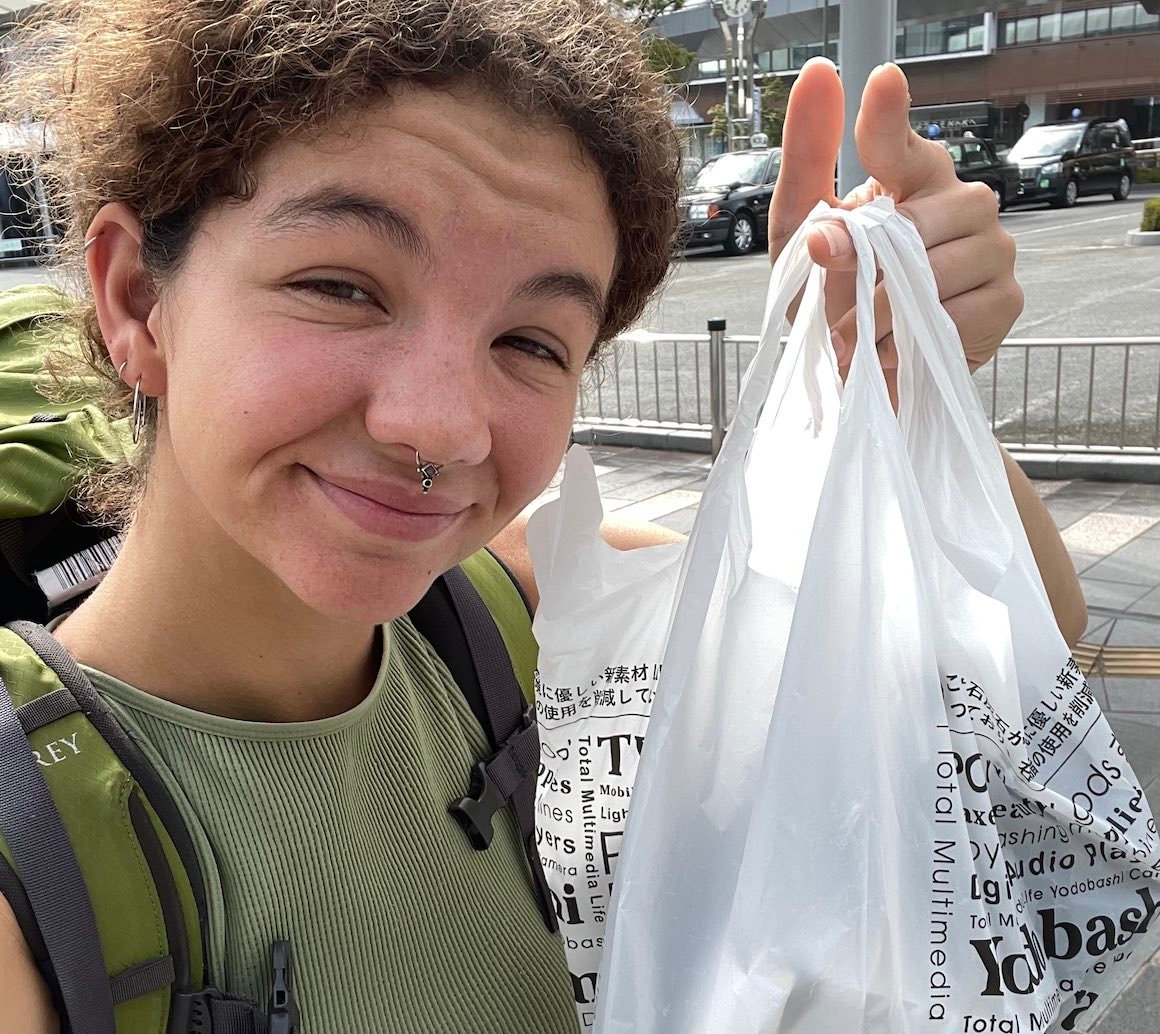
So, while you might struggle to find public trash bins, remember that it’s a shared commitment to environmental cleanliness, and it’s a small price to pay for Japan’s pristine streets and parks.
My perspective on this changed from annoyance and frustration to respect and gratitude when I learned about the reason behind having no trash cans on the streets.
If you really need to throw away the trash, there are normally bins in 7/11 or Lawson’s . Keep this Japan travel tip for future reference. 🙂
Japan is a very cash-centric place. Always carry some cash with you, as some restaurants and shops don’t accept cards. While in bigger cities like Tokyo, this is changing quickly, rural areas seldom accept cards.

Drink water from ANYWHERE. The Grayl Geopress is the worlds leading filtered water bottle protecting you from all manner of waterborne nasties.
Single-use plastic bottles are a MASSIVE threat to marine life. Be a part of the solution and travel with a filter water bottle. Save money and the environment!
We’ve tested the Geopress rigorously from the icy heights of Pakistan to the tropical jungles of Bali, and can confirm: it’s the best water bottle you’ll ever buy!
Whilst there is public transport in Japan, bring a good pair of walking shoes because you’ll be walking everywhere. I walked AT LEAST 5-10 km a day. Even walking to and from subway stations or bus stops can add an extra 1-2 km.
I also HIGHLY recommend bringing a foldable day pack. I traveled with the Nomatic packable daypack #1, and it was perfect for wandering around with.
This is good, though, as you’ll work up an appetite and have room for more sushi. Japan travel hack, guys!
An absolute HIGHLIGHT of my time in Japan was spending a couple of hours learning all about Samurai culture!
MANY dojos offer touristic samurai experiences, however, only a handful are the real deal, and I strongly recommend doing your research. The school we went to was amazing, I trained with a Samurai master with over 20 years of experience.
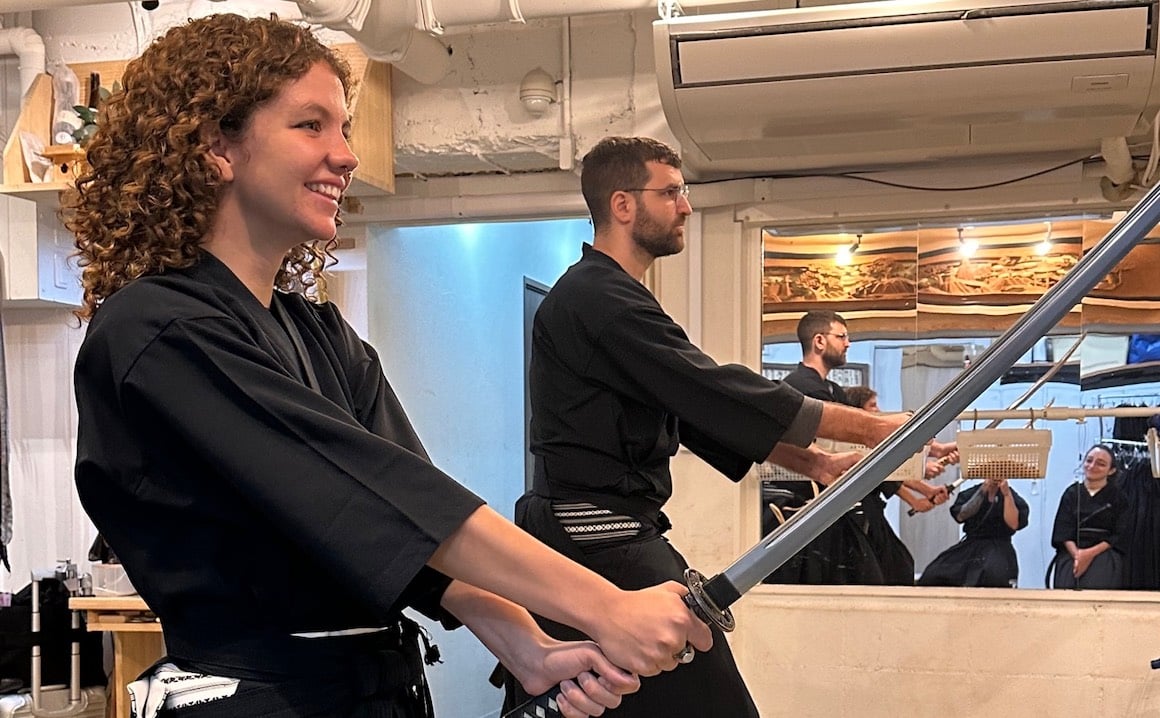
You’ll learn the fascinating history of the samurai as well as the proper techniques to hold the sword, attack your foes, and defend yourself.
At the end of the class, you’ll have the chance to slash and decapitate some rolled-up reed mats; a really thrilling ending. As a girl who isn’t always as stoked on swords as my guy friends, I wasn’t sure if I would particularly enjoy this, but it was a really powerful experience, and I highly recommend it.
Japan can be one of the trickiest places to travel in terms of the language barrier. Japanese people generally don’t speak much English and also tend to speak Japanese pretty quickly!
Learning some of the language before you arrive in Japan is a good idea . Not only will this lessen the number of awkward Google translate exchanges, but it will also allow you to experience the country much more INTIMATELY.
Here are some of my favorite/most useful words I picked up while in Japan:
- Gochisousama deshita (Goh-chee-soh-sah-mah deh-shee-tah) is a Japanese phrase used after finishing a meal to express gratitude. It’s a way to say, “Thank you for the meal” or “It was a feast.” It’s a polite way to acknowledge the person who prepared the food and the restaurant staff.
- Itadakimasu (Ee-tah-dah-kee-mahs) is said before beginning a meal in Japan to express gratitude for the food, the animals who were sacrificed to make the food, and the people who prepared it.
- Arigatou gozaimasu (Ah-ree-gah-toh goh-zai-mahs) = Thank you
- Onegaishimasu (Oh-neh-gah-ee-shee-mahs) = Please
- Sumimasen (Soo-mee-mah-sen) = Excuse me/Sorry
- Osusume? (Oh-soo-sue-meh) = What’s your recommended dish? ( Perfect for when you can’t read the menu and have no idea what order to place )
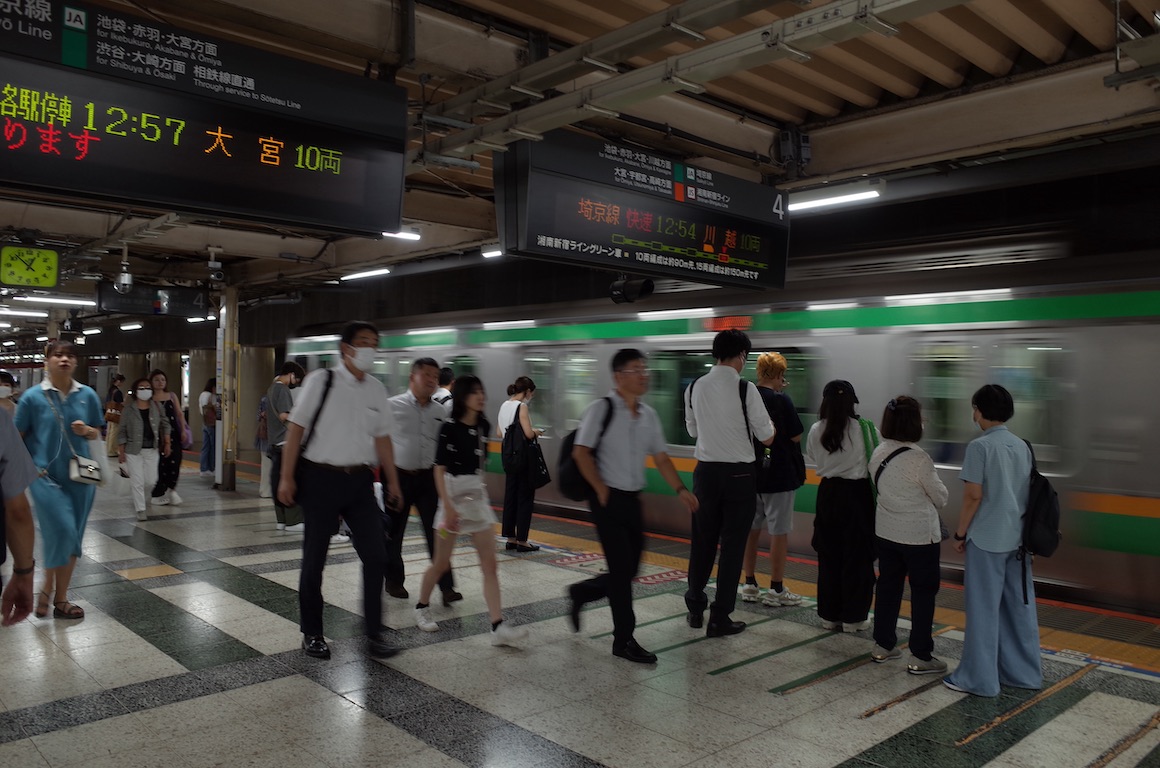
Japanese public transport is insanely quiet, especially the Shinkansen bullet trains. Even when the trains are packed shoulder-to-shoulder full of people, it’s still dead silent.
Guys, take note of this Japan travel tip: DO NOT answer phone calls on a bus or train, and do not speak and laugh super loudly with your friends . There is signage in most stations and inside trains to remind passengers of this.
Japan is well known for its cherry blossoms and fall foliage. It’s beautiful! But if you want a more budget adventure , try traveling during the summer or winter, as there are far fewer crowds and prices decrease significantly.
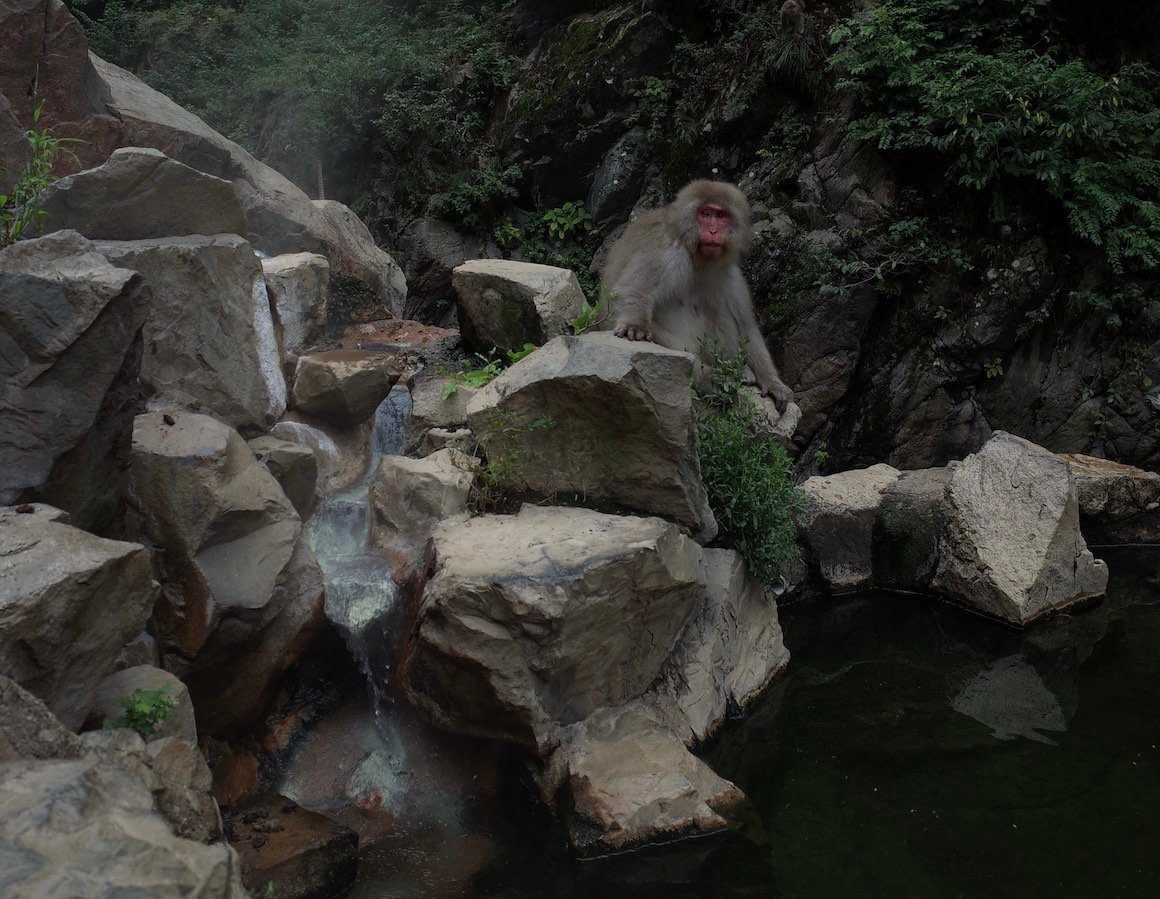
In the summer, there are vibrant festivals throughout the country, such as Gion Matsuri in Kyoto and Tanabata festivals.
December, January, and February are the absolute best times to explore Japan . In winter, you can check out skiing and snowboarding in regions like Hokkaido and Nagano . Warm up in traditional hot spring baths (onsens) while surrounded by snow.
In Japan, it’s a good idea to avoid sticking your chopsticks upright in a bowl while chowin’ down . Now, that’s one chopstick etiquette I wish I knew before travelling to Japan.
This practice has some eerie ties to funeral rituals and can give off an uncomfortable vibe for those around you. It’s about more than just etiquette; it can also come across as a lack of respect for the chef who prepared your meal.

Even Shintoism, which has its say in these matters, frowns upon this practice. It can be seen as disrespecting the spirits who inhabit the rice.
To keep things cool and culturally sensitive, just pop your chopsticks flat on a rest or the edge of your plate when you’re not using them. It’s a simple Japan travel tip that goes a long way, and I wish I’d known sooner.
Archive this Japan travel tip for later: Order with your stomach, not your eyes!
Not finishing your food is looked down upon in Japan. It implies wastefulness, a lack of appreciation for the chef’s efforts, and a disregard for portion sizes.
To show cultural sensitivity, it’s best to try to finish your food. Even if you can’t, make sure you still express gratitude for the meal’s deliciousness. Remember, you can always order more!
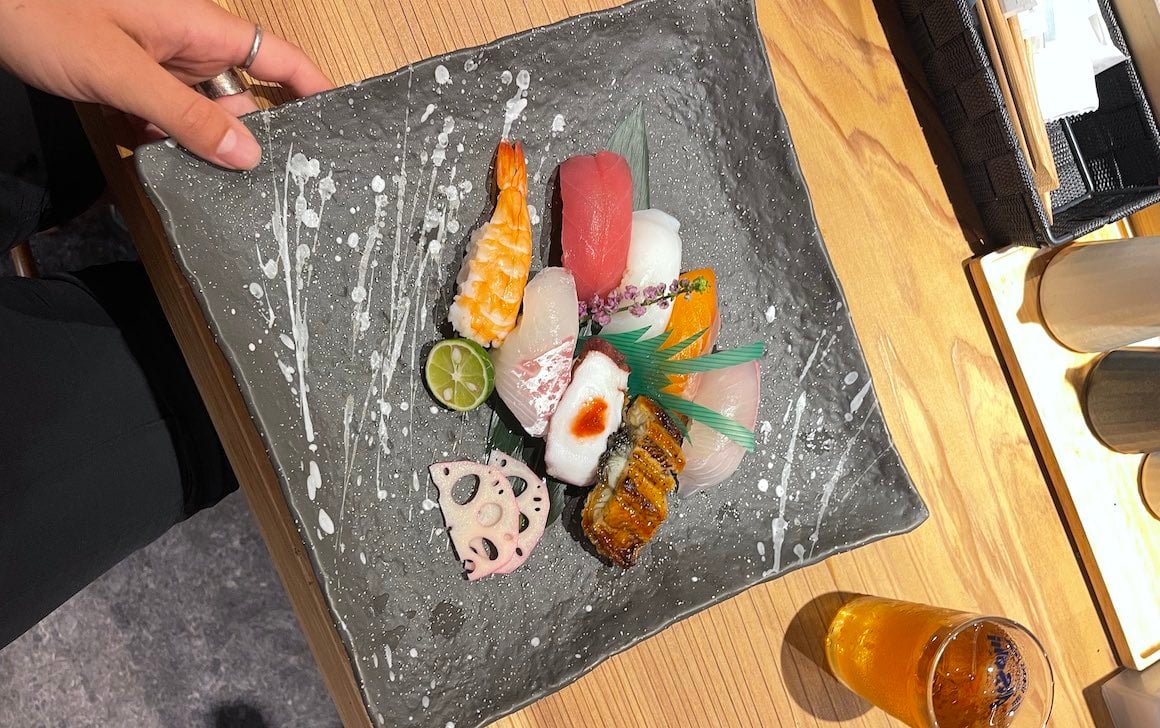
One of the things to know when traveling to Japan is that stores like 7/11 and Lawson have very yummy and budget-friendly options for breakfast.
You can have egg sandwiches and onigiri (Japanese rice balls). They also have coffee machines with lattes, which cost only $1.00.
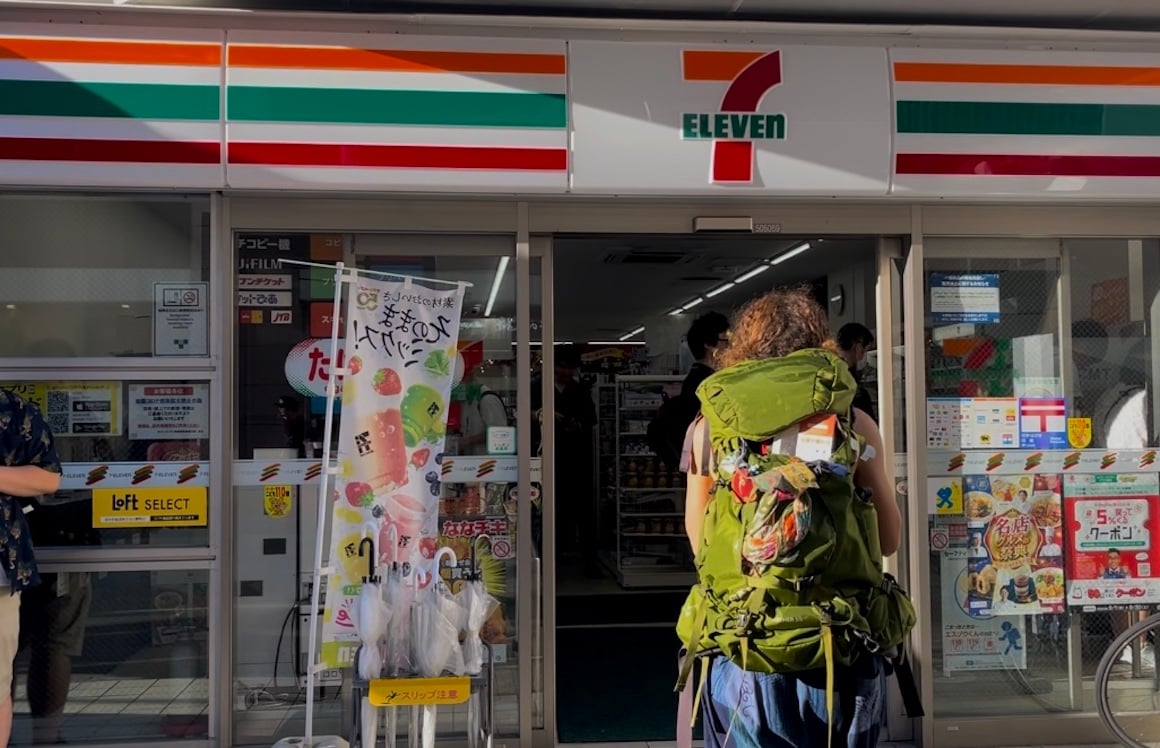
Many budget travelers choose this as an easy and convenient breakfast. I was so surprised at the delicious quality of the food at these stores compared to the ones in the US or Europe.
I thought I would be eating sushi and ramen every day in Japan, but I was pleasantly surprised by the variety of food Japan offers.
Make sure to eat other noodle dishes like Soba or Udon. Or try the yummy Yakitori, famous meat skewers in Tokyo, if you’re looking for something quick.

If you are looking for things to do in Osaka , try taking a street food tour and eating some Okonomiyaki and Takoyaki !
For vegans, Japan can present some challenges, as the country’s traditional foods rely heavily on seafood and meat. Even seemingly plant-based dishes can often contain hidden animal ingredients, like fish stock or bonito flakes.
Ingrained in Japanese culture is a strong emphasis on hospitality and tradition, making it sometimes tricky to request special considerations.
While exploring places like Kyoto or Tokyo, they may have more vegan-friendly options. But they will still be more limited compared to Western countries, although this is improving as time goes on.
Attending a Japanese festival can be an amazing way to experience the culture more intimately, get a glimpse into the past, eat amazing food, and see parts of Japan you never normally would.
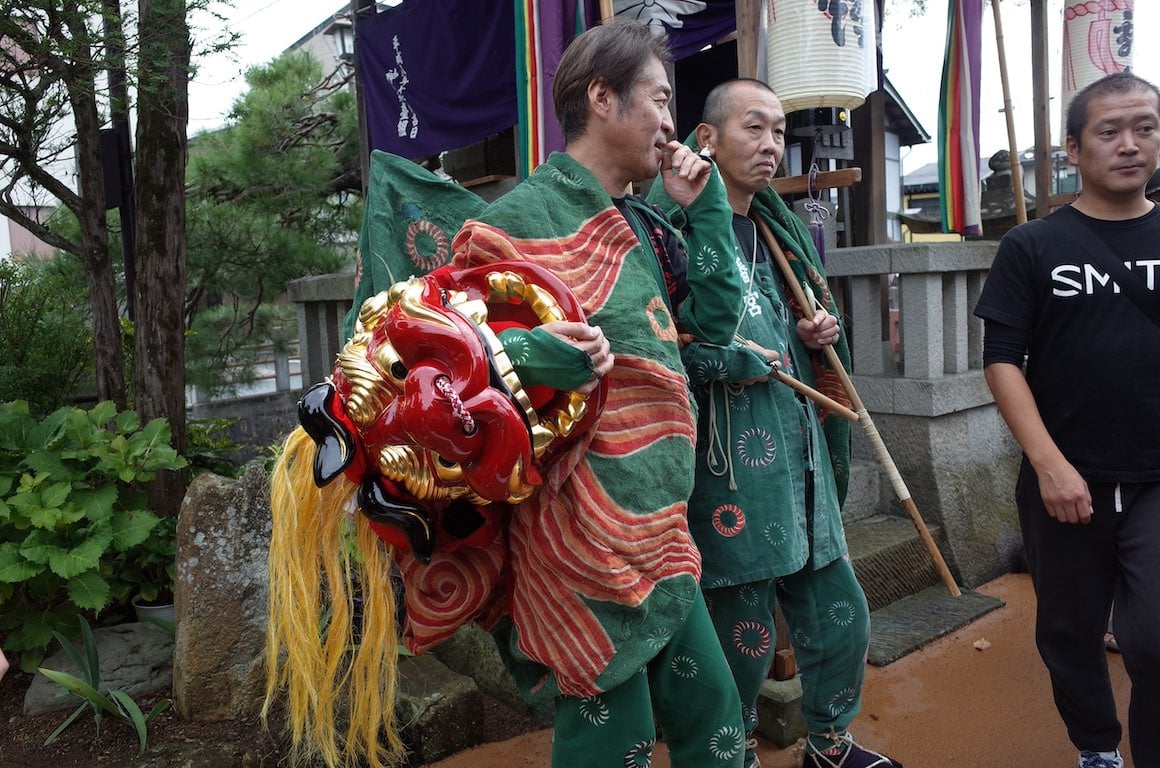
Try to see if you can incorporate any of these incredible festivals in Japan into your itinerary.
- Cherry Blossom Festivals: Celebrated in spring all over the country, these festivals honor the cherry blossoms with picnics and light-up events.
- Gion Matsuri: This is one of Japan’s most famous and grandest annual festivals. It is held in Kyoto in July and features a beautiful parade of traditional floats
- Tanabata (Star Festival): Celebrated on the 7th day of the 7th month every year, locals decorate bamboo trees with strips of paper, with wishes written on them.
- Gion Kobu Geiko and Maiko Dances : Here you can see Geishas perform beautiful dances all around Kyoto, a truly once-in-a-lifetime experience.
- Sapporo Snow Festival: For a whole week, Hokkaido becomes decorated with crazy, elaborate snow and ice sculptures
- Takayama Festival: This Japanese town in the mountains becomes full of floats, music, and food and celebrates the coming of spring and autumn.
The Japan Rail Pass can be the ultimate budget hack for traveling around Japan. With this, you get unlimited access to all JR lines for 1, 2, or even 3 weeks, depending on what you choose.
Armed with your trusted JR Pass, you can crisscross the entire country and use it to navigate big cities like Tokyo as well.
However, be sure to crunch the numbers and see if it’s cost-effective for the journeys you have planned, especially with the recent price hike (up by 70%!) in October 2023 .
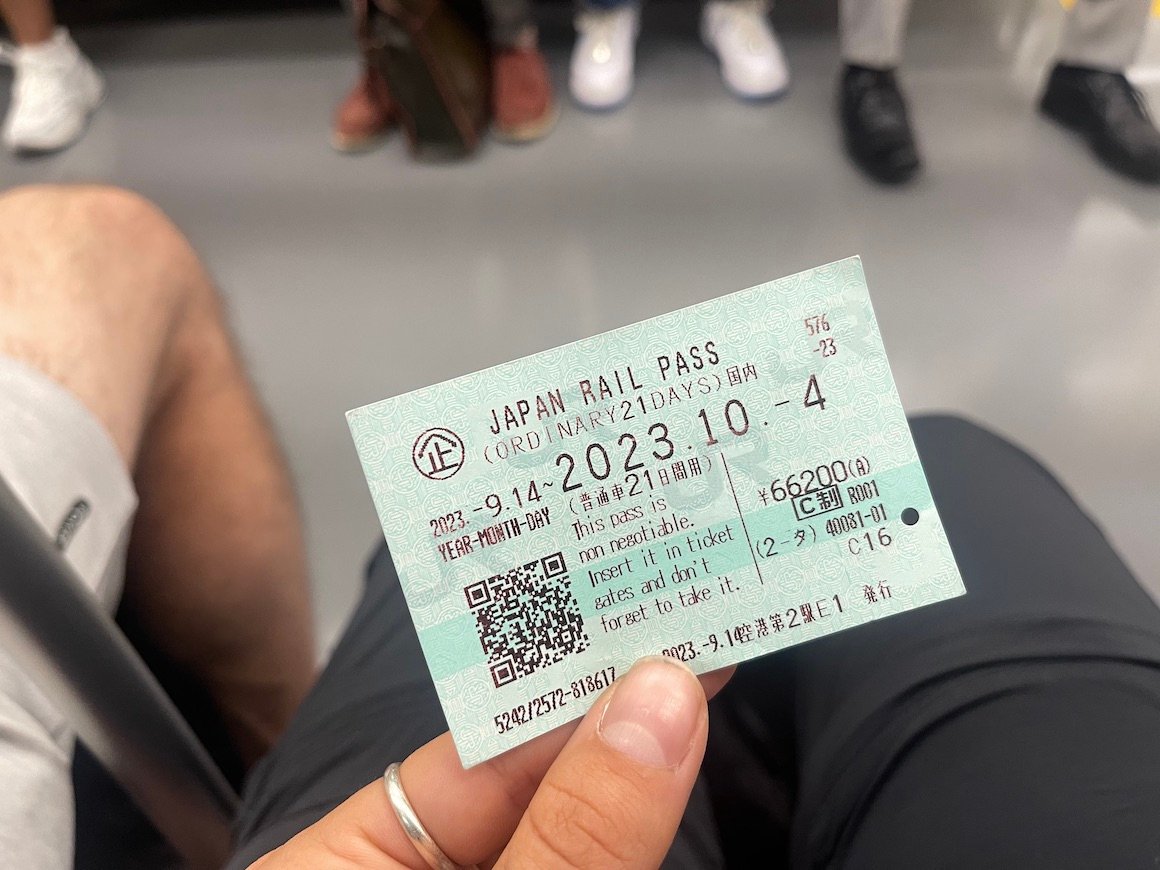
If you plan on making multiple longer journeys, it’s likely a money-saver. You should try to order one ahead of time, and it will get shipped to your house.
But if you’re like me and don’t really have an address to ship to, you can pick it up at a JR ticket office at bigger stations across the country.
It’s important to educate yourself on the difference between shrines and temples , as it’s easy to group them together or assume they are the same.
Shrines, known as “jinja,” are places of Shinto worship and often have a Torii gate at their entrance. They are associated with Japan’s indigenous Shinto religion which focuses on kami (spirits).
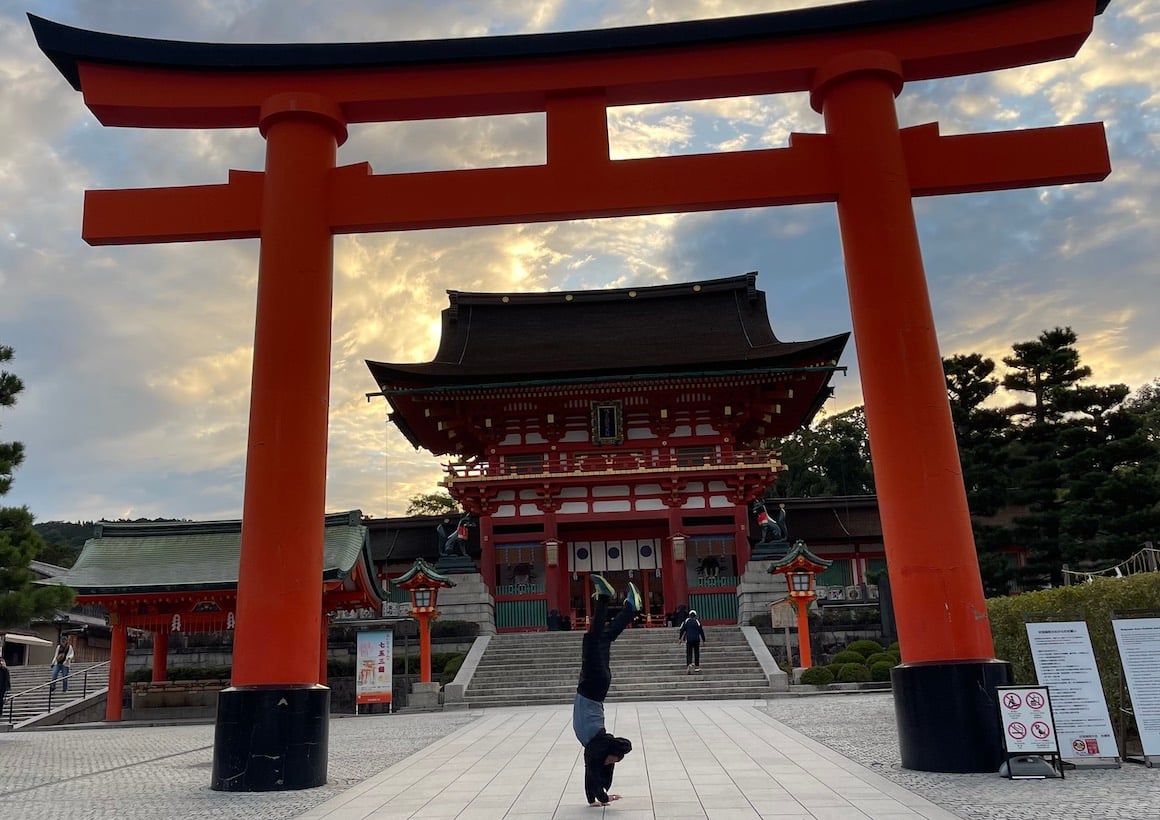
They normally have the word “shrine” at the end of the name, which is an easy way to identify them. Temples tend to utilize the suffixes “ji,” “in,” “tera” or “dera” at the end instead.
Some good examples of these are Asakusa’s Senso-ji, Kyoto’s Kiyomizu-dera, and Miyajima’s Daisho-in. Knowing this difference can help you appreciate the rituals and customs at each site, from clapping at shrines to bowing at temples.
When backpacking, you never know what can happen. While travelling, I’ve had several unfortunate accidents where travel insurance would have saved me so much anxiety and trouble.
From motorbike crashes, food poisoning, ear infections, and broken bones. Take it from me, make your Japan trip anxiety-free and get solid travel insurance .
ALWAYS sort out your backpacker insurance before your trip. There’s plenty to choose from in that department, but a good place to start is Safety Wing .
They offer month-to-month payments, no lock-in contracts, and require absolutely no itineraries: that’s the exact kind of insurance long-term travellers and digital nomads need.

SafetyWing is cheap, easy, and admin-free: just sign up lickety-split so you can get back to it!
Click the button below to learn more about SafetyWing’s setup or read our insider review for the full tasty scoop.
When people think of Japan, the first thing they think of is definitely not amazing waves or pristine beaches. But trust me, the ocean in Japan is MDMAmazing.
Head to the IZU peninsula just south of Tokyo for amazing waves, cute surf towns, some of the best beaches in Japan , or CRAZY scuba diving experiences with hammerhead sharks.

Of course, you can also head to Okinawa , a group of islands in the southern part of Japan known for its coral reefs, unique culture and food, and amazing people.
A lot of people spend their Japanese travels in Tokyo, Kyoto, and Osaka and call it good. But oh boy, they are missing out.
The mountains in Japan attract people far and wide. Whether you’re looking for amazing skiing in the winter, trekking in the summer, amazing fall foliage, or adorable mountain towns, they’ve really got it all.

You can take day trips to the mountains easily from Tokyo to places like Hakone or Nikko , or if you’re feeling more adventurous, head to the Japanese Alps and explore.
You can also trek one of the top 10 pilgrimage routes in the world , the Kumano Kodo, located in the ancient forests of the Kansai regions. This is truly a spiritual experience.
I’m sure everyone knows the dreadful feeling of having to purchase plastic water bottles in places like Southeast Asia, where you cannot drink tap water.
Japan is amazing for this reason, as you can bring your reusable water bottle with you everywhere and just refill it in bathrooms or your hotel room sink .
Environmentally friendly, convenient, and free! Can’t get much better than that.
Here at The Broke Backpacker, we are big fans of Grayl filtration water bottles . You can drink tap water from ANYWHERE when traveling; you can even drink water from puddles… The filter takes care of it.
Speaking of convenience and free, EVERYWHERE you go in Japan, you’ll find clean and lavender-smelling public restrooms. They’re sometimes even adorned with fresh flowers or air fresheners.
It’s incredibly surprising to walk into a bathroom in the middle of the busiest areas of Tokyo, or the most remote areas of the countryside, and be met with a SPOTLESS restroom. One of the few places I’ve been in the world with this luxury, it certainly differs from backpacking in the USA !
Chances are, while you’re in Japan, you’ll at some point find yourself relaxing in an onsen, a traditional Japanese hotspring. But the first time can be a bit intimidating. So here are some pro Japan travel tips and etiquette, so you won’t be as lost as I was.
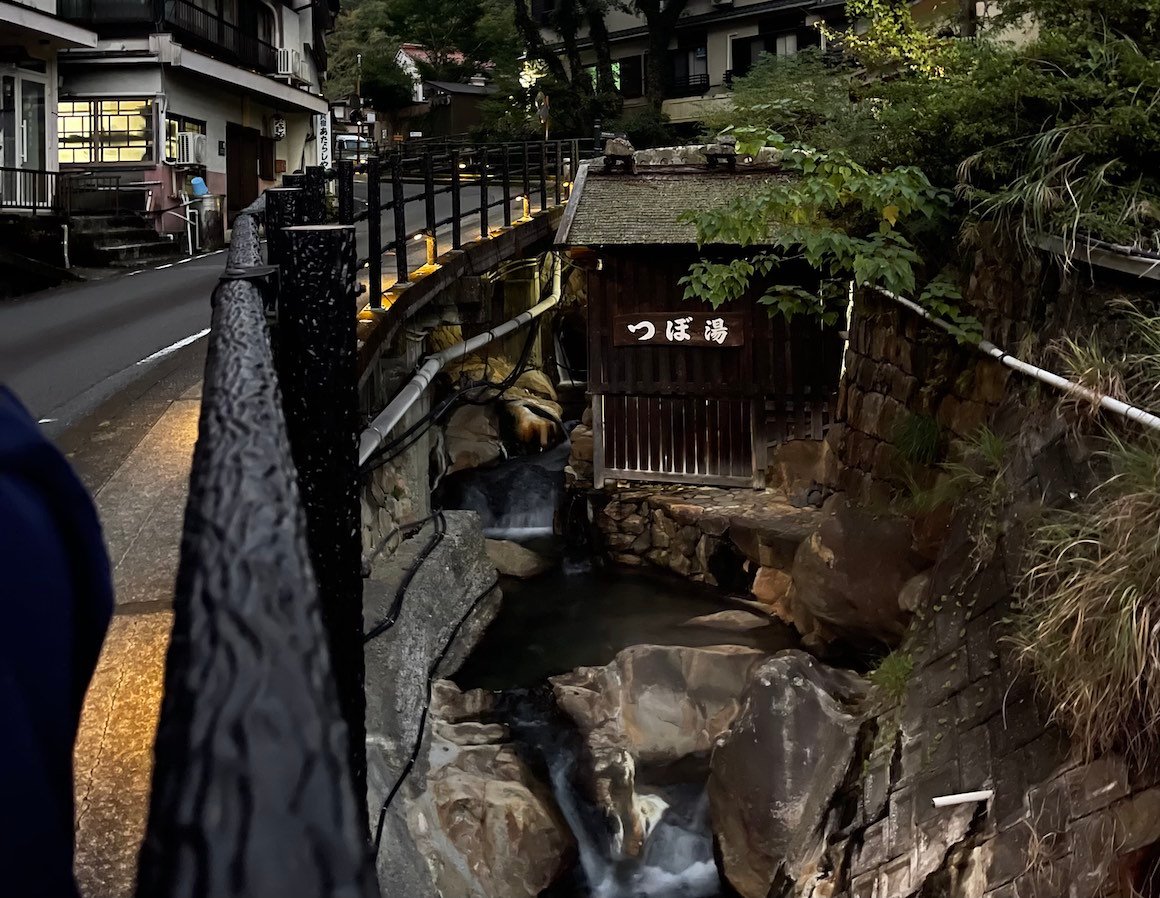
- Wash Up First: Before getting in the hot spring, make sure to thoroughly clean yourself in the washing area.
- No Swimsuits: Yep, you heard it right – no swimsuits allowed. Embrace your birthday suit.
- Respect Quiet: Keep it hushed. Onsen time is a peaceful time.
- Towels: The Onsen staff or your hostel will give you a small white hand towel. Don’t put it in the hot water; it’s for dabbing your face, not for dunking. You’ll see the locals balancing it on top of their heads as they soak.
- Tattoos: Some places might not allow tattoos. Check ahead if you’re inked up.
While there are some countries you can skate by without the internet, Japan is NOT one of them.
You’ll be using Google Translate…a lot! You’ll also need Google Maps to navigate the extensive public transport systems.
Having a SIM card is literally a life-saving Japan travel tip! I recommend getting an international SIM ahead of time; there’s some good info on how to pick up a SIM card for Japan in this post.
The people of Japan are a diverse and interesting bunch. And whilst the vibe is not the MOST friendly in the hectic urban metropolis, real rural Japan has truly lovely people.
I found that by smiling, being curious, and trying to speak a few words in Japanese, I had many really special experiences where it was just me and the locals…
I had great success hitchhiking in Japan and making friends on hikes. What’s more, I’ve learned a lot about Japanese culture from the people who picked me up or invited me to hang out with them.
So embrace these Japan travel tips, venture out with a smile, be curious, and you’ll find the best side of Japan waiting to embrace you.
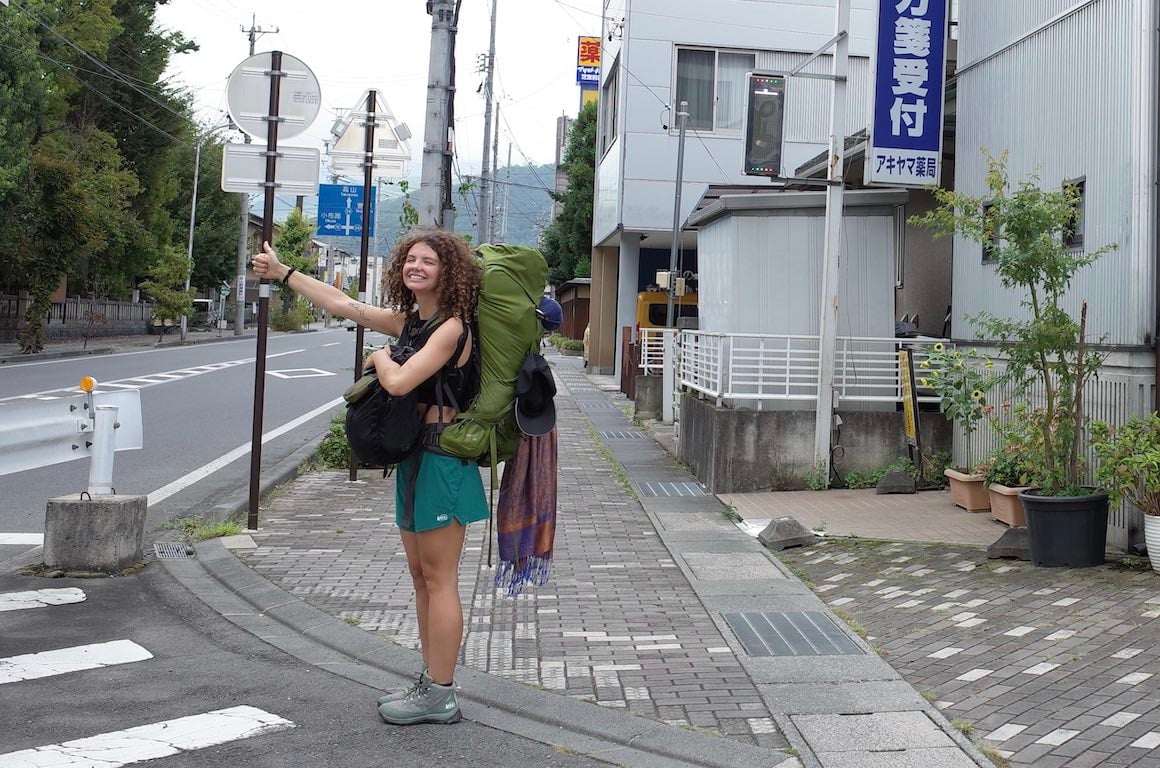
And for transparency’s sake, please know that some of the links in our content are affiliate links . That means that if you book your accommodation, buy your gear, or sort your insurance through our link, we earn a small commission (at no extra cost to you). That said, we only link to the gear we trust and never recommend services we don’t believe are up to scratch. Again, thank you!

Share or save this post

Audy Another amazing captivating story. I can’t wait for your next adventure!!!!
Leave a Reply Cancel reply
Your email address will not be published. Required fields are marked *
Save my name, email, and website in this browser for the next time I comment.
Notify me of followup comments via e-mail.
Boutique Japan
Japan Travel Tips: Expert Advice for an Amazing Trip
Thanks to years of planning Japan trips for our clients (and ourselves ), we’ve amassed a wealth of invaluable experience and essential travel tips.
Whether you’re visiting Japan for the first time, or planning a return visit, these Japan travel tips will help you prepare for your trip and get the most out of your time in the country.
This is a long article, featuring 39 of our best pieces of Japan travel advice. If you have the time and interest, we hope you’ll read all the way through. Or, refer to the table of contents below and skip ahead to the section most relevant to you!
Japan Travel Tips: Table of Contents
Planning your trip to japan, pre-departure: preparing for your visit to japan, you’ve arrived: tips for your time in japan, japanese etiquette tips.
- Eating and Drinking in Japan
We hope our tips help you in planning your Japan adventure!
First things first: if you’re in the early planning stages, this section will help you decide when to visit, where to go, and what to do during your Japan adventure!
1. Decide When to Visit to Japan
Japan is truly a year-round destination. Each season brings its own highlights, from cherry blossoms in spring and festivals in summer, to the stunning foliage of autumn and epic skiing in winter. Any time you visit, you’ll find plenty to enjoy.
The best time of year to visit Japan depends on your preferences for weather and crowds, and which experiences you most desire.
The dramatic differences between seasons require that you plan and pack appropriately for the weather – whether you’re hitting the beaches or the ski slopes! Bear in mind that the temperature can vary significantly depending on which part of the country you visit, so be sure to check the forecast for your specific destinations.
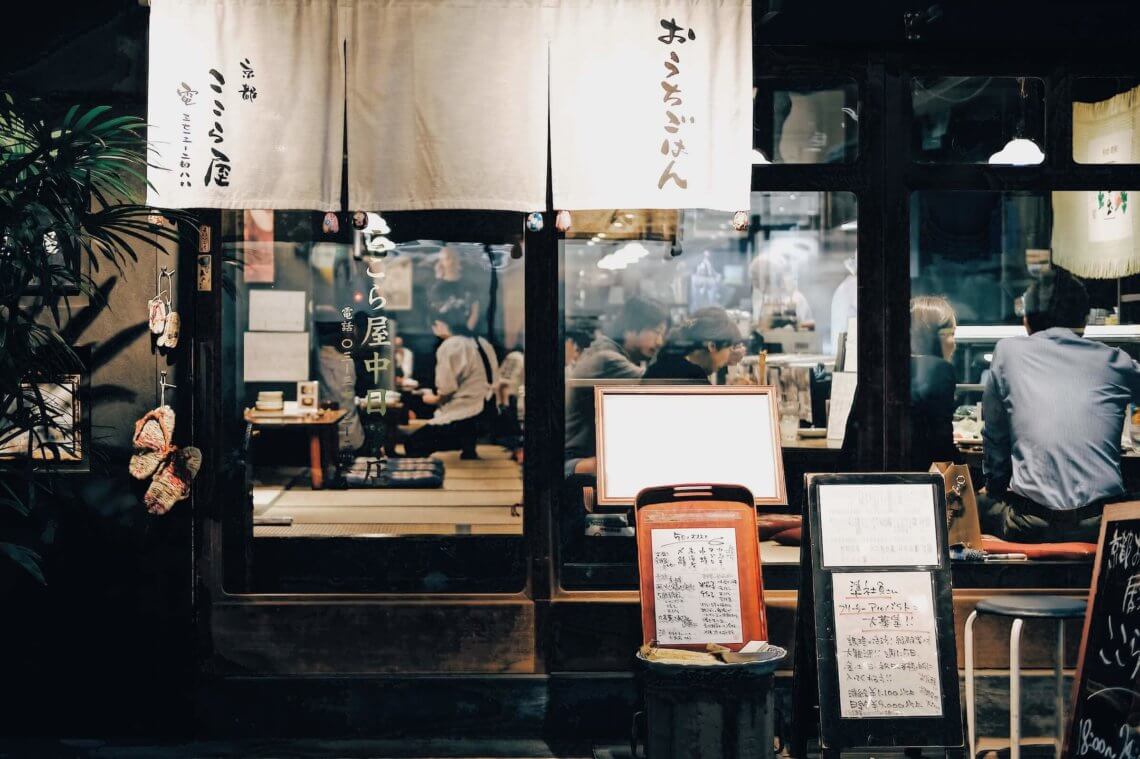
2. Where to Go: Japan’s Best Destinations
Japan has a remarkable number of destinations to choose from and an equally impressive number of things to do in each one.
To get the most out of your trip, we recommend sorting out your itinerary well in advance. Things like accommodation and event tickets often sell out quickly – especially during peak travel seasons – so planning ahead means avoiding disappointment.
If you’re after some inspiration, check out our sample itinerary for two weeks in Japan , and the rest of our unique and immersive sample Japan itineraries .
3. Unique Japanese Experiences
Visiting Japan is an opportunity to enjoy some truly unique and memorable experiences. There are, of course, far too many to fit into a single trip.
You’ll find inspiration in some of our top recommended experiences below. For even more ideas, see our article on 25 Japan experiences to add to your bucket list .

4. Venture Outside the Big Cities
When you think of Japan, the first places you think of are probably the big-name cities of Tokyo , Kyoto , and Osaka . These are amazing places to visit, but by no means everything the country has to offer.
To gain a deeper understanding of Japan, try exploring some of the more off-the-beaten-path destinations – especially if this is not your first trip. Head north to the wilds of Hokkaido, visit the peaceful villages of Shikoku, or explore some of Okinawa’s achingly beautiful islands. Not only will you escape the crowds, but you’ll also get a glimpse of some of the most authentic and memorable parts of Japanese culture.
5. Spend a Night in a Ryokan
A ryokan is a traditional, Japanese-style inn, and we highly recommend staying a night or two in one during your trip. Ryokan are very different from regular hotels, and a quintessential part of the Japanese experience.
The majority are located in the countryside, providing the perfect opportunity to unwind, rejuvenate, and enjoy the very best of Japanese hospitality. Complete with minimalist tatami mat rooms, yukata robes, kaiseki meals, onsen baths, and futon bedding, you’re guaranteed to find it an experience like no other!
To get a more detailed picture, take a virtual tour of a ryokan .
6. Discover True Relaxation at an Onsen
Japanese onsen (hot springs) resorts provide the ultimate in luxury and relaxation. Whether you choose a historic indoor bath or a remote outdoor location surrounded by breathtaking natural scenery, they are a sublime, authentic cultural experience that you won’t encounter anywhere else.
We have even more info about the onsen experience in the virtual ryokan tour mentioned above, but here are a few etiquette tips to keep in mind:
- Wash yourself thoroughly before entering the onsen itself, to keep the water sparkly clean.
- Keep towels, toiletries, and clothing (everything but yourself!) out of the water.
- Don’t stay in hot water too long if you’re not used to it – and be careful getting out. The high temperatures can make you feel lightheaded.
- If you’re nervous about being naked in front of other people, consider renting a private onsen instead. Many high-end ryokan provide private baths attached to the rooms, and others offer hourly rentals.
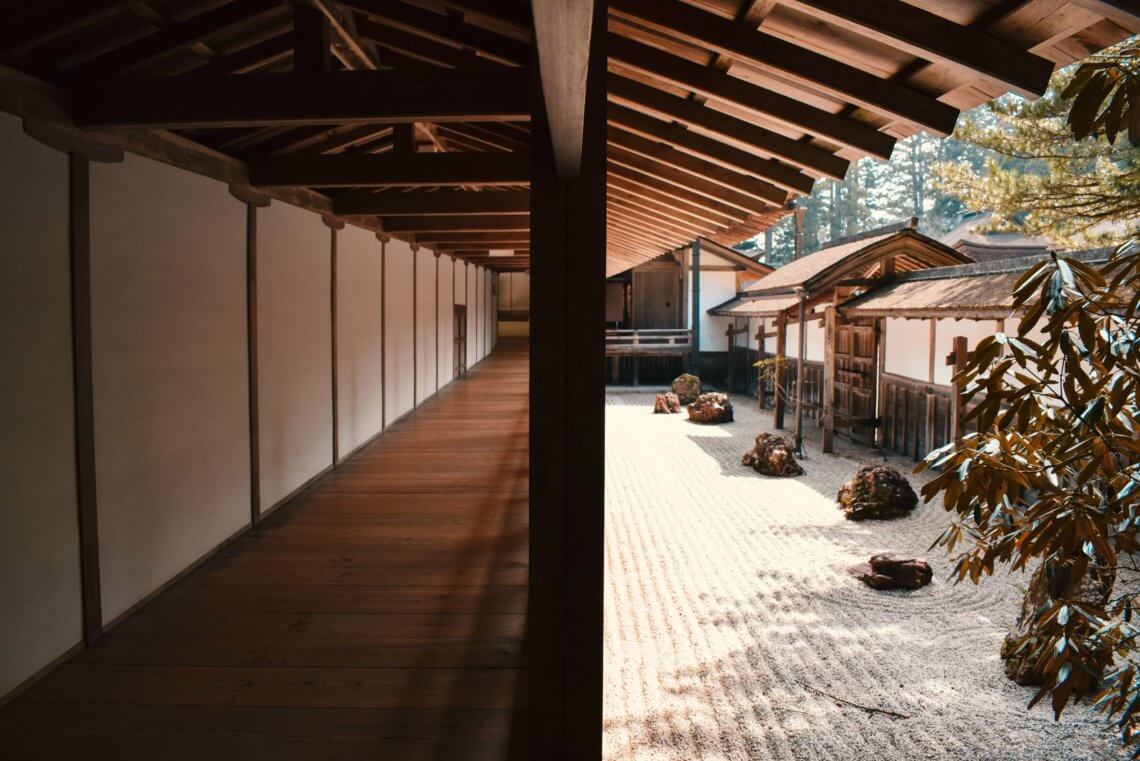
7. Stay in a Buddhist Temple
For even more of an escape from everyday life, a spiritual retreat at a Buddhist temple is just the ticket.
Visitors can get a taste of Buddhist life by staying at a shukubo (temple lodging), where you can take part in early morning prayers, meditation classes, and traditional Buddhist vegetarian cuisine. Some stays will also give you the option to help out with work around the temple as a form of active meditation.
One of the best places to experience temple life is on the mystical Mount Koya . Home to over 100 Buddhist temples and the otherworldly Okunoin Cemetery, it’s one of the most sacred destinations in Japan and the ideal location to immerse yourself in Zen.
8. Attend a Matsuri (Festival)
Japan’s matsuri (festivals) are nothing short of spectacular. Rich in tradition and bursting with color and energy, they showcase the country at its most dynamic and lively.
Attending a festival during your trip will be an unforgettable experience: a chance to try authentic and seasonal street food, witness unique traditions, and immerse yourself in an important part of Japanese life.
Festivals take place throughout the year all across the country, so regardless of your travel dates and itinerary, you should be able to find at least one to attend. Our list of Japan’s best festivals is a great place to start.
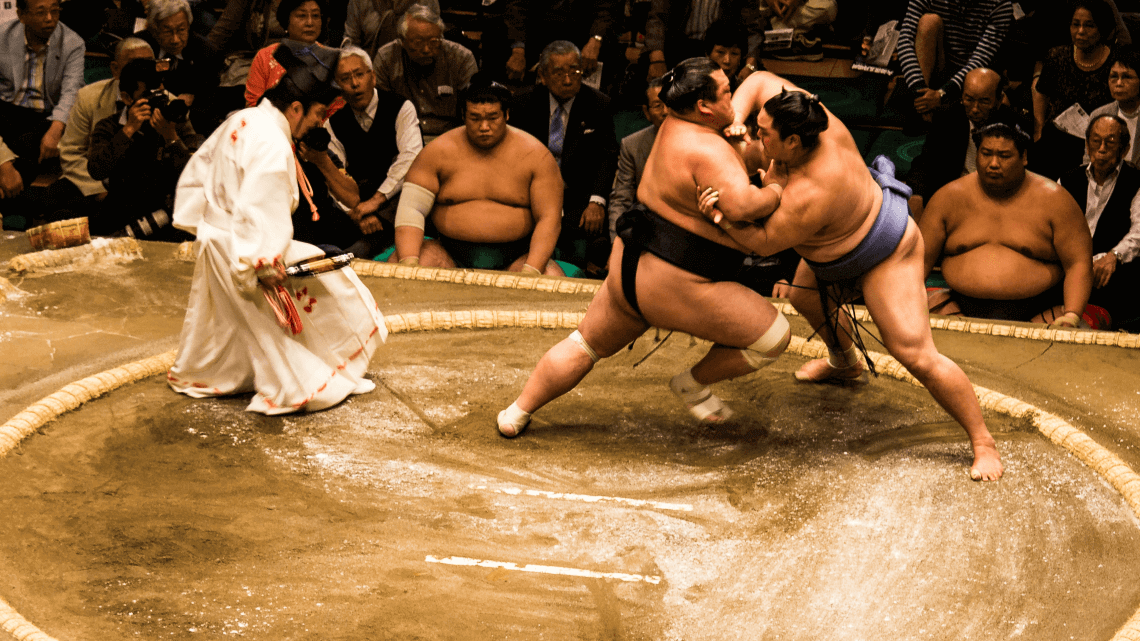
9. Cheer at a Ball Game or Sumo Tournament
To get an insight into a very different side of Japanese culture, consider attending a sporting event such as baseball or sumo – even if you’re not a sports fan.
Sumo tournaments are all-day events steeped in ancient tradition — and they take place just six times a year. If you can’t make it to a tournament, there’s also the option to go to a sumo exhibition or morning practice. All the details you need are in our guide to sumo in Japan .
Baseball is an altogether more modern affair. A Japanese take on an American classic, the games are lively but very friendly, with enthusiastic fans singing and cheering in unison virtually non-stop from beginning to end. Players often have personal fight songs, and each team has unique celebrations involving props such as balloons and mini umbrellas.
Games happen several days a week during the season, and tickets can be purchased online, at the stadium, or from convenience stores.
10. Take a Walk in the Woods
It may come as a bit of a surprise, but Japan is roughly 68% forested and 73% mountainous – making it very easy to escape the noise and lights of the city to spend quality time in nature. So grab your hiking shoes and a bento box lunch, and get out there!
Japanese culture emphasizes harmony with and appreciation for the natural world, and hiking is a popular pastime for people of all ages. In pretty much any city, you’ll find easily accessible and scenic trails to explore. From challenging mountain peaks – including the iconic Fuji-san – to stunning riverside walks, there’s something to suit all abilities and preferences. Plus it’s a great way to burn off the calories from all the delicious food you’ll be eating!
Next up, it’s time to prepare for your trip! Here are a few key things to think about before you leave home, from necessities like passports and currency, to packing advice and more.
11. Check Passports and Visas
A crucial part of any overseas travel!
Your passport should have at least six months’ validity from the end date of your visit, and two to four blank visa pages are recommended.
When it comes to visas, you might not need one – citizens of these countries can enter Japan without a tourist visa, usually for 90 days. Always check with the Japanese Embassy for the most up-to-date information before you travel.
We also recommend getting comprehensive travel insurance for your trip, to plan for the unexpected.
12. Learn Some Key Japanese Phrases
First of all – don’t panic! It’s entirely possible to travel around Japan without knowing the language. Most Japanese people speak a little bit of English, and you’ll find plenty of English-language signage in big cities and popular tourist locations.
Having said that, learning a few Japanese phrases can significantly enhance your overall travel experience in Japan. It’s a rich and fascinating language, and Japanese people really appreciate tourists making an effort to learn it – even if only the most basic of phrases!
Download the Boutique Japan Tiny Phrasebook to get started with some carefully-selected words and phrases.
13. Decide Whether to Buy a Japan Rail Pass
The Japan Rail Pass is a discounted train pass offered exclusively to tourists. It gives you unlimited travel on most JR trains – including the shinkansen (bullet train) – for periods of 7, 14, or 21 consecutive days.
It sounds like a great deal, and if you’re making multiple long-distance journeys it may save you money on travel. However, depending on your itinerary and preferences, it might not be the best option. Our short guide to the Japan Rail Pass can help you decide.
14. Travel with Plenty of Yen
Despite its hi-tech reputation, Japan is a very cash-oriented society – so bring plenty with you!
Many bars, markets, small shops, and local restaurants only accept payment in cash, particularly in rural areas. You will probably need to carry more hard currency than you’re used to. Luckily, Japan is very safe, so you can feel comfortable doing so.
Ideally, you should purchase yen in your home country, but you can also exchange money in Japan at the airport, and at currency exchanges in any big city. Alternatively, more and more ATMs are starting to accept international cards – especially those in convenience stores. Before you go, get the complete lowdown on cash, cards, and ATMs in Japan .
Don’t forget to let your bank and credit/debit card provider know that you’ll be abroad to help ensure you can use your cards while you’re away. If you’re not sure exactly how much yen to bring, check out our article: Is Japan expensive ?
15. Pack Light
Navigating Japan is much easier when you only have a small, easily portable bag or suitcase to contend with, particularly if you’re visiting a number of different destinations.
Can’t pack light? Skip ahead to the Luggage Forwarding section below .
Most trains have only a small amount of space for luggage, and even on the shinkansen there is no guarantee that you’ll find a space for a massive suitcase. Besides, stations are often crowded, making it awkward to navigate with large bags. You may even find yourself dragging bags up and down stairs if you can’t find an elevator or escalator.
If possible, limit yourself to a backpack and a small rolling suitcase – and remember to save room for souvenirs, because Japan is truly a shopper’s paradise!

16. Remember the Essentials!
We’ve already mentioned passports, yen, and weather-appropriate clothing, but there are a few more essentials you don’t want to forget:
- A small towel and some hand sanitizer: Some public bathrooms in Japan don’t have soap, hand towels, or dryers.
- Travel adaptors: Most of Japan’s electrical outlets are 2-pronged “Type A” (100 Volt, 50-60 Hz), so if your devices have a different style of plug, make sure you bring an appropriate adaptor.
- Small gifts from home: These are wonderful for giving to guides and other people you meet during your travels in Japan. Local specialties are ideal!
Check out our complete guide to packing for Japan for more advice on what to bring and what to leave at home.
17. Rent Pocket Wi-Fi
Free Wi-Fi is not as readily available in Japan as you might expect, so we strongly recommend getting a pocket Wi-Fi device for the duration of your stay. Pocket Wi-Fi is a small, mobile hotspot that allows you to connect to the internet from your laptop, tablet, or smartphone pretty much anywhere in the country.
It’s best to order one well in advance, and either collect it at the airport or have it sent to your first hotel. Most companies will also give you the option to rent a Japanese mobile phone or SIM card for your existing phone (if it’s unlocked), which can save you from paying exorbitant prices if you need to make local calls.
For more information and recommended providers, take a look at our Wi-Fi and Mobile in Japan page.
18. Download Some Useful Apps
If you’re opting for Pocket Wi-Fi, you may as well use it to make your trip go smoothly!
Numerous apps can be helpful during your time in Japan, but here are a few to get you started:
- Google Translate : It won’t always give you perfect translations, but it’s useful when trying to negotiate the language barrier.
- Japanese-English dictionary apps: There are plenty to choose from, including Imiwa? and Japanese . A dictionary app can be useful for looking up individual words quickly.
- Hyperdia : This app (and the associated website) enable you to search Japanese train routes and timetables across the country in English. Combined with specific transportation apps for the cities you’re visiting (like a Tokyo subway app), you’ll have no trouble getting around.
- Google Maps : This is invaluable for navigating your way through Japan’s sometimes labyrinthine streets. The general lack of road names can make finding restaurants and bars by address difficult, whereas Google Maps will lead you straight to the door.
Now that you’re all prepared, here are some things to keep in mind once you arrive in Japan. A mix of travel hacks and insider advice, they’ll help ensure your trip goes as smoothly as possible:
19. Get an IC Card
If there’s one thing that will add convenience to your time in Japan, this is it.
IC cards are rechargeable credit-card-sized passes that can be used to pay fares on various public transport networks with a single tap (like London’s Oyster card and New York City’s MetroCard). With one of these, you won’t have to worry about which ticket to buy or how much the fare will be — just tap and go.
Be aware that you will need to purchase paper tickets for the shinkansen and limited express/special express trains. For more information, here’s a dedicated article on train travel in Japan .
What’s great about Japan’s IC cards is that they can be used in other cities, besides the one where you purchased it. For example, Tokyo’s PASMO card can also be used in Kyoto. Plus you can use them to pay for drinks and snacks at most convenience stores and vending machines – it doesn’t get much more convenient!
20. Forward or Store Your Luggage
If you haven’t managed to pack light – or if you’ve purchased many souvenirs – you might find traveling around Japan with a large suitcase a bit awkward.
Luckily, Japan has an answer to your problem: ship your bags separately with the wonderful takuhaibin luggage forwarding service . This overnight service (longer if you’re shipping to airports or far-flung destinations like Okinawa and Hokkaido where ferry travel is involved) will have your bags ready and waiting for you when you arrive. Your hotel or ryokan will be happy to make arrangements for you.
Alternatively, if you only need somewhere to store your bags for a few hours, you can make use of Japan’s numerous coin lockers. Commonly found at train stations and shopping malls, coin lockers are safe, affordable, and convenient places to leave your bags during a day of sightseeing.
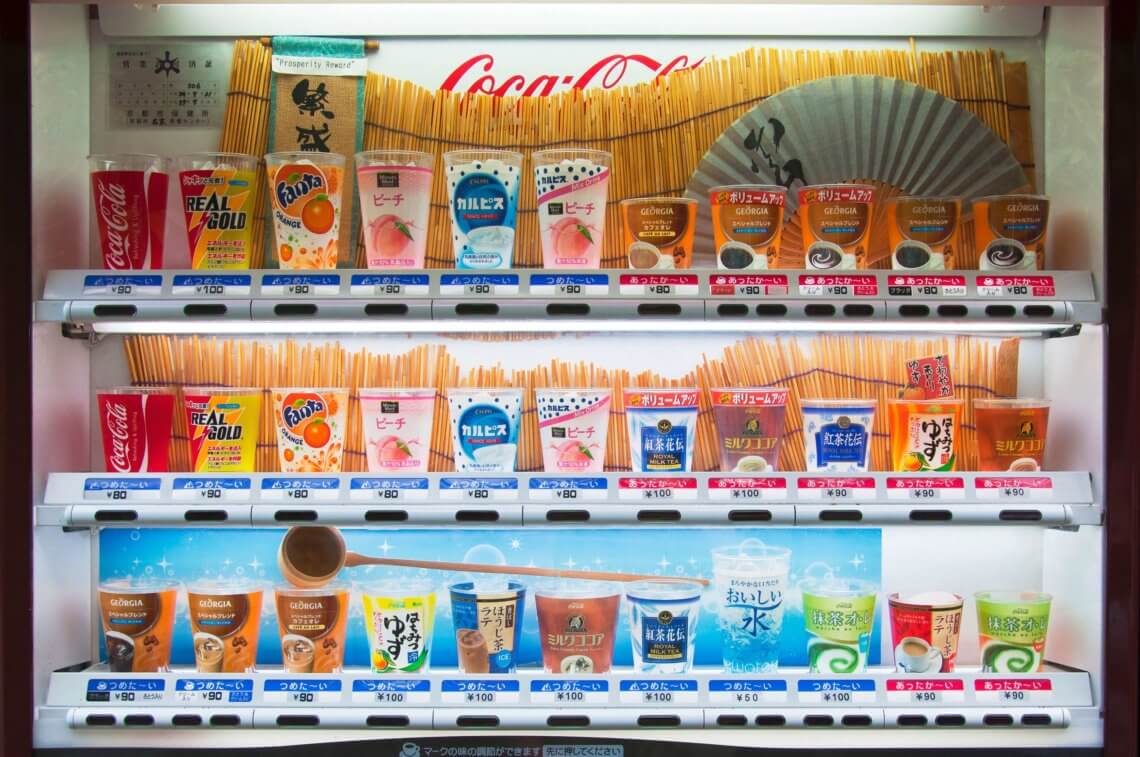
21. Take Advantage of Conbini (Convenience Stores)
Japan’s legendary convenience stores – known locally as conbini – make life for travelers and locals really, well, convenient!
In conbini , you can find ATMs to withdraw cash using your overseas credit or debit card, and arrange luggage forwarding if you’re staying somewhere like an AirBnB rather than a hotel. They offer a surprising array of food, drinks, and snacks, including reasonably priced coffee. On top of this, they sell a fantastic range of travel goods and toiletries in case you forget something.
You can also buy tickets for events like baseball games, and attractions such as Universal Studios Japan in conbini . You can even pay for domestic flights and bus tickets, although not always in English.
The best bit – there’s one on pretty much every corner.
22. Take Your Litter Home
For such a clean country, Japan has surprisingly few rubbish bins.
You’ll find them in places like convenience stores and train stations, but there are hardly any on the street. Apart from sometimes next to vending machines or in public areas like parks, you won’t see many places to dispose of trash. You may find yourself holding on to your litter for much longer than you expect – perhaps even until you get back to your hotel.
You can prepare for this by bringing a plastic bag or reusable tote with you to store rubbish while you’re out and about. It’s a small tip, but can make all the difference when you’ve got a handful of litter and nowhere to put it!
Incidentally, more and more Japanese supermarkets are starting to charge a couple of yen for grocery bags, so bringing your own can save you some cash – and the environment.
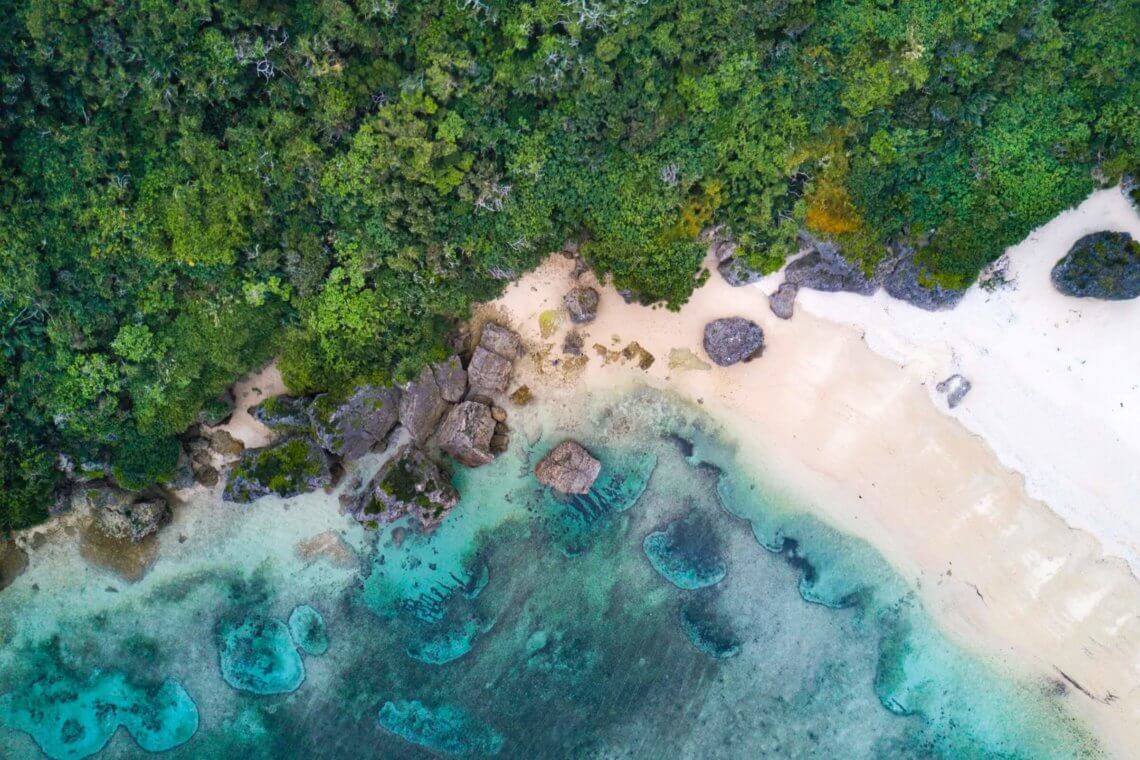
23. Avoid Crowds by Timing Your Sightseeing Right
It’s no secret that many of Japan’s top sightseeing spots can get pretty crowded. Kyoto , in particular, is known for attracting huge numbers of tourists to its most famous locations, including the stunning Fushimi Inari, Kiyomizu-dera, and Kinkaku-ji.
To avoid the worst of the crowds, consider timing your visit to coincide with quieter times of day, namely early morning or late evening. The sights are just as stunning, but you’ll have to share them with far fewer people. Perfect!
Japanese people don’t expect travelers to know all of their customs inside out — don’t sweat it too much. As long as you’re respectful, you’ll be forgiven for making an etiquette mistake or two! However, a little effort goes a long way, so here are some Japanese etiquette pointers .
24. Think Before You Tip
Tipping is pretty much unheard of in Japan, despite the phenomenal level of customer service. In fact, if you try to leave a tip, it will almost definitely be turned down – making for a potentially awkward moment.
If you want to show your appreciation to someone like a private guide or interpreter, one alternative is to bring a small gift from your home country. If you feel strongly about offering a monetary tip, be sure to do so in a manner that matches Japan’s tipping etiquette to avoid causing embarrassment or appearing crass.
25. Take Off Your Shoes
Before entering homes, ryokan , certain temples, traditional restaurants, and any area with tatami matting, you will need to take off your shoes. It’s advisable to wear shoes that slip on and off easily because you’ll be doing this a lot!
Some places provide indoor slippers for you to wear, but this won’t always be the case. For instance, on tatami it’s generally best to wear socks in order to protect the matting. As such, it’s a good idea to wear decent, hole-free socks – or bring a pair with you if you’re not wearing any.
Generally speaking, it will be obvious when you need to remove your shoes: look for indicators like a lower entrance hall, tatami flooring, slippers laid out on the floor, and shoe storage shelves. If in doubt, just ask.
26. Watch Out For Bathroom Slippers
During your travels in Japan, you may notice that certain places, like homes and ryokan, have slippers exclusively for use in the bathroom.
When you enter the bathroom, leave your regular slippers outside the door and switch to the bathroom slippers. These should only be worn in the bathroom, so don’t forget to change back when you leave. This common faux pas might result in you being greeted by (friendly) laughter from the locals!
27. Familiarize Yourself with the Toilet Buttons!
Speaking of bathrooms, Japan is well known for its fancy toilets, which have an array of buttons to control various features. These functions can include small and large flushes, a bidet, a dryer, and an automatic lid opener.
Sometimes the controls are labeled in English as well as Japanese, but more often than not, you’ll be left to decipher the pictures and kanji characters yourself. The icons should be reasonably self-explanatory, but if you’re feeling nervous about it, you can search for a sample image online.
28. Taxi Doors
Japan is famous for technology and efficiency, so it should come as no surprise that taxi doors open automatically.
When you hail a taxi, the driver will pull up, and the rear door will automatically open for you to get in. Once inside, it will close again automatically behind you.
It’s just a tiny thing to be aware of, but one that might save you a bit of a surprise!
29. To Bow or Not to Bow
Bowing is one of the most commonly seen Japanese customs, and it’s used in a wide variety of situations, including greeting people, thanking someone, and apologizing. As a general rule of thumb, the deeper the bow, the more respectful it is.
Don’t worry if you feel uncomfortable at first. Most Japanese people know that bowing is uncommon in the west, and they won’t be scrutinizing your efforts! If you’d prefer to shake hands instead, that will most likely be fine too.
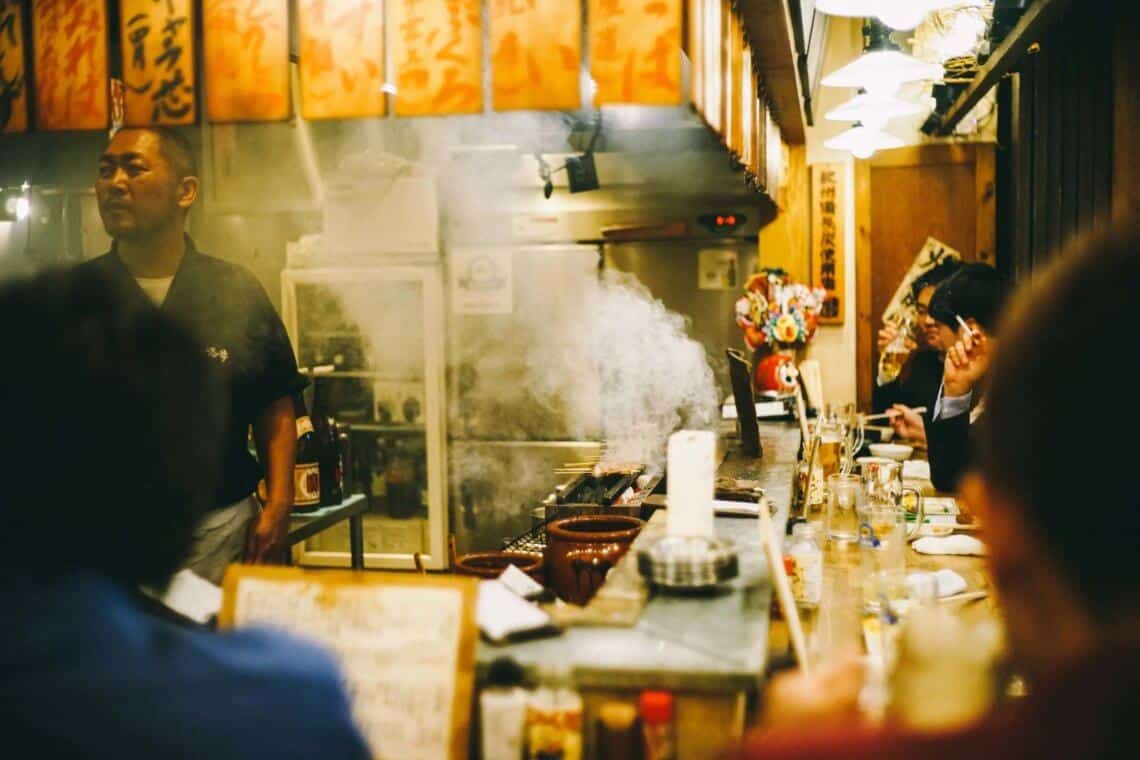
30. Smoking in Japan
If you’re a smoker, you’ll probably find that Japan is more lenient than your home country when it comes to cigarettes. Many traditional restaurants and bars still permit smoking inside. Train stations and other public areas often have an indoor smoking room where you can go to light up. Be careful on the street though, as smoking is usually not permitted on busy sidewalks – instead, you’ll need to look for a designated smoking area.
If you’re a non-smoker, you may well find the situation in Japan a little frustrating. However, an increasing number of bars and restaurants are thankfully choosing to make their premises smoke-free. A quick check of their website or signs in the window should help you find non-smoking establishments.
31. Cover Your Tattoos
In Japan, there is still an association between tattoos and organized crime. As a foreigner, you’re unlikely to be mistaken for a member of the yakuza. However, you might need to cover up your tattoos if you want to use public facilities such as gyms, swimming pools, and onsen (hot spring baths).
If your tattoos are too big or awkward to cover, don’t worry. You can always use a private onsen or search online for a tattoo-friendly one. These are becoming more common nowadays, particularly among establishments looking to cater to overseas visitors.
32. Be Respectful on Public Transport
Japanese society is known for its emphasis on politeness, and one of the places this is most apparent is the train network. Conductors bow to you, carriages are spotlessly clean, and departures are so punctual you can set your watch by them.
Keep these simple pointers in mind, and you’ll fit right in:
- Don’t talk on your phone on public transport. If you need to make or answer a call on the train, you can do so in the small compartments between carriages.
- Queue in the designated areas. On the train platform, you will usually see painted lines, numbers, and symbols on the ground indicating where to wait. And of course, let people off the train before trying to board.
- Enjoy it! Take photos out the window, recline your seat on the shinkansen , grab a delicious bento box lunch from the station or beverage cart. Trains are a great place to relax as you glide seamlessly to your next destination.
33. Use the Money Tray
In Japan, money is rarely passed directly from hand to hand.
When you’re purchasing something in a shop, restaurant, or bar, you’ll often notice a small tray next to the cash register. It might be on the counter or attached to the cash register itself. You should place your money or credit/debit card in the tray, instead of handing it to the cashier.
The cashier will usually place your change in the money tray after completing the transaction. The same system operates when paying for services in places like hotels, cinemas, and onsen.
Another common practice for exchanging money is to place cash in an envelope, rather than passing it openly, and using both hands to pass it.
Japan Travel Tips: Eating and drinking
Japan really is a foodie’s paradise. From Michelin-standard delights to authentic local cuisine, it more than deserves its reputation as a top culinary mecca. Here are some tips to ensure you make the most of Japan’s edible delights during your trip:
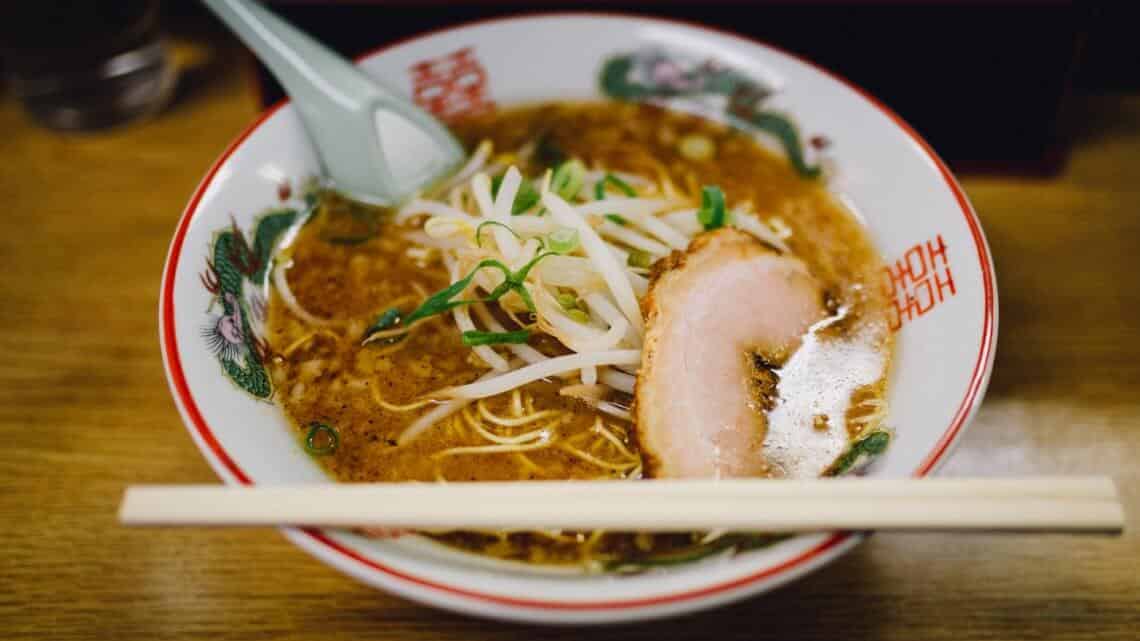
34. Try All the Food!
This may seem like a bit of an obvious point, but it’s still one travel tip worth making.
For a truly high-end experience, you’ll want to splurge on a multi-course, seasonal kaiseki meal – or the vegan/vegetarian version known as shojin ryori . To sample an eclectic variety of Japanese food in one place, head to an izakaya . These casual Japanese-style gastropubs are a must-visit, and one of the best ways to fully immerse yourself in local culture.
From well-known classics such as sushi and ramen to lesser-known but no less delicious dishes like soba and karaage there is a wealth of mouthwatering Japanese foods to try .
On top of this, there are countless local specialties to enjoy as you visit different cities. So if your itinerary includes several destinations, be sure to investigate! To get you started, check out our recommendations for must-eat foods in Kyoto , foods in Osaka , and foods in Fukuoka .
35. Brush Up on Your Chopstick Etiquette
Even if you consider yourself an expert with chopsticks, you might not be aware of some etiquette to keep in mind while using them:
A must for all the food you’re going to be trying!
- Never point your chopsticks at another person, wave them in the air, or spear food with them.
- Don’t stick your chopsticks into a bowl of rice, or pass food from chopsticks to chopsticks, as this is reminiscent of funeral rites.
- When serving yourself from a communal dish, use the opposite end of your chopsticks (not the end you put in your mouth) to serve yourself.
If you can’t use chopsticks don’t worry – you can always ask for a knife and fork.
36. Plan Ahead if You Have Dietary Requirements
Contrary to popular belief, traveling through Japan with special dietary requirements is definitely possible – if you plan ahead.
It is, unfortunately, true that dietary restrictions are not as well understood in Japan as in some other countries, and they cannot always be accommodated. However, following this advice will make your life much easier:
- To prevent misunderstandings, convey what you can and can’t eat specifically (rather than just stating that you are vegan or gluten-free, for example).
- Give plenty of advance notice when asking a restaurant or ryokan to alter their menu, as it will take time and preparation.
- ‘I’m allergic to ___.’
- ‘I can’t eat ___.’
- ‘Does this contain ___?’
- Research, research, research! The internet is a goldmine of information and advice for travelers with dietary requirements in Japan . There is an ever-increasing number of websites about being vegan/vegetarian/gluten-free/etc. in Japan, which can be absolute life-savers.

37. Go Sake Tasting
No list of Japan travel tips would be complete without a little sake!
If you’re not an expert, the best way to gain an appreciation for sake is quite simply to drink it. If you’re unsure of where to start, try a sake tasting experience or go on a brewery tour for a crash course. Another option is to ask the bar or restaurant staff for their recommendations.
One thing to bear in mind is that in Japanese, the word ‘sake’ refers to all alcoholic drinks in general. Use the word ‘nihonshu’ when you order, and you’re sure to impress! If you’re drinking with a group, always fill up other people’s glasses, not your own – and they’ll do the same for you.
For a longer primer on Japan’s national tipple, take a look at our Sake 101 guide. For something a little different, consider branching out into shochu .
Incidentally, while Japan might be best known for sake, it also has an internationally-acclaimed whisky industry . There are several Japanese whisky distilleries across the country that you can visit for a glimpse behind the scenes and a tasting, as well as a plethora of specialty whisky bars.
38. Attend a Tea Ceremony
Japan is home to one of the world’s most venerable tea cultures, and nowhere is this more apparent than in the traditional tea ceremony.
Participating in tea ceremonies is a wonderfully Japanese experience. Conducted using matcha – a high-quality, finely ground powder made from shade-grown green tea plants – it is not simply a way to learn more about preparing and serving tea. The ceremony is also a chance to take a break from the hustle and bustle of everyday life and enjoy authentic Japanese hospitality.
You won’t be expected to know the etiquette of the tea ceremony – after all, that’s part of what you’re there to learn! Just remember to wear nice socks and comfortable clothes, as you’ll likely be in a tatami room and therefore have to remove your shoes and sit on the floor.

39. Don’t Restrict Yourself to Just Matcha!
Matcha might be the most famous, but it’s certainly not the only tea in Japan that you can explore.
If you’re a tea lover, be sure to take the opportunity to try all the varieties of tea on offer. From grassy sencha and top quality gyokuro , to roasted hojicha and brown rice-laden genmaicha , Japan has a tea for every taste and occasion. Besides tea ceremonies, you can visit tea houses for tastings, and even tea plantations for tours.
Tea leaves also make an ideal souvenir, enabling you to bring a taste of Japan back home with you.
Not a fan of tea? Japan also has a booming specialty coffee scene , so be sure to check it out if a cup of joe is more your style.
Looking for More Authentic Japanese Experiences?
Hopefully, these Japan travel tips have helped you in planning and preparing for your trip.
Whether you usually plan your own trips, or normally work with a destination expert, planning a trip to Japan can seem overwhelming at times.
At Boutique Japan, our specialty is crafting completely customized trips for travelers seeking unique, authentic experiences.
If you are interested in learning more about working with us, please feel free to explore our trip planning process .
More Great Posts

Japan’s Best Boutique and Luxury Hotels & Ryokans
The best hotels and ryokans in Japan range from charming traditional inns in the countryside, to stylish design hotels and…

Traveler’s Guide to the JR Pass (Is It Worth It?)
The Japan Rail Pass (or JR Pass, for short) can be a good way to get around Japan, but many…

Major Holidays and Peak Travel Seasons in Japan
If you’re considering a trip to Japan during one of the country’s peak travel seasons, be aware that things can…
Plan Your Japan Trip
Learn more and contact us to discuss your unique trip.
Get Started
- The Process
- Testimonials
Gaijinpot Blog

5 Genius Travel Hacks for Your Trip to Japan
Make every moment of your Japan trip count with these top travel hacks.
By GaijinPot Partners Feb 28, 2017 6 min read 2
So you’re planning a trip to Japan – lucky you! But maybe you’re feeling a bit nervous about what it’s going to be like? Well, calm your farm and settle your kettle because GaijinPot have teamed up with the guys at Travel Japan Wi-Fi to offer the following smart travel hacks that will help you make the most out of your Japan adventure.
1. Get a travel (IC) card
A post shared by よしだまさひこ (@yoshidamasapico) on Jan 29, 2017 at 3:18am PST
There are different types of rechargeable cards. Pasmo, available in Tokyo, Suica in Greater Tokyo, Niigata and Sendai; Icoca in Greater Osaka, Hiroshima and Okayama; and Kitaca from Sapporo in Hokkaido are some of the most popular. Valid for up to 10 years, most require a 500 yen deposit which you can get back by returning the card at the airport or train station.

So which “ca” or card do you choose?
Well, good news! They’re almost all compatible with each other so whichever card you opt for, you’ll be able to use them in tons of situations no matter where you are in the country. Just tap your IC card to get around via train, subway, bus and even some taxis. Then, when you’re feeling hungry you can use it to pay for a gyudon (beef and rice bowl) at fast-food chain Sukiya, grab that suncream you forgot at the convenience store (see below), stop for a pick-me-up coffee at Doutor, before buying yourself a snazzy new gadget at Bic Camera.
When you pick up your card for around 500 yen at the airport or train station, make sure to personalize it with your own name or a funny alias.
Also does anyone else feel that Pasmo should be Pasmoca?
2. Download this Wi-Fi app
A post shared by TRAVEL JAPAN Wi-Fi (@traveljapanwifi) on Dec 9, 2016 at 2:54am PST
If you’re picturing Japan as a futurescape of hyperconnectivity ruled by flying robots, well…think again. The lack of accessible Wi-Fi is usually a big surprise for visitors here who often end up paying a chunk of money for a prepaid SIM or pocket Wi-Fi out of desperation.
Download the free Travel Japan Wi-Fi app , available for non-Japanese iTunes and Google Play accounts, before or when you arrive in Japan. It offers seriously comprehensive and reliable coverage, connecting to over 200,000 hotspots across the country, as well as showing local area navigation and tourist information. Plus, true to the travel hack spirit, you can also get discounts in affiliated places like Bic Camera and Edion (for electronics), Gyu-kaku (for Japanese-style barbecue) and the Robot Restaurant (for dinner and a mind-blowing robot show).
Basically like your own digital tour guide that keeps handing you coupons every now and then (maybe Japan is ruled by robots?!), the app will keep you connected pretty much wherever you go. The best part? There’s none of that messing about trying to login and being forced to create an account with your high school hotmail address.
3. Make use of the ridiculously convenient convenience stores
The toughest decision I must make every day #conbini #familymart #bento #lifeintokyo #lifeinjapan A post shared by alice 🌸 みほ (@travelsinwonderland) on Sep 5, 2016 at 10:40pm PDT
The Japanese convenience store is basically hack paradise with all of the fresh food and handy products you didn’t even know you needed on sale 24 hours a day, 365 days a year. And it’s all delivered via a super efficient production line where every inch of shelving is squeezed to maximum profitability (one of the reasons why convenience stores in Japan show high growth despite economic deflation). Japan’s top konbini , 7/11, likes to think of itself as “a home refrigerator” which is definitely accurate if your fridge also contains nail varnish remover, phone chargers and underwear.
The convenience store is where you can also:
- Withdraw money from a foreign bank account
- Buy tickets to concerts, sports matches, events and museums (like the Ghibli Museum in Tokyo)
- Pick up flight tickets
- Pick up packages
- Use the fancy Japanese toilet
- Read magazines
- Pay bills (if you manage to rack any up while you’re traveling)
- Photocopy, print and scan stuff (with instructions in English)
- Store luggage
- Kill time forever browsing all of the interesting items

4. Save money with the different discounts only for tourists
Au revoir Japon… A la prochaine ! 🙋 #Japon #ghibli #totoro #jrpass #ontheroadagain A post shared by Amelia (@amelm15) on Aug 15, 2016 at 4:12pm PDT
Worried traveling in Japan is expensive. Don’t be! As long as you have a tourist visa in your passport, you qualify for countrywide discount passes galore. You can save heaps of cash on transport, shopping, dining and activities. You just have to know where to look.
For discount rail travel on the futuristic and oh-so-sleek Shinkansen (bullet train) network, make sure to get a JR Pass back in your home country before you fly. Speaking of flying, if you’re more of a plane nerd then opt instead for the JAL Explorer Pass – a flat rate airfare that covers a range of domestic routes. Or get the most bang for your buck by hopping on a Willer Express highway bus with their highly economical Japan Bus Pass.
Many major cities will offer transport and sightseeing discount combos. An increasing number of theaters, museums, galleries, zoos and aquariums are also jumping on the bandwagon thanks to encouragement from the Japanese government as it pushes to attract 40 million tourists to the country by 2020. Their rallying call has reached the most remote corners of the country so expect to find even smaller attractions giving discounts.

As a temporary visitor, you’ll also benefit from tax exemption on things like food, cosmetics and medicine, clothes and electronics. Look out for the tax free counters in big-name brands like Uniqlo, Don Quijote and Muji, as well as many department stores.
5. Learn these phrases to sound totally fluent
A post shared by GaijinPot (@gaijinpot) on Jan 9, 2017 at 5:46pm PST
The myth that Japan doesn’t speak English simply no longer holds true. In general, tourist attractions in Japan have multilingual signage as well as staff – a fact that is becoming more widespread with the push to create a foreigner-friendly environment in the lead up to the Olympics.
But when the need comes for you to break out those mad linguistic skillz, the following essential phrases will make you sound like an absolute poet.
- Konnichiwa – Hello (a classic – you probably know this one already)
- Douzo – Please go ahead (expect to be be doing this polite “you first” dance a lot)
- Onegaishimasu – Please (an obvious one)
- Arigatou gozaimasu – Thank you (ditto above)
- Sumimasen – Excuse me (this will get you out of many a situation)
- Oishi! – Delicious! (Japan’s favorite word)
- Sugoi! – Wow! (Japan’s second-favorite word)
- Atsui/Samui desu ne? It’s hot, isn’t it? / It’s cold isn’t it? (Great to start a conversation, though after that you’re on your own).
- Shashin o totte mo ii desu ka? Is it OK to take a photo? (Always ask first)
- Eigo o hanasemasu ka? – Do you speak English? (Be the one to make the effort in Japanese!)
Hopefully with these genius travel hacks you’ll be able to make every moment of your trip to Japan as awesome as it can be. You’re welcome. 🙂

GaijinPot Partners
Reach an international audience today.
More articles by GaijinPot Partners

Download Travel Japan Wi-Fi Now
Stay connected with the Travel Japan Wi-Fi app wherever you are in Japan.
Leave a Reply Cancel reply
Your email address will not be published. Required fields are marked *
Post comment
This site is protected by reCAPTCHA - Privacy Policy - Terms of Service
These are good tips. Except No. 4 about dutyfree tax thing… you have to purchase certain amount to qualify for that. Not for anything everywhere… Also, about free wifi network app… Although i’ve never used it, isn’t it still PUBLIC network? So, i’d prefer renting pocket wifi router thru Rakuten, which you can find cheapest ones. ( ‘-^ )b
Get a Capital One checking account and ATM card. You can use it in a 7-11 ATM with no fees.
5 Reasons Japan is a Budget Traveler’s Dream Destination
Forget full moon parties in Koh Phangan or rickshawing through the streets of Hanoi, there’s a new budget paradise in town.
By GaijinPot Blog Nov 27, 2019 5 min read 7

A Guide to the Sapporo Snow Festival
Headed to Japan's most popular winter festival this year? Or thinking to book a last-minute trip? Here's a guide for what you need to know before you go.
By John Asano Jan 13, 2017 6 min read

A Guide to Traveling Japan for Cheap with Highway Buses
Japan's countrywide network of highway buses offers a cheap alternative to train and air travel, with some surprising perks.
By Liam Carrigan Feb 2, 2017 6 min read 3

- Employers Area
- List Properties
- Advertise on GaijinPot
- © 2024 GPlusMedia Inc.
- Terms of Use
- Privacy Policy
🇯🇵 How to Travel to Japan Like a Pro (Even if it’s Your First Time)
I’m back to writing and today we’re talking about one of my favorite travel places: Japan. I’ve been there four times already, and I am eager for my fifth. And last month, I did a podcast episode with Brandon Presser (🎧Ep 101 ), who has been there over a dozen times, lived there twice, and written five guidebooks on Japan. Today’s newsletter will tell you where to go, what to do, and how to do it. We’re going to help you plan the best trip ever.
Share this post with your friends who love traveling so they can discover a fantastic Japanese experience. And if you have been to Japan, please share your thoughts with me too!
Look out for a bonus post in a few days where I’ll cover using your points for flights and hotels, as well as some ways to boost your points balances before planning your next trip.
🗾 Japan: Overview
Japan has a deeply modernized and evolved culture. It excels in transforming facets of other cultures into the best possible version with intentionality and care. For example, Japan has become an international leader in hospitality, cuisine, and leisure through the thoughtful integration of traditional and modern aspects.
The country has four major islands to explore:
Honshu is the main island, home to Tokyo and Kyoto.
Kyushu is in the south with active volcanoes and onsen culture (hot springs).
Shikoku is the quietest, with small villages and farming, where you can deeply immerse yourself in the culture.
Hokkaido is in the north and famous for skiing, but the wilderness and mountains are not to be overlooked.
“The more time you spend [in Japan], the more you realize you don’t know the destination that well. And every time I go back, there’s always a new thing to explore. There’s always a theme that needs unpacking. And it’s one of those places that’s, it’s not like in New York where you get to live there for ten years, and then you get to say you’re a New Yorker. The more time you spend, the more you’re like, wow, I’m not from here.” (Brandon Presser)
First time in Japan? Here’s a way to approach it:
Japan offers many options, so your first time might feel overwhelming. A simple framework for your trip is to think of it as a meal:
Appetizer : Soak in the vibe, and do some sampling while you get over the jet lag (Tokyo and Kyoto).
Main Course : Attend some must-see sights and experiences (Tokyo and Kyoto).
Dessert : Visit one of the other islands and treat yourself to an immersive experience ( ryokan ).
Language Barrier
In four trips, I’ve only picked up a dozen or so words/phrases, and I’ve never had a problem in Japan. Also, since my first trip in 2004, I’ve definitely noticed an improvement in the English spoken/written in Japan. Finally, while you might need to speak slower and point more often, there aren't any countries in the world that you can't visit if you don't speak the language, so I wouldn’t ever let language prevent you from traveling somewhere.
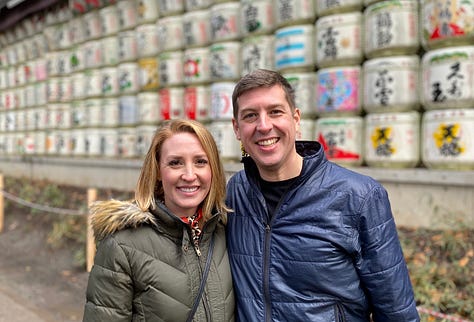
⌚ Best Time To Travel
There's no wrong answer; it depends on what you want to discover.
In the Spring, you’ll experience sakura , the stunning cherry blossoms. While you will experience the crowds, the beauty is worth the hype. And you don’t need to be in Tokyo or Kyoto to see them.
In the Fall, you’ll experience koyo , the beautiful autumn colors. The red Japanese maples are just as magnificent as the cherry blossoms. Since the country is 70% covered in forests, it’s a sight to see into November.
In the Winter, you’ll experience perfect conditions for skiing in Hokkaido , wintry landscapes, and stunning sunsets. While the winter is colder, the crowds are fewer, and prices are lower.
In the Summer, you’ll experience matsuri , the festivals, and the country's liveliness. It’s a great opportunity to wander the city via walking or transit. While its vibrancy is in full effect, it can get hot and humid.
🏨 Hospitality Culture & Norms
Hospitality is centered around omotenashi , an elevated sense of service. There is an unspoken social contract unique to Japan that you are a “deferential” guest. In other words, the idea that “the customer is always right” doesn’t really exist like it does in the US, and you are expected to be as well-behaved and as friendly to hospitality staff as they are to you.
Also, punctuality is a core value in Japanese culture. Trains run on a perfect schedule. Brandon actually shared his experience of being on a late train, and he received an official notice from the rail operators to give his boss an excuse for being late. Also, in 2017 and 2018 , rail operators issued nationally broadcasted apologies for trains that unintentionally left 20 seconds too early. The point is punctuality is important, so try not to be late for any of your reservations (restaurants, guides, trains, etc.).
Meeting locals in Japan is a bit harder than I’ve experienced in other countries. It's difficult to strike up a spontaneous conversation. However, I have found more success meeting locals through more structured ways, like attending a free walking tour.
Luxury Travel Planners, Guides & Hotel Concierges
There are many restaurants and experiences you can’t do without access to a connected local. It’s not as simple as booking online to eat at some Michelin-starred restaurants or attend certain cultural events. But don’t let that steer you away. If you can’t find a travel planner or guide, you can leverage high-end hotel concierge services for hard-to-book places. Book a few nights in a high-end hotel to take advantage of the concierge services and move to a more affordable place later. We had great success getting some tough reservations with the help of the Hilton Tokyo concierge.
It’s also important to note that many hotels offer a more comprehensive range of services and experiences than before the pandemic. They’ve invested in compelling food and beverage options and attracting locals to eat in their restaurants. Some even have secret personalized experiences with local artisans ( Aman in Tokyo ). For example, you could cut a kimono or yukata robe, hand etch chopsticks, or learn fan design.
Planning for Meals
Japan is a very populous country, so plan what you will eat and where you will stay ahead of time. The best tool for finding dining experiences is Tabelog . Just note that Japanese culture takes its food rating system very seriously. A great experience might be rated “3” because that qualifies as a great score.
Pro tip (ratings): The average for excellent is between 3-4 in Japan, so when you see a place with a really inflated score, it’s probably more frequented by foreigners than locals.
Dining Expectations, Etiquette Tips & Social Shopping
It is surprisingly cheap to eat in many places. For people who love to eat and try new food, it’s the perfect country for you. I will say “most” places are surprisingly cheap because Tokyo is notably home to 200+ Michelin-starred restaurants (the most of any city in the world).
If you want to hack your daily food “allowance”, do two lunches. Do the first at 10:45 am, then another at 2:45 pm. You’ll get to try more places and, bonus, avoid some lines. But I will say this; you won’t be able to avoid lines forever. Waiting in line is just a part of the dining process, so it’s better to know this going into it.
If you eat with a larger group, expect to go in as pairs or trios. Many spaces are small, and dining is not always designed as a social experience. That said, there are less structured, informal venues perfect for socializing, like izakayas.
If you see a restaurant with multiple locations, don’t hesitate to try it (I’m talking of soba, gyoza, or ramen places, not McDonald’s). In America, having more than one location might be considered more corporate, but in Japan, having more than one location often means the food was good enough to expand. Since many restaurants are small, they might have added more locations just to serve more customers in different areas.
Note that Japan is a non-tipping culture and although your attempt might be well-intentioned, the act might be perceived as rude. So it’s best to get comfortable without leaving a tip.
Shopping in Japan (especially in Tokyo) is a social activity. Since people live in small spaces, it’s more accessible to hang out in public. Shopping can also be a super interesting experience for tourists. One reason is sizing. While I wear a L shirt in the US, I often found myself trying 2XL’s in Japan, and I never was able to find shoes or pants that fit.
Traveling With Kids
We’ve gone four times, but never with kids. We constantly walked around, tried new things, had cocktails, and ate four meals daily. Will we have another Japan trip like that with young kids? Probably not, but there are also family-friendly ways to experience the city, so I don’t want to discourage it. I’m excited to bring our girls to Japan to try new foods and enjoy many beautiful green spaces, open patios, and walking areas.
Tokyo is unlike any other city. It is enormous in every sense, yet more organized than any other city half its size. The best way to get around is by walking and public transit. Here are a few ways to get acquainted:
Explore Tokyo by Foot
Walk a triangle from Omotesando to Harajuku and then down to Shibuya . You can easily do this all on the same day and experience some great highlights of Tokyo.
In Omotesando, you’ll experience small boutique shops and luxury “rodeo drive” style shopping.
In Harajuku, you’ll experience a unique clash of styles (think hip-hop meets little bo-peep).
As you keep going, you’ll find the Meiji Shrine , which then turns into Shibuya Crossing , the busiest pedestrian crossing in the world.
Pro tip (from Amy): walk everywhere to burn enough calories for four meals daily.
Explore Tokyo by Train
Use the Yamanote Line . It’s a great option since the rail travels in a circle around the city. Also, if you try to take in the map of every single line, you’ll experience a sensory overload.
The Yamanote line is a perfect way to visualize Tokyo geographically because the city is structured like a clock:
1:00 - 2:00 are the older areas
3:00 is also a central hub of activity
6:00 - 9:00 are the newer neighborhoods (and Brandon’s favorites )
9:00 - 10:00 are the major stations
Pro tip: Use the Suica mobile wallet (instead of the physical card) and Google Maps to get around. Note that because there are two different subway companies in Tokyo the fastest route may require a transfer that makes it more expensive than another route.
Tokyo Restaurant & Drink Recommendations
Maisen is popular and famous for its tonkatsu (breaded pork cutlet).
Kagari Ramen offers chicken ramen you won’t find anywhere outside Japan.
Kikanbo is my favorite Japanese restaurant for spicy ramen.
Rokurinisha serves dipping-style ramen, which you should try at Tokyo Station.
Min Min possibly has the best gyoza in Japan, also at Tokyo Station.
Savoy Azabu Juban has the best pizza in the world (as a side note, you should try other types of food after your Japanese fix).
Tama blends Japanese and Taiwanese influences with parts of Okinawan culture.
Tatemichiya is a punk rock izakaya with such a fun vibe.
7-Eleven has some of the most amazing snacks. You might be surprised to hear this, but they have some of the most delicious pancakes in the world. Look for these and then heat them in the microwave and eat them there. Also, Brandon says the 7-Eleven egg salad sandwiches are so delicious that he can write poetry about them.
Deus ex Machina has outstanding coffee.
Bar Trench , Bar Tram , and Bar Benfiddich serve amazing cocktails (Japan takes cocktails to a whole new level).
Breakfast Club is a Japanese version of an American diner that combines breakfast with a bar-type atmosphere.
Bear Pond is a little hole in the wall that is massively popular for espresso (I’ve been told not to take photos).
The Best City View in Tokyo
Going to a high-end hotel is the best way to enjoy a city view in a relaxed atmosphere instead of in tourist-filled spots. The New Four Seasons at Otemachi has the best view of the Imperial Garden. Right behind it, you can see Mount Fuji on a very clear day (in the winter).
Tokyo Experiences Off The Beaten Track
If you want to do something different, you should explore some other Tokyo neighborhoods ( Shimokitazawa , Kichijoji , Daikanyama , Nakameguro , and Jiyūgaoka ), where you will find tiny traditional houses, tight spaces, boutique shops, and mom-and-pop shops.
Also, check out the immersive experiences from Team Labs – they’re filled with amazing immersive art with light, sounds, and textures. They are so incredible that we went to one and decided to do another one the next day.
2️⃣ Kyoto
Kyoto is the ancient capital with some of the oldest cultural relics, but it’s a place of learning at its core. It’s a college town with a thriving student culture worth visiting.
First time in Kyoto? Here are two simple things you should do:
Rent an electric bike. Since Kyoto is in the middle of the mountains, it is hilly, but there is less traffic, so things move slowly. Bicycle riders don’t need to worry about getting lost. You’ll be able to explore different neighborhoods and never be far from your hotel. Remember to ride on the left side of the road.
Wander. The back alleys in Kyoto are full of interesting things to discover. Some shops have been selling specific, handcrafted items for 300 or 400 years (like 11 types of scissors). You can still walk in and show interest in their work even if you don’t plan on buying anything. Be sure to thank them for their time and express interest in what they are doing because they take great pride in their work.
Pro tip: Any time you receive anything in Japan, hold it for a moment and accept it because it’s a sign of respect.
Restaurant & Drink Recommendations
Bar Rocking Chair will make you wonder if you should ever leave.
Yugen serves matcha, and it is one of the most beautiful shops I’ve been to.
Da Yuki specializes in Napoletana pizza with a chef trained in Italy who has brought everything back to master the art of pizza.
Ippodo Tea does tea tasting with a storied reputation in the country (think of wine-tasting for tea).
Monk is a restaurant that takes the sort of multi-course idea in Japanese cuisine and flips it to Italian style.
House of KI NO BI offers a fascinating gin-tasting experience utilizing local botanicals.
Yasai Hori is run and operated by the chef, only leaning into the local harvests of the area with simple ingredients that scream flavor.
The Bar at Park Hyatt Kyoto is excellent. It’s near Kiyomizu-Dera Temple . The hotel is extremely expensive, but Chase point transfer to Park Hyatt is probably one of the best deals in the world.
3️⃣ Other Destinations:
We stayed at Satoyama Jujo in Niigata , and while it’s not quite a Ryokan, Amy and I dream about going back all the time. It’s easily in our list of top 5 hotel experiences in the world. That’s not to say there aren’t 100 other similar hotels in Japan just as good, it’s just the only one we’ve experienced and would gladly go back. While the surrounding town is near a ski resort, we went in the off-season, and it was quiet and relaxing.
Kyushu is the motherland of onsen culture . Kyushu has two main onsen towns: Beppu and Yufuin . Whenever you see a photo of Beppu, it looks like steam is coming out of every vent in the town. It’s unique. And then there is Yufuin. It’s located in the mountains in a rural setting but is still a popular tourist destination. I’ve never been to Kyushu , but it’s top of my list because I love going to the Onsen (though make sure you read up on onsen etiquette and protocol, which involves washing your body before bathing fully naked).
Outside Hakone , there are some incredible places to stay, like Fuji Five Lakes, nestled right under the mountain in a natural and beautiful environment.
A UNESCO site, Nikko is an experience for the evening after all the crowds are gone. You can see the UNESCO sites, but Brandon recommends Lake Chuzenji as a breathtaking experience.
Kanazawa is an excellent alternative to Kyoto if you want to avoid crowds. It has one of the most beautiful gardens in Japan. The Japanese rank their gardens, and one of them is in Kanazawa.
Despite Osaka's reputation as a food city, the entire country is basically a food country. So you don't necessarily need to go there and go out of your way, but if you are there, the city is known for having fantastic okonomiyaki . We also had an amazing time at an amazing speakeasy-style bar called Bible Club .
💭 Final Thoughts
A trip to Japan is the perfect way to indulge in the joy of exploration and serendipity. That might be hard for people who want to tackle everything on the itinerary or have massive FOMO, but I promise you won’t regret just exploring.
I want to thank Brandon Presser again for this conversation and his depth of experience. Check out (🎧Ep 101 ) for more about Traveling to Japan. And please give him a follow on Instagram .
I also have a bonus blog post coming soon to help you travel hack Japan with points and miles. I’ll highlight the flights, hotels, and great deals on credit card sign-up bonuses, so you get the max out of your travel. If you can’t wait, you can listen to the episode on the topic here: ( 🎧 Ep 102) Travel Hacking Japan with Points & Miles .
The content on this page is accurate as of the posting date; however, some of our partner offers may have expired.
Editor’s Note: Opinions expressed here are the author's alone, not those of any bank, credit card issuer, hotel, airline, or other entity. This content has not been reviewed, approved or otherwise endorsed by any of the entities included within the post.
🤑 Latest Deals, Finds and Recommendations from All the Hacks (4/20/24)
Advertiser Disclosure Sharing my top finds from the past 2 weeks, sorted into: 🛫 Travel, Points & Miles 🤑 Latest Deals 🕵️ Great Finds 🤩 Recommendations Hope you enjoy and have a great weekend! 🛫 Travel, Points & Miles 🔍 Best T…
💰 Latest Deals and Finds from All the Hacks (4/6/24)
Advertiser Disclosure Sharing some of the best deals and finds from the past two weeks. I hope you enjoy this newsletter and have an awesome weekend! 🛫 Points, Miles and Deals 💸 Robinhood Card = 3% Cash Back on Everything The new Robinhood Go…

Featured Episodes
- How to Save on Taxes with Ankur Nagpal
- The Psychology of Money
- Living a Happier Life, Saying No, and Prioritizing Goals
- Die With Zero: Net Fulfillment Over Net Worth
- Mastering the Secret Language of Charismatic Communication
- Pro Travel Tips for Every Aspect of Your Next Trip with Leigh Rowan
Recent Episodes
- Using Radical Candor to Strengthen Relationships at Work and Home with Kim Scott
- Building an Investment Portfolio to Grow and Protect Your Wealth with Chris Doyle
- Best Tools for Booking Hotels with Points & Miles with Greg the Frequent Miler
- Best Tools for Booking Flights with Points & Miles with Greg the Frequent Miler
- Reverse Aging and Live Longer with Bryan Johnson
- Earn Points Paying Taxes with a Credit Card (+ Latest Deals/News)
- My New Routine, Timeshare Pitches, and All the Hacks Plans for 2024
- The Science-Based Tactics of Persuasion with Daniel Pink
- Buying, Selling, Leasing and Trading In Cars with Car Dealership Guy

Japan Travel Tips & Hidden Gems
Japan Travel Tips

Since starting this blog back in 2016, I’ve now shared a countless number of travel tips. Over the years, I’ve authored guides on how to visit a shrine in Japan as well as what to expect when bathing at an onsen. Alas, curating all of these into anything that is helpful to you, the reader, is a hell of a lot harder than you might expect at first.
While I could use the categories and tags that you’ll find all throughout this site as a means of navigation, I can’t imagine that any of you are going to scroll through several pages of that to find what you’re looking for. Instead, I’ve opted to keep things simple and compile all of my many travel hacks and tips here in a single, definitive source.
To make perusing my previous work a bit easier, I’ve subdivided all of my previous work into four unique sections. In the section titled Japan How-To’s, you’ll find articles pertaining to things like how to travel affordably in Japan. Thereafter, I’ve included a subsection for anything and everything related to transportation and logistics.
The third section that I’ve included pertains to seasonality. Here, you’ll find information about timings such as the cherry blossoms as well as a number of festivals. Finally, at the end of this page, I’ve opted to tack on my various musings about life in Japan. Though only tangentially related to the topic of travel, I think you’ll find many of them to be a good read.
Note that the articles in each individual section are presented in reverse chronological order for convenience…
Japan How-To’s

For the uninitiated, Japan can have a lot of arcane rules and practices that can perplex the uninitiated. To better educate overseas visitors and illuminate why things are the way they are, I’ve penned a number of helpful pieces on what you should be doing when in Japan. From nights out on the town to the significance of syncretism in Buddhism and Shinto, you’ll find all of my helpful resources below.
- Minimalist Travel in Japan Despite traveling nonstop, I never bring anything more than my trusty backpack and this article explains how I manage with so little luggage.
- Japan Long Stays If you’re coming to Japan, anything less than a month is not going to be enough to see all of the things you should see and do while here.
- Embrace the Mizuburo Meaning “Cold Water Bath,” mizuburo are a way to cool off after an onsen or sauna session but they are also very helpful for clearing the mind.
- Solo Travel in Japan Of all of the countries in the world, it’s hard to imagine a place that is more conducive to solo travel than Japan (especially for women).
- Authentic Kokushu This in-depth primer will tell you everything you would ever want to know about Japan’s domestically produced kokushu (lit. “alcohol of Japan”).
- Japan After the Pandemic These five reasons will show you why Japan should be your post pandemic destination of choice once international leisure travel again resumes.
- Convenience on Every Corner As anyone who has visited Japan knows, the country has a vending machine on every corner. What’s more, there’s also a slew of odd ones too!
- Japan Safety Tips While Japan is regularly considered to be the safest country on the planet, you still should keep your wits about you when traveling here.
- No Photos Allowed! While Shinto shrines regularly welcome people to take photos, this often isn’t the case at Buddhist temples and this article explains why.
- Teetotaling in Japan Japan can be very pushy when it comes to alcohol. This article will tell you all you need to know to tactfully refuse a drink when out and about.
- Ballin’ on a Budget While Japan has an image of being a rather expensive country to visit, it can actually be done quite cheaply if you know where to skimp.
- Japanese Hospitals In 2018, I crashed my bike and broke my collarbone. The subsequent trips to the hospital taught me a lot about Japan’s healthcare system.
- Tipping in Japan Many overseas visitors don’t understand the fact that Japan simply doesn’t have the same tipping and gratuity culture that they’re used of.
- Clubbing in Tokyo Tokyo is home to an epic nightlife scene. Alas, it can be quite overwhelming to navigate all of the venues and genres so refer to this guide.
- Japan Travel & Natural Disasters Japan is a country that is often prone to natural disasters. This article will explain all you need to know to be as safe as possible here.
- Shinbutsu Shugo For much of history, the religions of Shinto and Buddhism were syncretically intertwined under a system that is now referred as Shinbutsu Shugo.
- Exercise While Traveling in Japan Health enthusiasts often want to get in a workout even when traveling and this article will show you the best options for doing so in Japan.
- Western Toilets in Japan Having to use a Japanese squat toilet can be a nightmare for tourists. This guide will explain how to find a western style toilet in Japan.
- What is Japanese Culture Defining Tokyo’s unique culture is a difficult question but this article will take a stab at unveiling what dwells under the neon lights.
- Traveling in Japan’s Countryside This guide will detail all you need to prepare and know about when getting off of the beaten path and traveling in the Japanese countryside.
- Why Get Off the Beaten Path Most visitors to Japan do not get to experience the country authentically due to their travels being tainted by the shadow of overtourism.
- Japan’s Shrines & Temples Give their syncretic past, it can be quite hard to tell Shinto shrines apart from Buddhist temples in Japan but this guide will show you how.
- Photography Do’s & Don’ts Japan has a lot of rules around photography and many tourists are unaware of them. This guide will explain how to avoid committing any faux pas.
- Japan Nightlife 101 From pre-last train drinks to morning ramen, this in-depth guide will show you all you need to know to plan an epic night of partying in Japan.
- The Ultimate Onsen Guide Bathing in a hot spring with complete strangers can often seem overwhelming to tourists in Japan but this guide will help alleviate any concerns.
- How to Visit a Shrine This guide will tell you all that you need to know to follow the proper etiquette that’s expected when one visits a Shinto shrine in Japan.
- Japan’s Luggage Problem Wheeling a giant suitcase through the streets of Japan is a big no no but this guide will show you what to do with all your stuff while visiting.
- Japan & the Ketogenic Diet In the land of white rice, it can be extremely difficult to maintain a ketogenic diet but this short guide will tell you all you need to know.
- Eat the F@$#ing Meibutsu All of the regional areas in Japan have their own specialty. Known as meibutsu, these treats are something that you need to sample in Japan!
- Drinking in Japan Alcohol has long been an important part of the local culture in Japan and today, drinking with Japanese has its own set of unique manners.
Logistical Hacks

Within this section, you’ll find all of my work that pertains to transportation, logistics, accommodations, etc. Whether you’re wondering if that Japan Rail Pass is really going to save money or if a ryokan stay is really right for you, you’ll find all of the answers to your travel queries here.
- The JR East Pass (Tohoku Area) This five-day itinerary covers all of the many places I went in northern Japan when traveling to promote the JR East Pass (Tohoku Area).
- Jiyuseki Tricks While it’s often better to book a reserved seat on the bullet train, using the Jiyuseki or “free seating” allows for a number of travel hacks.
- In Praise of Dormy Inn When it comes to places to stay in Japan, my go-to choice for accommodations is regularly Dormy Inn for their handy hot springs and amenities.
- Love Hotel Lodging?!? Oddly enough, Japan’s ubiquitous love hotels can be a great failsafe when you need accommodations but all other nearby options are booked out.
- Upgrade to the Green Car If you have a bit of cash to blow, the green car is one step above a normal seat and is a great way to travel in style when using local trains.
- Gear Check As I am a known minimalist, I rarely bring much gear with me when exploring Japan’s hidden gems. This article will show you all I carry with me.
- Share Cycling Across Tokyo In a city like Tokyo, there’s a lot of hidden allures that reside in between the train stations and these are often best reached via bicycle.
- Fly Regional Airports While most visitors to Japan opt to fly into either Tokyo or Osaka, regional airports are often better for exploring Japan’s hidden gems.
- Dissecting the JR Rail Passes This guide will help you understand if the Japan Rail Pass if right for you or whether it makes sense to only go with a regional pass instead.
- Ryokan, Yay or Nay
- A lot of international visitors to Japan are interested in staying at a ryokan but is a traditional Japanese inn really the right choice for you?
- Japan’s Highway Buses While the bullet trains in Japan are extremely expedient, opting to take a highway bus can be an easy way to cut back on travel expenses.
- Hacking the Shinkansen In addition to the JR Rail Passes, there are all sorts of other hacks that you can use to affordably explore Japan’s hidden gems for cheap.
Time Your Visit

If you’re wondering when is the best time to visit Japan, this section is for you. From various annual festivals to natural phenomena like the enchanting cherry blossoms and the amazing autumn leaves, the below articles will provide you with helpful hints to consider when deciding when to time your trip.
- Chasing the Cherry Blossoms While the standard timing to view the cherry blossoms is the end of March, the trees reach their peak much earlier down elsewhere in Japan.
- Japan’s Golden Week Golden Week is an annual string of holidays in late April and early May. It’s one of the worst times for overseas visitors to Japan to travel.
- The Shujo Onie Festival In Oita’s Kunisaki Peninsula, oni are considered to have good nature. As a celebration of this, local monks play out the role of these demons.
- Winter by the Irori While most overseas visitors to Japan miss out on the experience, sitting by an irori hearth is one of the best things to try in winter.
- Surviving the Japanese Summer Japan is notorious for its hot and sultry summers. This guide will equip you with all you need to know to make the most out of summertime.
- Tsuyu, the Rainy Season Japan has a “fifth season” that takes place between spring and summer known as tsuyu. While things can get wet, it’s also a great time to visit.
- ’Tis the Season Many tourists ask when is the best time to visit Japan. Unfortunately, there is no good answer because every season is a great time to come!
- Christmas in Japan Christmas time here is a little different than it is overseas. This article will tell you all you need to know for a December visit to Japan.
- Halloween in Japan Japan takes Halloween to a completely different level and this guide will prepare you with all you need to know to join the costumed fun.
- The Kawagoe Festival Saitama Prefecture’s Kawagoe Festival is an epic celebration that honors the town’s historical legacy as a merchant supplier to Japan’s capital.
- The Ultimate Koyo Guide Koyo is the Japanese term for the fall leaves. This primer will provide you with all the basics that visitors need to know to enjoy autumn.
- Summer’s Toro Nagashi This haunting tradition of floating lanterns down the river was originally held as a summertime means of ushering spirits on to the next world.
- The Wa-no-Akari Exhibit Escape summer’s heat and experience an exhibit held at Tokyo’s Hotel Gajoen in what has been described as a “department store of ornamentation.”
- The Kanamara Penis Festival Held at Kanayama Shrine in Kawasaki, the Kanamara Penis Festival is by far one of Japan’s oddest celebrations and is sure to always draw a crowd.
- A Neophyte’s Hanami Guide Cherry blossom season is one of the most popular times to visit Japan and this guide will teach you how to enjoy the local tradition of hanami.
My Japan Rants

This final collection of odd essays is only tangentially related to the topic of traveling in Japan. Unlike with all of the other articles curated here, the below diatribes instead offer a behind-the-scenes glimpse of me as a creator and my mission to introduce the world to a different side of Japan.
- On Being a Creator In light of the direction that social media is heading, I look back on the past decade of being a creator on the day of my 38th birthday.
- Again & Again While it’s true that Japan has an endless variety of options, it’s also true that no one visit to a place is sufficient to fully write it off.
- The Journey IS the Destination As great as Japan’s many hidden gems are, it is the entire adventure required to reach them that really brings the travel experience to life.
- Spending on Japan Contrary to logic, my investment strategy is simply to throw all of my money in Japan with the knowledge that the country will take care of me.
- Tohoku’s Sokushinbutsu Japan is home to a collection of mummified monks known as Sokushinbutsu. Unlike with ancient Egypt, these ascetics underwent the process while still alive.
- All for Japan This one-off rant explains why I spend every waking hour and every yen I earn as a digital marketer and content creator in the service of Japan.
- Not Enough The past year has shown me that the current Donny is not enough and that embracing joy is the key to being of better service to Japan long term.
- The Endless Journey This article explains why I feel that I’ll need many more lifetimes to finally visit all of the many hidden gems in Japan that are on my list.
- Our Japan This new e-commerce platform unlocks latent potential by connecting overseas buyers with the local goods of Japanese craftsmen and artisans.
- #ProjectKokusan To ring in the new year right, I’ve decided to challenge myself to only consume kokusan (meaning “made in Japan”) products whenever I can.
- Benzaiten’s White Snakes How a chance encounter with an old friend led to a causal vortex of change that would alter every aspect of my personal and professional life.
- Why I Love Japan Though there are a lot of amazing countries out there, these five reasons are why Japan is hands down the best place to visit on the planet.
- This is a Daikon As strange as it may sound, the iconography of this Japanese tuber helped me to eventually overcome one of the darkest periods of my life.
- Below the Bar This article explains how I used a ploy taken from the playbook of Oda Nobunaga to make one of the most difficult decisions of my life.
- Why I Do What I Do A lot of people wonder why I spend all of my discretionary income and time on slaving away to promote Japan’s hidden gems. This article is the answer.
- Empty Plates This odd article will explain why I rarely cover food-related topics on this blog despite Japan being the best place on the planet for foodies.
- An Essay On Service Despite having a large audience that could easily be monetized, I actually opt to work for free most of the time to better help local regions.
- Japan’s Kimon Superstition In Japanese geomancy, the direction of the northeast, the Kimon, is considered to be unlucky as it’s believed evil spirits can enter from here.
- Japan’s Sex Industry This extremely NSFW article takes a look at what lurks below the neon glow of Japan and unveils the country’s ubiquitous sex industry in detail.
- The Only Thing that Matters At the end of the day, the only thing that really matters to me is whether or not I can continue to travel and explore the hidden parts of Japan.
- On #DonnyThings Admittedly, I am into some weird things but this article explains why I can’t stop obsessing over niche Japanese topics like Shinbutsu Shugo.
- Rejecting My Ikigai While most people say you should follow your dreams, I have instead opted to divorce my raison d’etre from what I do to make money here in Japan.
- The Slow Carb Diet in Japan By following the Slow Carb Diet in Japan, I was able to lose 10 kg while only eating food that I bought at 7-Eleven and other convenience stores.
Subscribe to My Newsletter

InsideKyoto.com Newsletter

Japan Travel Hacks
The 10 travel hacks and tips that will easily improve your trip to japan.

Top 10 Japan Travel Hacks and Tips
I share my top 10 travel hacks and tips that will make your trip to Japan almost infinitely better – from finding a better hotel room at a cheaper rate to faster transport between cities and attractions.

Best Ryokan Near Kyoto
You don’t have to go into the depths of the Japan Alps to find soothing countryside ryokans. In fact, there are several superb ryokan within two or three hours of Kyoto, and some only half an hour away. So if you want to add a rural break to your trip, look no further: These are our favorite ryokans near Kyoto .
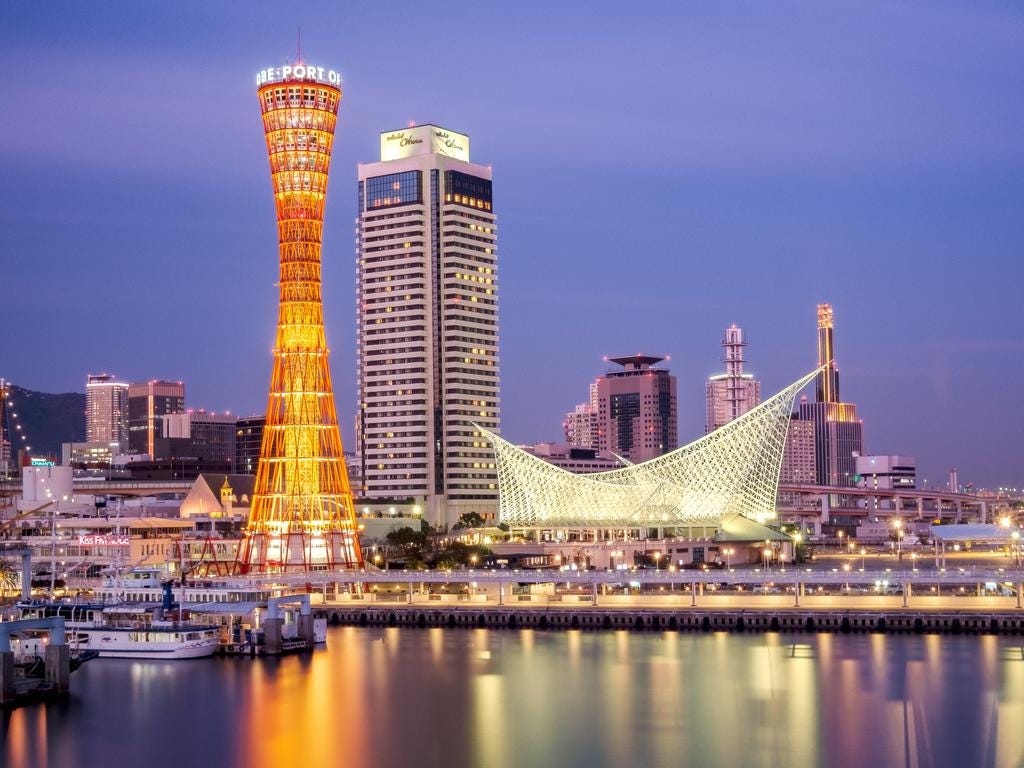
Kobe Travel Guide
Kobe’s reputation is based on tender beef and Mount Rokko, but there’s a lively sake culture and an impressive Chinatown to visit. Kobe also offers great restaurants and plenty of interest for shoppers, art and history nerds, and lovers of nature.
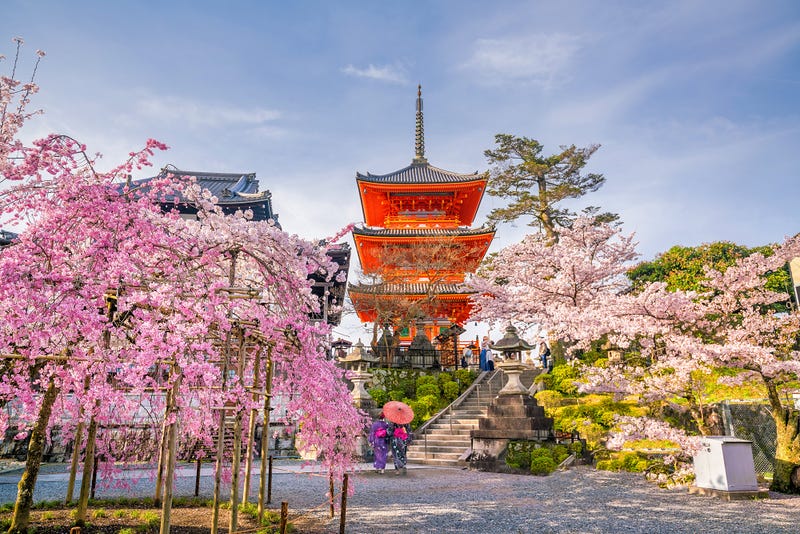

Can I Travel To Japan Now?
Japan is finally open! Travelers from most countries can now enter Japan without applying for a visa in advance. We have all the latest news on visiting Japan, including how to use the Visit Japan Web app , required for entering the country. You can also find up-to-date information on vaccination and testing requirements , and the rules around wearing masks .
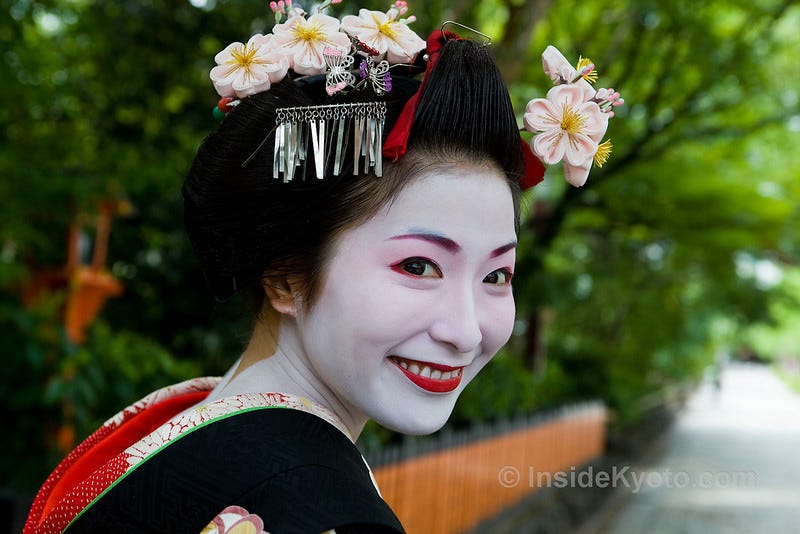
Kyoto Vacation Checklist
For all the essentials, see my First Time In Kyoto guide
For ideas on how to structure your trip, see my list of Kyoto Itineraries
See my one page guide on Where To Stay In Kyoto
You can buy a Japan SIM card or an unlimited data pocket wifi router online before you arrive in Japan for collection on arrival
View my comprehensive Packing List For Japan
Save a ton of money with the Japan Rail Pass
Why it's essential to have travel insurance for Japan
Visiting Tokyo or Osaka too?
Don't forget my companion websites InsideOsaka.com and TrulyTokyo.com for in-depth guides to these fascinating cities. Happy travels! Chris Rowthorn
Ready for more?

Japan Travel Hacks

Japan is one of the most unique destinations in the world and there are some things that you can see only here and nowhere else. Sometimes, it even feels like a whole different planet but Japan has its own charm and a lot of things to offer to tourists. In this section of our website, we’ll share some of our most helpful Japan travel hacks that will make visiting Japan a lot easier.
Basic Information About Japan

Japan is home to 126 million people.Around 97% of the total population consists of ethnic Japanese . The main minority ethnic groups are Chinese, Korean and other.
Official Language
The official language is Japanese.

Japan’s official currency is the Japanese Yen (currency code JPY). One Euro/USD is equal to roughly 118-108 JPY.
With a territory of 377,975 square kilometers, Japan is the 62nd largest country in the world. Japan is an archipelago and made up of four main islands and thousands of smaller ones. The terrains are mountainous and not enough fertile lands and because of the it the Japanese relied on the sea for many aspects of daily life. Trade with China and Korea became important to get the necessities.

Japan climate is mostly temperate but varies from North to South with four different seasons. Spring (March to May); summer (June to August) ; Autumn (September to November) ; and Winter (December to February). Each season has very different temperatures and climates.
Economy & Budget
Japan is a high income country and highly developed with free-market economy. Backpackers can survive with around $60-70 per day, while mid-range travelers spend between $100 and $120 per day on average.

Tokyo is the capital city of Japan with total population of 9 million.
Books to read before traveling to Japan
More japan travel hacks.


Japan Rail Pass Prices Have Increased By 70%! Here Are 7 Must-Know Travel Hacks To Save Money in Japan

It’s no secret that Singaporeans love visiting Japan . And as most Japan aficionados would know, the unlimited travel Japan Rail (JR) Pass is a cost effective way to get around Japan if you plan to visit different parts of the country.
But on 1 Oct 2023, we saw a whopping ~70% increase in the JR Pass price . After this crazy big price hike, is the JR Pass still worth purchasing? Maybe not…but we know Singaporeans. Our love for the land of the rising sun is not going to be diminished with the rising JR Pass prices. No—we’re headed to Japan regardless, and just need to find other ways to save money there instead.
Let’s take a look at what the JR Pass increase means for you, how to decide if it’ll still be worth getting, and 5 other must-know travel hacks to save money while travelling in Japan.
- The JR Pass is (for now) the most cost effective way to travel around Japan.
- The price of the JR Pass will increase by 68-77% from 1 Oct 2023.
- Is the JR Pass still worth it after the price increase?
- Japan travel hack #1: Take the bus
- Japan travel hack #2: Take domestic flights
- Japan travel hack #3: Take a night bus to save on accommodation costs
- Japan travel hack #4: Buy a regional JR Pass
- Japan travel hack #5: Visit free attractions
- Japan travel hack #6: Shop at a 100 Yen shop
- Japan travel hack #7: Buy food and drinks from vending machines
1. The JR Pass is (was?) the most cost effective way to travel around Japan.
The idea behind the JR Pass is simple: Pay a flat fee, and get to take unlimited train rides around the whole of Japan. If you’re going to be travelling to several parts of the country, the JR Pass is definitely more cost effective than buying rail tickets a la carte. Only available to tourists, the pass is ideal for travellers who want to see different parts of Japan during their trip. Travellers also have the option of a 7-day, 14-day, or 21-day pass, so it’s fairly flexible.
Sounds perfect for the avid adventurer in Japan? It is—or should we say, it was .
Back to top
2. The price of the JR Pass increased by 68-77% from 1 Oct 2023.
Yikes! The new JR Pass prices came into effect from 1 Oct 2023 onwards. Here are the price changes for adult JR Pass tickets for Ordinary Cars (the standard) and Green Cars (more premium):
The pass type worst hit by the price hike is the premium 7-day pass for a Green Car, which will now cost you ¥70,000 (S$681) instead of ¥39,600 (S$385). Its standard pass counterpart will set you back by ¥50,000 (S$486), up from ¥29,650 (S$288).
3. Is the JR Pass still worth it after the price increase?
We’ve done the math. If you do a 7-day trip in Japan and travel from Tokyo to Nagoya, Nagoya to Osaka, and Osaka to Fukuoka, you can expect to pay about ¥33,400 to ¥34,840 for your a la carte ticket prices:
At the old JR Pass rates, the JR Pass was slightly more cost effective than buying rail tickets individually—by about ¥3,750 (S$36) to ¥5,190 (S$50).
But now that the ¥29,650 pass has swelled to become a ¥50,000 one, it doesn’t look like the full JR Pass will be worth it. It’s only going to save you money if you add more stops (and thus spend fewer days at each stop) or travel further distances (and thus spend more time travelling on a train). To see if your itinerary is worth getting the JR Pass for, we recommend you use this free JR Pass calculator . Add the points of interest you want to visit, then scroll down to see how the cost of these a la carte tickets will compare to the cost of a JR Pass. You can also use any of the many free online rail ticket calculators online and compare them against the new JR Pass prices.
Here’s the bottom line: now that the JR Pass price has increased to ¥50,000, it’s quite likely that it isn’t worth getting for the average Japan traveller. The good news? There are other ways to save money while travelling in Japan.
4. Japan travel hack #1: Take the bus
If you have time but are short on money, consider taking a bus around Japan instead of the rail. Yes, bus rides are bound to take longer, but that’s fair since you get to take them at a lower cost. They’re also not heinously long; for example, the journey from Tokyo to Nagoya will take you about 6 hours by bus. That’s not too long to spend on a bus, albeit longer than the 1 hour 40 minutes you’d need to travel by bullet train.
Here’s a comparison of how much it’ll cost you via bus vs train for a 7-day trip going from Tokyo to Nagoya, Nagoya to Osaka, and Osaka to Fukuoka.
Taking the bus instead of the train could save you up to ¥25,020, which comes up to about S$243 over 7 days. So if you can, extend the length of your trip to budget for more travel time, while freeing up your actual budget. Spend the cash you save on the freshest sushi, historical and cultural attractions, and cute Japanese souvenirs instead.
Of course, if time is money to you, the rail might be a better choice. Use tools such as Japan Transit Planner to estimate journey times and prices on trains and buses, and ultimately decide which option is the most value for money for you.
5. Japan travel hack #2: Take domestic flights
You might be wondering, could I snag good deals for cheap domestic flights that beat or are comparable to the cost of travelling by train? Possibly, but only for certain routes. When we tried to check for flights from Tokyo to Nagoya, Nagoya to Osaka, and Osaka to Fukuoka, we got stuck on the middle leg of the journey. There were very few available flights, and those that were available either took 6 times as long as the journey by train, or cost up to 3 times the price.
Having said that, we spotted some really good domestic flight deals for the first and last leg of the journey. In combination with taking the train on the middle leg, the total cost came up to just S$288. Not only is this cheaper than the S$324 to S$338 you’d pay for the journey 100% by train, but it’s also going to be faster taking a plane.
6. Japan travel hack #3: Take a night bus to save on accommodation costs
We already know buses are cheaper than trains. But let’s take our cost saving one step further—to save on both transport and accommodation at the same time, take an overnight train. These bus journeys are usually 6 to 8 hours long, and are timed such that you’ll board the bus at night and reach your destination by the next morning.
Generally, night buses will cost more on Fridays and the weekend, while the cheapest rates are on the other weekdays from Monday to Thursday. Let’s assume you’re taking the bus on a Monday. Here’s what your journey cost and timings will look like on Willer Express:
When it comes to the most affordable mode of transportation, night buses are the clear winner. Our 7-day itinerary from Tokyo to Fukuoka will cost only about ¥10,200 (S$99), compared to up to ¥34,840 (S$338) on rail and up to ¥15,000 (S$145) for a regular daytime bus. That’s between $46 to S$239 worth of savings on top of the amount you save from not needing to book accommodations for the night.
7. Japan travel hack #4: Buy a regional JR Pass
Visiting spots within a particular area of Japan, but not travelling across the whole country? Wish there was some kinda half or partial JR Pass? You’re in luck, because the regional JR Passes are exactly that!
Like the full JR Pass, these regional versions offer unlimited rides via train for a fixed number of days. The main difference is that these regional JR Passes apply to specific areas of Japan only, and are of course also more affordable than the full JR Pass. Best part is, unlike the JR Pass, they’re not increasing in price this year (touch wood!). That’s going to make the difference in their prices even more stark.
There are many regional JR Passes, and we’ve covered them more extensively in our complete JR Pass review . But briefly, here are some popular passes that may appeal to you:
ALSO READ : 20 Free Things To Do in Tokyo (Explore Japan On A Budget!)
8. Japan travel hack #5: Visit free attractions
In Singapore, the best spots will cost tourists a pretty penny to visit. For example, an entrance ticket to the Flower Dome and Cloud Forest at Gardens by the Bay is priced at $53, while the full Singapore Flyer + Time Capsule experience will set a visitor back by $40. Visiting just 2 attractions a day will set one back by almost $100.
But for tourists visiting Japan, you’ll be glad to know that there are a good number of attractions that are completely free to visit. You’ll still need to pay bus/rail fees to get there, but once you do, you can just waltz right in to these places without paying a single yen:
- National parks : Did you know that all 34 of Japan’s national parks are free to visit? You also don’t need a permit to visit or stay, and there are no opening or closing hours to speak of.
View this post on Instagram A post shared by Laura Kell (@lauraandreakell)
- Hot springs a.k.a onsens : In Japan, there are both public and private hot springs. The public ones are free, but are, well, public. So stand tall and don’t be afraid to show what your mama gave you! Okay in all seriousness though, if that doesn’t sound like something you can do, pay for a private onsen experience instead. If you have tattoos, you should check ahead if the onsen is skin art friendly—some areas are more conservative, and tattoos are frowned upon. Psst , don’t know where to start? Our colleague recommends the onsen town Kusatsu Onsen !
- Shrines : Many shrines in Japan are free to visit, with the exception of some really touristy ones. For a start, check out the Fushimi Inari-taisha Shrine in Kyoto and the Meiji Jingu Shrine in Shibuya.
- Temples : Like the shrines, there are a good number of temples in Japan that don’t charge an entrance fee. One example is Tokyo’s oldest temple—the well-known, colourful Senso-ji Temple in Asakusa.
9. Japan travel hack #6: Shop at a 100 Yen shop
Remember the days when everything in Singapore’s Daiso shops cost $2 flat? Those everything-at-2-bucks-days are now a thing of the past. Now, each product from Daiso will cost you something between an awkward $2.14 to an equally awkward S$25.47.
In Japan, Daiso is just one of many 100 yen shop options that remain true to their affordable dollar-store concept. Take your pick from Daiso, Seria, Watts, and Can Do, which altogether have over 5,500 locations across the country. Some of these are multi-storey, department store style behemoths! You can expect to find tableware, kitchenware, tools, gardening items, stationery, and just random fun things you never knew you needed. I’m sure you know what it’s like to get lost in a Daiso-esque wonderland.
ALSO READ : What to Buy in Japan: Tokyo Banana, Shiroi Koibito Cookies & More Japanese Snack Prices
10. Japan travel hack #7: Buy food and drinks from vending machines
It might be tempting to visit a boutique cafe in Japan and fork out between ¥800 (S$7.80) and ¥1,000 (S$9.70) for your coffee fix for the vibes. But if once is enough for you, there’s a cheaper way to fill up on your daily caffeine quota the rest of the days you spend in Japan—visit a vending machine.
There are tons of coffee vending machines that you can find practically everywhere in Japan. It’s said that there is 1 vending machine for every 23 residents, and Japan has the highest density of vending machines in the world. These machines dispense both hot and cold drink options for both coffee and tea, and at a fraction of the price you’d pay at a larger coffee chain or cafe. Expect to pay only ¥100 to ¥200 for your cuppa, which is just S$1 or S$2!
View this post on Instagram A post shared by 暮らしの古民具・器こっころ (@antique_coccolo)
While vending machines selling beverages make up more than half of Japan’s 4 million food and drink dispensers, there are a good number of food options as well. Don’t think that these machines only sell packaged potato chips and chocolate bars, or that something out of a machine can’t taste fresh and good. These days, Japanese vending machines even dish out caviar, fresh sashimi, and wagyu steak.
Know a friend or family member going to Japan? Share these travel hacks with them!
Related Articles
JR Pass Singapore—The Ultimate Guide to Japan Rail Pass Types & Prices (2023)
What to Buy in Japan: Tokyo Banana, Shiroi Koibito Cookies & More Japanese Snack Prices
Top Things to Do in Tokyo, Japan – 20 Free Tours & Activities to Try!
Best Travel Destinations and What To Do There, According to MoneySmart Staff
4 Awesome Japanese Destinations that are Cheaper to Visit than Tokyo

- Dividend Investing
- Invest Money
- Travel Hacks
- Passive Income
- Personal Finance
- Make Money Online
- My Dividend Investing Book
- Building a Dividend Portfolio
- Best Investing Apps
- M1 Finance Review
- Best Robo-Advisors
- Free Dividend Calculator
- Free Dividend Discount Model
- 23+ Online Jobs
- Best Cashback Apps
- Best 401(k) Fee Calculator
- Best Freelance Websites
Top Must-Have Travel Hacks When Visiting Japan
Travel Hacking - Janice Friedman - September 14, 2018
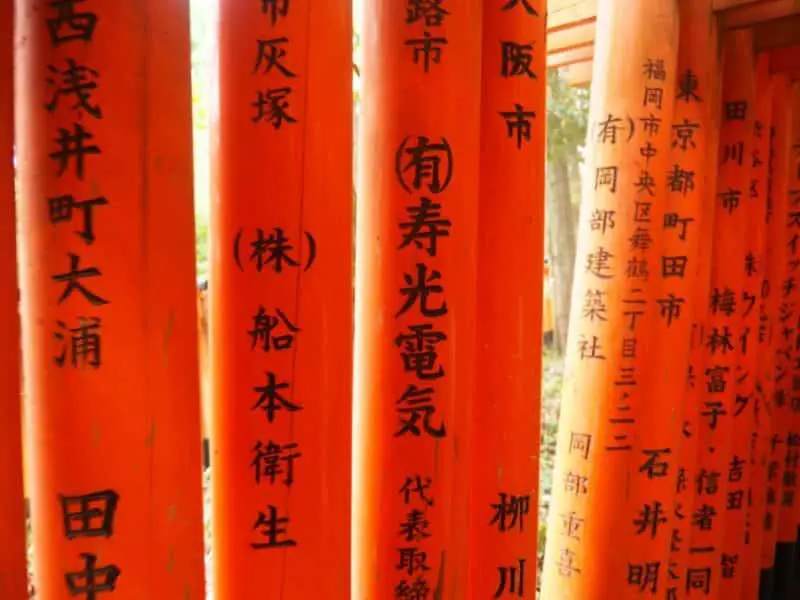
A trip to Japan is a must do for any avid traveler. Here are our favorite Japan travel hacks to help you save time, money and have a better experience.
Travel hacking is one of my favorite hobbies. Through travel hacking, I can travel around the world for little to no cost. There are a number of different components to travel hacking to consider.
I’d love to clarify the definition of travel hacking from the perspective of Millionaire Mob.
What is travel hacking?
Travel hacking includes a number of different components, so I want to be clear that our ‘travel hacks’ for Japan include mainly items that are important when you get there. The way Millionaire Mob considers travel hacking is through these core components:
- Credit card churning : Credit card churning is the act of opening credit cards solely for the benefit of the sign-up bonus. With credit card churning, you are able to earn significant rewards points in a relatively short period of time. Churning credit cards is a marathon and not a sprint. Read more on the basics of credit card churning .
- Manufactured spending : Manufactured spending is spending money artificially that can be used to generate additional points or use artificially spend to accelerate the minimum spending requirement necessary to achieve the sign-up bonus. Manufacturing credit card spending is not for everyone. Here is our manufactured spending guide .
- Travel hacks without a credit card : Travel hacks without a credit card are the small things that you do on your travel. The in-betweens. These small travel hacks are usually specific to a particular destination or county. These small travel hacks add up and are important to save you time, money and have an overall better travel experience. Here is an example of over 23 ways to participate in travel hacking without a credit card .
- Booking award travel efficiently and effectively : Booking award travel is important since you want to optimize all of those hard-earned points. No need to throw away points just because you want to book a trip. You need to ensure that you are booking your travel at the most favorable conversion rates. These are some of my favorite tools to book award travel .
In order to be a good travel hacker, you need to cover off on a few of the above components. Use my free credit card tracker to help you monitor your churning portfolio.
You don’t necessarily need to participate in all of the above components of travel hacking. For me, I like to participate to unlock amazing experiences around the world.
If travel hacking with a credit card is not for you, then consider booking your trip via Priceline and CheapOAir .
List of the Best Japan Travel Hacks
Japan travel hacks are important. Depending on where you are coming from, the trip over to Asia can be an eye-opening experience.
I mainly spent about 4 days in Tokyo, 3 days in Kyoto and a day near Mount Fuji. There are plenty of weird things to do in Tokyo , which keeps things interesting.
Whether you are visiting Tokyo Disneyland or the mountains , you need to have the necessary travel hacks in place to make the most out of your experience. Japan was a new country for me and so I had a lot of learning to do. I compiled travel hacks to ensure you don’t make the same mistakes as me.
Some of my favorite travel hacks in Japan will save you time, save you money and help you have an overall better experience during your travel.
Buy docomo wi-fi before getting on the Shinkansen
I absolutely love working on trains, planes and (sometimes) automobiles. There’s nothing better than getting things done while in transit. Efficiency is everything!
I made a huge mistake of not purchasing a wi-fi docomo pass for the Shinkansen (the Japanese bullet train). For my train rides, I love using this free time to work. I ended up slotting a bunch of work time for my train ride that ended up being nearly completely lost due to not having wi-fi.
I’m usually pretty efficient, so I found ways to work without wi-fi… Thank you Microsoft Outlook! Purchase a day pass for docomo wi-fi for around $3. There are plenty of spots that have docomo beyond the Shinkansen too!
Use the Japan rail pass as much as possible and book early
The Japan rail pass is an excellent way to travel around the entire country for a one-time fee. The Japanese railway system is one of the most effective and efficient operations in the world. I was amazed at how easy I could get around.
One thing that people don’t realize is that the Japan rail pass actually works for a number of different train lines throughout Tokyo. In Tokyo, there is the subway system and the Japan Rail (JR) system. They both work just as effectively, but Google maps will often defer you to use the subway because they run slightly more often than the JR. However, if you buy a Japan rail pass you have unlimited rides on the Japan Rail system, so avoid the cost of the subway and ride for ‘free’ all around Tokyo.
Get the most bang for your buck with your Japan rail pass and opt for riding Japan Rail (JR) rather than the subway system. If you take the subway from Tokyo city center, purchase the cheapest fare and upon exit just show your Japan rail pass.
Another piece of the Japan Rail Pass is that you will need your pass to be shipped to your address in advance of your trip.
Also, once you receive your pass you will need to activate your pass at one of the major rail stations. Save this for the best day when you will start traveling on the Japan rail. This will ensure that your pass won’t run out before you leave.
Once you have activated your Japan rail pass, talk to the agent at the train station that activated it to book all of your train times on the spot. This will ensure that you plan out all of your train times right there and then.
The lines can get very long for booking rail tickets, so avoid doing this each time you want to ride the Japan rail and just do it all upfront upon activation. This saved me a ton of time!
That made it very easy for me when we traveled from Kyoto to Hakone and stayed at Hyosekikaku . If you need an analysis on the Japan rail pass, here is a guide on if the Japan rail pass is worth it .
Order sushi / sashimi a la carte to save money and get what you want
Ordering sushi and sashimi in Japan should be straightforward. However, the language barrier can limit your ability to know what you are truly getting with a sashimi plate. If you are an adventurous one, you can order your sashimi plate and simply eat the seafood. That can be risky as well because not all fish is delicious.
Most people do not realize that you simply need to ask the restaurant for an a la carte menu to order the sashimi of your choice. You can then craft your own plate of variations that include the fish that you enjoy.
This may be more or less expensive depending on the type of sashimi that you order.
This Japan travel hack is truly based on personal preference, but most people don’t know that you can order a la carte at nearly every place. Most restaurants want you to pay the premium price for the pre-set sashimi plates!
Prepare for a wi-fi disabled trip
One of my favorite components about international travel is going nearly completely (clearly… see above) off the grid. I like to prepare in advance for any unexpected travel.
Not many people realize that even if you don’t have internet, Google maps will still show your location since it is based off GPS and doesn’t require internet or data connection. Prepare for locations and landmark in advance by saving them to your Google maps profile. This will allow you to have a walking map completely wireless internet free while walking around town.
Another way to prepare for a wi-fi disabled trip is to download the Google Translate app for offline. This is a great way to break through the language barrier . All you have to do is scan the language and the English translation will appear.
Don’t carry disposable trash with you
Carrying and consuming food or drinks in public is not customary for Japanese citizens. Therefore, they simply don’t have much public trash cans for use while walking down the street. I couldn’t tell you how many times I had a water bottle or two in my hand and was unable to throw it away.
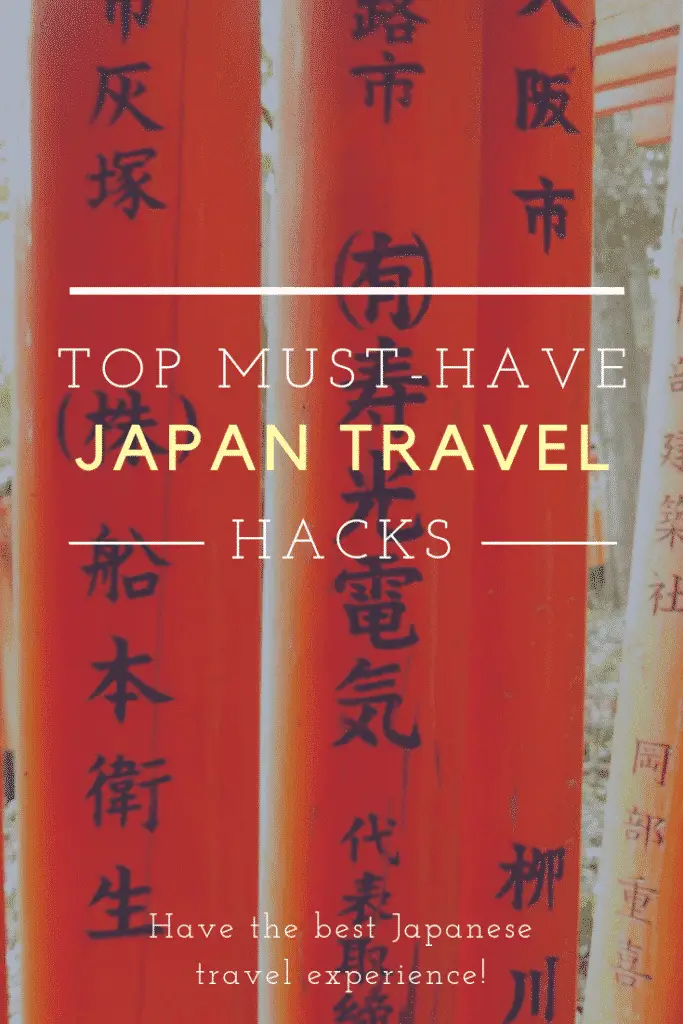
What travel hacks do you use in Japan?
In Tokyo, you cannot find trash cans on the street either. Tokyo is such a clean city I was amazed. Live like a Japanese citizen and avoid taking food or drink to-go. Eat and drink what you need in a private setting.
Read up on some Japanese etiquette before you make the trip.
Travel Hacks Japan Conclusion
International travel can be overwhelming at times. Don’t let it be. International travel is a journey. Embrace it. My experiences in Japan can help serve as a guide to not the same mistakes that I made.
Use these travel hacks to be a smart traveler and to travel like a pro. Small travel hacks like these boost your experience and help you avoid those arguments with your travel partners. Check out our other travel hacking tips like becoming a digital nomad .
Money + Travel = Freedom
Japan is an amazing country. You will enjoy every second of it.
What are you most excited for during your trip to Japan? Let us know of your favorite Japan travel hacks in the comments below. I’d love to hear from you.
Related Resources:
- My 2 Days in Amsterdam Itinerary
- Mistakes to Avoid with Travel Hacking
- VAT Reclaim Overview to Receive Your Tax Refunds
Join our community of over 3,000 mobsters seeking financial freedom. What are you waiting for?
About Author / Janice Friedman
You might also like.

Best Credit Cards to Churn: Travel the World With Travel Hacking

The Ultimate Guide to the Southwest Airlines Companion Pass

Ways to Make Money from Traveling: Become a Personal Travel Photographer!
We spent just over $1600 Canadian all in for our 11 night trip to Japan. That included business class tickets for all FIVE of us and our hotels etc.
http://www.somewhatoutthere.com/11-nights-japan-1630-16/
In lieu of the rail pass, we opted for round trip intra Japan tickets using British Airways Avios points on Japan Airlines.
We used similar dining strategies to you.
Leave a Reply Cancel Reply
Your email address will not be published. Required fields are marked *
Secure Your Financial Future!
Sign up for free below and get the following, advice on how to build real wealth, free access to my best-selling book.

My Secret Wakayama: Japan’s Hidden Gem
Japan’s big cities are intoxicating. Fast paced and modern, destinations like Tokyo, Kyoto and Osaka are unlike anywhere else on earth, so it’s little surprise that they’re becoming more and more popular with travellers from Britain and beyond. But these cities, heady and irresistible as they are, don’t offer visitors the full picture of a …
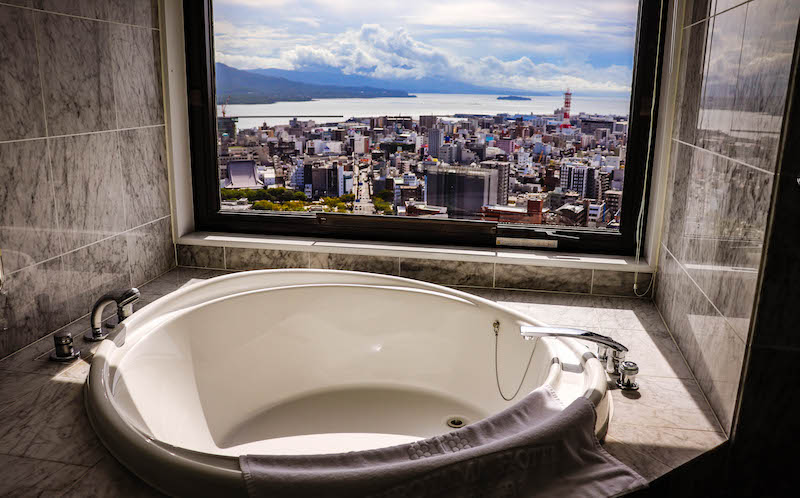
Kagoshima in Japan: 11 reasons to visit and things to do in Kagoshima
Pip from Pip in the City recently visited Kagoshima in Japan for The Travel Hack and today she’s sharing the best things to do in Kagoshima and why she thinks you should visit! This trip was supported by Tokyo Metropolitan Government. Imagine a city where the centrepiece is a gigantic, active volcano, spewing out …
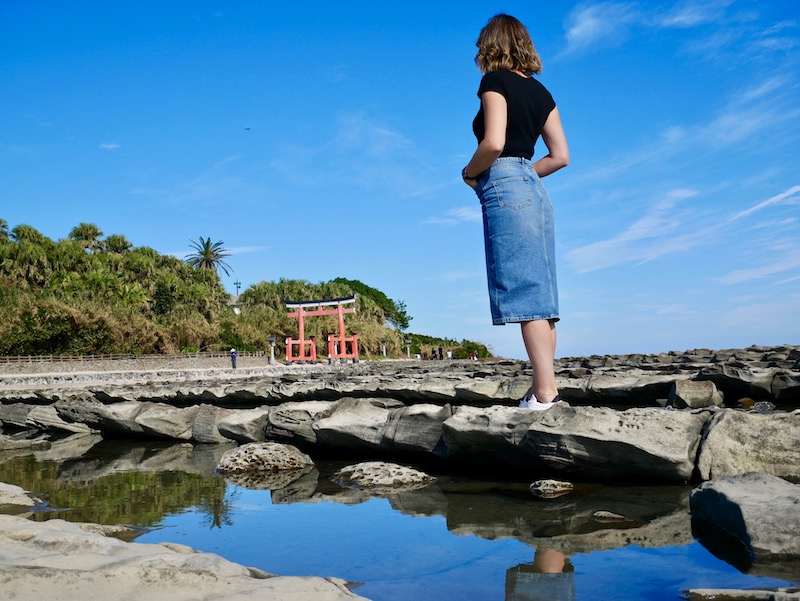
3 days in Miyazaki Prefecture, Japan
You’d be forgiven if you’d never heard of Miyazaki Prefecture in Japan. I did a poll on my Instagram stories and 95% of people said they didn’t know where it was and I have a sneaking suspicion that the 5% who did know about Miyazaki were the friends I told in the pub the night …
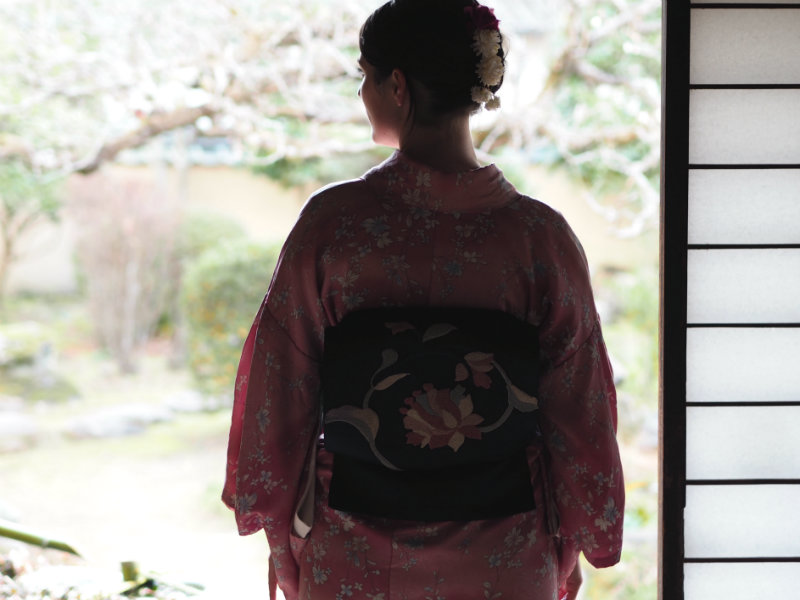
Learning How to Wear a Kimono in Japan
There’s no denying that a Japanese kimono is a thing of beauty. It’s elegant, traditional and more than just a little bit cool. But there’s one thing that a kimono is not. A kimono is absolutely not easy to put on, as I learned when I visited Kitsuki Castle Town in Japan’s Oita Prefecture. This …
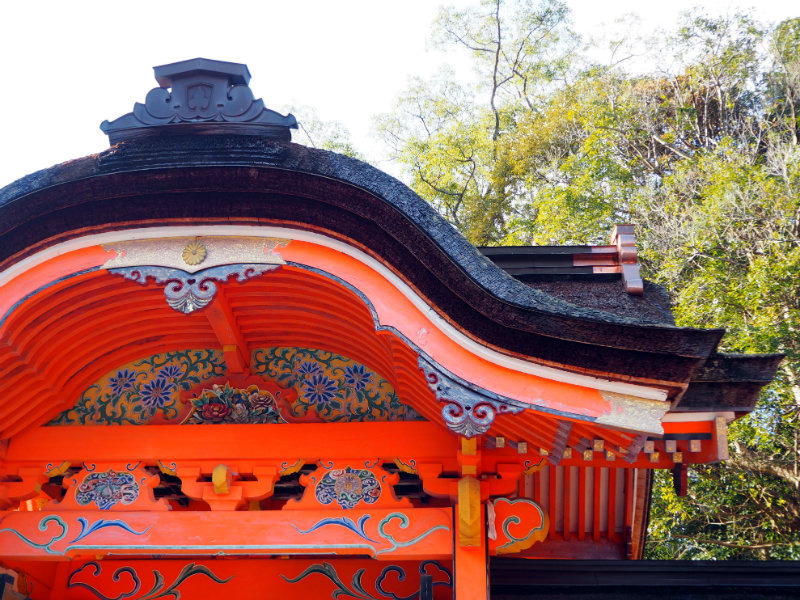
5 Unmissable Sights in Oita Prefecture, Japan
In a small corner of Japan’s southwestern Kyushu Island, the little-known destination of Oita Prefecture awaits. It’s a region that boasts plenty of natural beauty – think hot springs, mountains and beaches – as well as a rich cultural and religious heritage. Oh, and mouthwatering food. I landed in the Prefecture’s capital, the city of Oita, just …
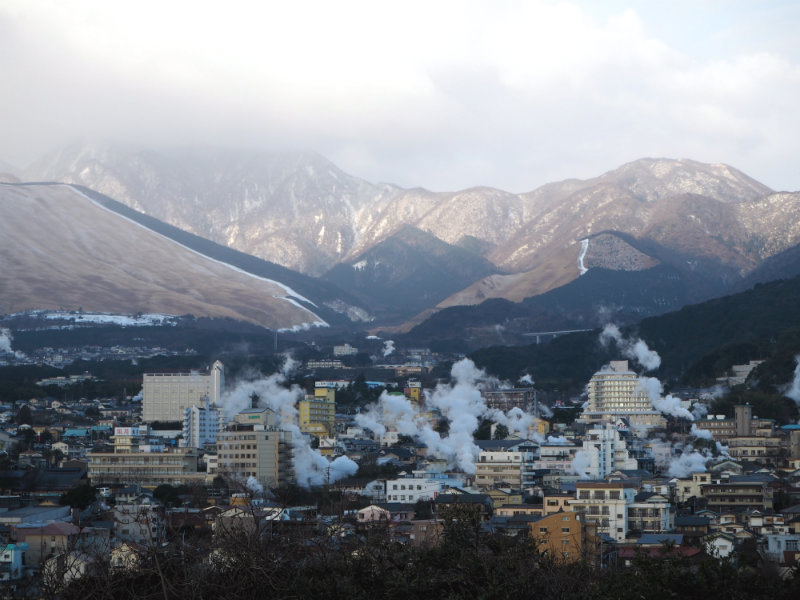
What to do at a Japanese onsen – a guide for beginners
The first thing I noticed about my hotel room was that there was no bed. Curious, I looked in cupboards and searched for hidden panels in the wall where perhaps a Murphy bed could be hiding. Nothing. Then it dawned on me. My room search had revealed that another fairly important feature was missing from …

One day in Tokyo, Japan – sushi, sightseeing & shopping
With just one day in Tokyo, an enormous city bursting with sights and flavours and jaw-dropping contrasts, how much can you really see? This was the unenviable task that Sam, my guide, was given when he met me at Asakusa View Hotel on a sunny Sunday morning. I’ve been to Tokyo before, briefly and many …
Inside Kyoto
A Kyoto Travel Guide
iPhone: The Killer Japan Travel Hack
IC cards (Suica, Pasmo, Icoca etc) make life so much easier in Japan. You can pay for nearly everything with them: local transport, convenience stores, restaurants, taxis, vending machines etc. But it’s getting much harder to buy physical IC cards. Luckily, if you’ve got an iPhone, you can (probably) get a digital IC card. Here are all the details.

Physical IC Cards Are Getting Hard to Get
Until recently, you could buy regular Suica and Pasmo cards from vending machines in Japan. However, due to chip shortages, this is no longer possible. However, you can buy IC cards designed for tourists at certain locations: Welcome Suica cards are available from vending machines at Haneda and Narita airports; and Pasmo Passport cards are available at counters at Narita and Haneda and certain locations in Tokyo. For all the details, see How To Get A Prepaid Travel Card in 2024 . The problem is, the lines and the machines and counters can be very long. If you’re in Kansai, however, you can still buy physical Icoca cards (which work the same as Suica and Pasmo) from vending machines at most JR stations there.

You Can Get a Digital IC Card on Your iPhone
If you’ve got an iPhone, you may be able to get a digital IC card and avoid all the hassles of trying to get a physical IC card. If you’ve got Apple Wallet on your phone, and it’s linked to a MasterCard, Apple Card or American Express card, you’re good to go. For some strange reason, this won’t work with a Visa card.

How to Add a Digital Suica Card to Your Apple Wallet
Simply do this:
- Open Apple Wallet
- Tap + sign or “add”
- Tap “transit card”
- Find “Suica” on the list
- Add value to card (this will be charged to the credit card linked to your Apple Wallet)
This process is described on the Apple site here . Just note that you cannot charge your digital Suica with a Visa card, even if that card is linked to your Apple Wallet. You can charge the digital Suica with a MasterCard, American Express or Apple Card that is linked to Apple Wallet. Be warned, however, that certain MasterCard or American Express cards can’t be linked to Apple Wallet. You can usually find out if your card works with Apple Wallet by checking the website of the issuing bank or card provider.
How to Charge Your Digital Suica Card
As long as you’ve got a MasterCard, American Express or Apple card linked to your Apple Wallet, you can easily charge your digital Suica card just by tapping a few things on your phone. You can also charge your digital Suica card on certain IC card machines at larger JR stations in Japan and at most convenience stores in Japan. At JR stations, look for the IC card machines (Suica, Icoca etc) and find one that has a tray large enough to hold your phone (don’t jam your phone into one not designed to hold a phone as it may get stuck). At convenience stores, just hold up your phone to the cashier and say “charge.” In both cases, you must use Japanese cash to charge the digital IC on your phone (ie, you cannot use a credit card).

What If You Cannot Link a Card to Apple Wallet? Is There a Workaround?
Yes! What you can do is buy a physical Icoca card at any major JR train station in the Kansai area of Japan (including at Kansai Airport). Then, you can import your physical Icoca card into your Apple Wallet. It will import the remaining balance on the card. This process is described here . Thereafter, you can charge your Icoca card at IC card machines and convenience stores in Japan, as described in the previous section. Obviously, the shortcoming of this method is that you won’t be able to get an IC card on your phone until you get to Kansai. But you could always buy a Welcome Suica or Pasmo Passport in Tokyo and then switch to a digital Icoca when you get to Kansai.

Install a Digital IC Card Before Arriving and Skip the Lines at the Airport
If you install your digital IC card before arriving in Japan, you’ll be able to skip the lines at Narita and Haneda airports. At Narita, you can use the digital Suica to pass through the turnstiles for the JR lines. Then, you can use it to buy a reserved seat for the Narita Express from reserved seat ticket machines on the platform. At Haneda, you can use the digital Suica to cover your fare on the Tokyo Monorail or Keikyu line (no reserved seat ticket needed). I describe this in more detail on my Top 10 Japan Travel Hacks page.
What Can You Pay with a Digital IC Card?
Here are some places and things you can pay with a digital IC card like Suica, Welcome Suica, Pasmo, Passmo Passort and Icoca:
- local trains (both JR and private lines)
- local buses
- convenience stores
- many restaurants
- coin lockers
- vending machines
How to Pay with a Digital IC Card
It’s extremely easy to use a digital IC card. Essentially, just imagine that your phone is a big IC card. There is a chip in the phone near the camara lenses of the phone (ie, near the top of the phone). In most cases, your phone does not have to unlocked to make the payment. At stores, there will be a card reader near the cash register. Just hold up your phone at the cashier and they will understand that you want to pay with an IC card (in this case, a digital IC card). They will indicate when you should tap your phone on the reader. If they look confused, just say “Suica” (sounds like “Sue E Kah”). At train stations, look for the turnstile with the symbol for IC cards (tap your phone when you enter the system and leave the system). On buses, look for the IC reader. In taxis, tell the driver you want to pay by IC card and he will hold the reader out to you. Just note that “IC” is pronounced “Eye She” in Japanese.
The Final Killer Hack That Just Might Work for You: SmartEX for Shinkansen Tickets
The best thing about a digital IC card like Suica or Icoca is that it frees you from having to handle cash or credit cards for your purchases. On days when you’re not traveling on shinkansen, you can really just get around with your iPhone (of course, you should carry some cash and a credit card as a backup). But, if you really want to free yourself from cash and cards, even on the shinkansen, you might just be able to make this one work: the SmartEX for shinkansen tickets.

SmartEX is an app that allows you to buy shinkansen tickets online with your phone. You can then link SmartEX to your digital IC card and you no longer need a physical ticket. Your digital IC card “stores” your ticket information so you just have to tap your phone when you pass through the shinkansen turnstiles. The machine actually produces a seat information ticket that you grab as you pass through the turnstiles. If you’ve bought an unreserved ticket, it just shows your departure and arrival station.
Unfortunately, there’s one huge problem with this method: SmartEX must be linked to a credit card. It doesn’t work off of Apple Wallet – you must separately link SmartEX to a credit card. And, it won’t work with most foreign credit cards. This has something to do with the 3D security system that SmartEx uses. However, some foreign credit cards do work with SmartEX. It’s worth a try, but don’t spend too long on it. We expect that SmartEX will change their system to allow foreigners to use the app more easily in the future.
Kyoto Vacation Checklist
- For all the essentials in a brief overview, see my First Time In Kyoto guide
- Check Kyoto accommodation availability on Booking.com and Agoda.com - often you can book with no upfront payment and free cancellation
- You can buy shinkansen (bullet train) tickets online from Klook - popular routes include Tokyo to Kyoto , Kyoto to Osaka and Kyoto to Tokyo
- Need tips on where to stay? See my one page guide Where To Stay In Kyoto
- See my comprehensive Packing List For Japan
- Buy a data-only SIM card online for collection when you arrive at Kansai International Airport (for Osaka and Kyoto) or Tokyo's Narita Airport . Or rent an unlimited data pocket wifi router
- Compare Japan flight prices and timings to find the best deals
- If you're making frequent train journeys during your visit, you might save money with Japan Rail Pass – see if it's worth it for you
- A prepaid Welcome Suica card makes travelling around Kyoto easy – here's how
- World Nomads offers simple and flexible travel insurance. Buy at home or while traveling and claim online from anywhere in the world
Kyoto District Map

- Central Kyoto
- Northwest Kyoto
- Northern Higashiyama
- Southern Higashiyama
- Downtown Kyoto
- Kyoto Station Area
- South East Kyoto
Disclosure: InsideKyoto.com is a participant in the Amazon Services LLC Associates Program, an affiliate advertising program designed to provide a means for sites to earn advertising fees by advertising and linking to amazon.com and amazon.co.uk. World Nomads provides travel insurance for travellers in over 100 countries. As an affiliate, we receive a fee when you get a quote from World Nomads using this link. We do not represent World Nomads. This is information only and not a recommendation to buy travel insurance.
- How to Use Points for Free Flights
- The Best Carry-On Luggage
- The Ultimate Guide to Traveling Like a Pro
- My Favorite Travel Credit Cards
- lake louise
- new orleans
- new york city
- palm springs
- packing lists
- product reviews
- How to Use Vitamin C Serum
- Easy Step-by-Step Skincare Routine
- Drunk Elephant: Best & Worst Products
- Fitness & Wellness
- How I Edit My Photos for Instagram
- Furniture My Interior Designer Loves
- Best Strapless Bras
- blogging & business
- Amazon Finds
- Hotel Lobby Candle
- Shop My Faves
- Promo Codes and Discounts
- Shop My Instagram

70 Travel Hacks That Will Change Your Travel Game Forever

With 57 countries under my belt and more than a decade of traveling regularly, I think it’s safe to say that I’m an expert in the field. I’ve made every mistake you could imagine—missed flights, lost baggage, exploding hair irons—but with each disastrous experience, I’ve grown a little bit wiser, and a LOT savvier when it comes to traveling like a seasoned pro.
These travel hacks for flying, packing, saving money, getting hotel upgrades and more are the secrets I swear by. I hope they’ll help make your next trip pleasurable, memorable, and stress-free.
70 Travel Hacks That Will Blow Your Mind
1. use my “contact lens case” hack for makeup and skincare products ..
This is one of my best space saving packing hacks. People tend to take up unnecessary room in their toiletry bags by bringing full-sized products.
Here’s the trick: put your foundation, moisturizer, eye cream , and any other liquid products into contact lens cases. Every inch counts!
2. Be strategic in your seat selection when booking a flight.
There’s nothing worse than getting stuck in a seat that doesn’t recline, or ending up in a row next to the lavatory with people hovering over you for the entire flight. I avoid these kind of mishaps by checking SeatGuru before I choose my seat on flights.
Occasionally, I’ll even choose a flight based on the type of plane that SeatGuru tells me I’ll be flying on. The website and app shows you photos of the plane’s interior so you’ll know in advance whether you’re booking an outdated 747, or a brand spanking new plane.
Plus, it gives you warnings about seats that have potential issues, like limited recline or a misaligned window.
3. Pack your own DIY amenity kit for long-haul flights.
I loooove the amenity kits that you get when you fly First or Business, but since I don’t always have that luxury, I decided to start making my own. My “DIY kit” stays in my carry-on bag at all times, and includes a toothbrush and toothpaste, deodorant, sheet masks, moisturizer, hand cream, eye masks , lip balm, and socks.
4. Avoid cankles by wearing compression socks.
They’re basically Spanx for your calves and feet, because feeling swollen after a long-haul flight is the WORST.
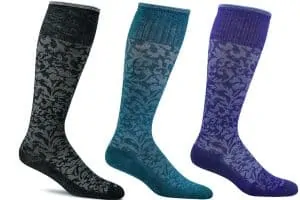
5. Consider choosing an “alternate destination” when you search.
If the city you’re flying in or out of isn’t a main hub, consider flying into a bigger city and connecting or finding a flight (or other mode of transportation) out of that city.
Not only will you save money, but you have the potential to earn more mileage points.
6. Download the Google Translate app to help with language barriers.
You can use it to take photos of text in another language, and it will translate the words in real time. (I have a separate blog post featuring the best travel apps for savvy jetsetters , which you should check out as well!)
7. Use packing cubes.
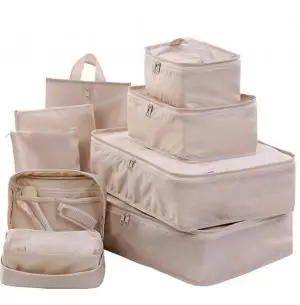
Another space saving packing hack that I swear by? Packing cubes! I truthfully thought these were a scam until I tried them out for myself.
They not only compress your items to give you additional space, but they also help keep you organized—I use a small one for socks and underwear, a medium-sized one for tops, another medium-sized one for comfortable walking shoes and sneakers , and a large one for jeans , pants, and dresses.
8. Look out for price errors.
Often times, there will be glitches on airline or third party sites that offer a ridiculous low fare. Sign up to these sites to keep an eye on them. But know that you will have to act quick, as these companies will typically fix the fare as soon as they catch it. Here are some great resources to keep an eye on for low fare deals.
- Scott’s Cheap Flights (or Jack’s Flight Club for UK-based people)
- The Flight Deal
- Secret Flying (if you’re based out of Europe)
- Holiday Pirates
- Airfarewatchdog.com
- FlyerTalk Mileage Run (discussion board)
* Bonus Tip: Fill your social media with these sleuths by following them on Instagram and Twitter!
9. Take advantage of generous credit card offers.

The greatest travel hack of all time? Credit cards and points. Open up a credit card that has a sign-up bonus (assuming you can be responsible enough to pay your bills!), and transfer the points to an airline for a pricey international flight.
Check out my full step-by-step guide to using points and miles for free travel if you haven’t already!
10. Be strategic with flight cancellations.
If you book a nonrefundable ticket and your plans change or you know you won’t be traveling on that flight—do not cancel the ticket until the last possible moment.
Or…just don’t show up. Here’s why: in the rare case that there’s a flight cancellation or schedule change, your nonrefundable ticket could entitle you to a credit or refund. Had you cancelled the ticket, you wouldn’t be entitled to anything.
11. Learn how to avoid long airport security lines.
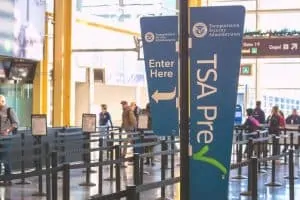
TSA-precheck, Global Traveler, and Clear have been an absolute gamechanger for me, and if you travel more than a few times a year, they are absolutely something worth investing in. If you’re not familiar:
- TSA Precheck enables you to use a separate line for domestic (US) flights, and you won’t be required to take off your shoes or take out your laptop.
- Global Traveler is for international flights and (as far as I know) is for the US only. When you’re returning to the US, you use a machine that scans your passport rather than having to wait in line at customs.
- Clear lets you scan your fingertips at security and then get escorted to the front of line at airports where it is offered.
12. Take a hydration multiplier for long flights.

While everyone will tell you to “drink as much water as possible” and “try to stay hydrated” on a long-haul flights, the reality is that if you’re drinking a liter of water on a plane, you’re going to find yourself getting up to go to the bathroom repeatedly.
My hack for this is to use Liquid IV. It’s a “hydration multiplier” that hydrates you 2-3 times faster than water alone. You pour the little packet of powder into your water bottle, shake it up, and then drink.
It tastes pretty similar to Gatorade (the lemon/lime is my preferred flavor) and will keep you hydrated without sending you to use the restroom every 30 seconds.
13. Keep track of itinerary ideas in Google Docs.
I use Google Docs for all of my itineraries—especially when I’m planning a girls trip and there are multiple people involved. I’ll share the link with everyone I’m traveling with to make it more collaborative. It’s also where I keep a running list of recommendations from people for the destination that I’m visiting.
14. Challenge yourself not to check a bag.
Avoid lost baggage nightmares by packing carry-on only for trips under a week. In need of luggage that actually fits a lot of stuff? Here’s a list of the best carry-on bags that help save space with packing.
15. Order a “special meal” in advance of a long-haul flight.

Most major airlines will offer the option to order a special meal when you book your flight—these include vegetarian, gluten-free, dairy-free, kosher, vegan, low fat, and sometimes even low sodium options.
People who place orders for “special meals” will always get served first, so if you’re hoping to catch some z’s on the flight, you’ll have more time to sleep while everyone else is waiting for their food to arrive.
16. Save local currency from the country you’re visiting as a souvenir.
My husband and I started doing this many years ago, and now we have what we jokingly call a “world bank” at home. It’s a cool alternative to buying a dumb keychain or t-shirt you’ll never wear.
17. Create a framed collage of foreign currency from your trips after you get home.

I often find foreign currency to be incredibly beautiful. We’ve taken some of the best-looking bills from various places we’ve visited, and framed them.
18. Do the same with hotel room keys, airline tickets, and baggage tags.
You can use a place like Framebridge to arrange and frame them for you—they’ll even send you a pre-paid envelope to mail in your items.
19. Talk to taxi drivers.
Often, a simple taxi ride from the airport to your hotel will turn into an impromptu city tour if you ask the right questions.
20. Build your itinerary using Go ogle Maps Trip Planner.

This might be the greatest travel hack of all time. Did you know that there’s a FREE tool within Google Maps that you can use to create an entire itinerary for your next trip? It’s called Google Maps Trip Planner and it’s incredible.
21. Don’t exchange money at the airport.
Wait and go to an ATM near your hotel for better exchange rates.
22. Take advantage of layovers as often as possible.
Sometimes, I’ll even choose flights with 12+ hour layovers as a way to see another city for a day.
23. Never miss another photo opp.
Take photos in “burst” mode so you don’t need to worry about missing the shot.

24. Carry a photocopy of your passport in your wallet.
Just in case.
25. Speaking of wallets… invest in a good travel wallet.
Trying to keep track of boarding passes, passport photocopies, foreign currency, and receipts can get a bit messy if you’re trying to stuff everything into your regular, everyday wallet.
The best way to stay organized while you’re heading out of town is to use an inexpensive but chic travel wallet that has additional compartments for travel-related items.

26. Use a travel agent or tour operator for special trips or multi-city itineraries.
They can often get you better rates and preferential treatment at hotels.
27. Become a points and miles pro.
I’ve said it before and I’ll say it again—I’ve learned everything I know about points, miles, and travel hacks from my friend Brian Kelly, aka The Points Guy . Browse through his site for all the secrets.
28. Easily share photos with friends/family.
Start a shared album with your the people you’re traveling with at the beginning of a trip, so you’re able to easily exchange photos.
29. Get the experience of a luxury hotel without staying at one.
Dying to stay at a fancy hotel but can’t afford the nightly rate? Pop in to the lobby bar for drinks instead.
30. Plan your trip during “shoulder season” to take advantage of better hotel rates and less crowds.
Shoulder season = the period between high and low season, when the weather is still great but the destination is less busy. In places like Positano , Santorini , and Mykonos for example, shoulder season is generally April through the middle of June, and September through October.

31. Avoid jetlag by getting onto the local time zone as soon as you board the plane.
If it’s technically morning in the destination you’re going to when you board the plane, do NOT go to sleep—even if it’s midnight where you’re leaving from. If you work on adjusting to the time zone while on the flight, you’ll have a better chance of battling jet lag when you arrive.
32. Hire a local guide during the first day of your trip in a foreign city.
It’ll help you get the lay of the land. Then ask your guide for non-touristy recommendations to hit up during the rest of your trip. Also: if you’re traveling with a big group, DEFINITELY hire a guide. It takes the pressure off of one person being put in charge of the itinerary.
One of the best things I’ve ever done was hire a guide for my five-day trip to Tokyo since I wanted to see as many things as I could in a short period of time.
33. Use a sheet mask on long flights to replenish the moisture back into your skin.
I love using these sheet masks on the plane. Instead of looking haggard when you land, your skin looks super glowy and fresh.

34. Hire a passport/visa expediting service if you’re in a pinch.
I used a company called “It’s Easy” to renew my passport when I was super tight on time, and they were able to get it to me within a few days.
35. Keep a “packing checklist” in your phone.
You can refer back to it every time you’re heading out of town. I have an example of my travel packing checklist here .
36. Always keep your boarding pass.
I usually keep mine until I see that my miles have posted on my frequent flyer account—if you end up having to claim missing miles from your airline, you’ll need to have your ticket number and confirmation number as a reference. Which leads me to my next point…
37. Create a frequent flyer account on every airline you travel with.
There’s no reason not to. If you don’t you’ll be missing out on valuable miles that could potentially be put toward your next trip. I personally have FF account with: American, Delta, JetBlue, United, Cathay Pacific/Asia Miles, British Airways/Avios.
38. Keep your iPhone photos organized.
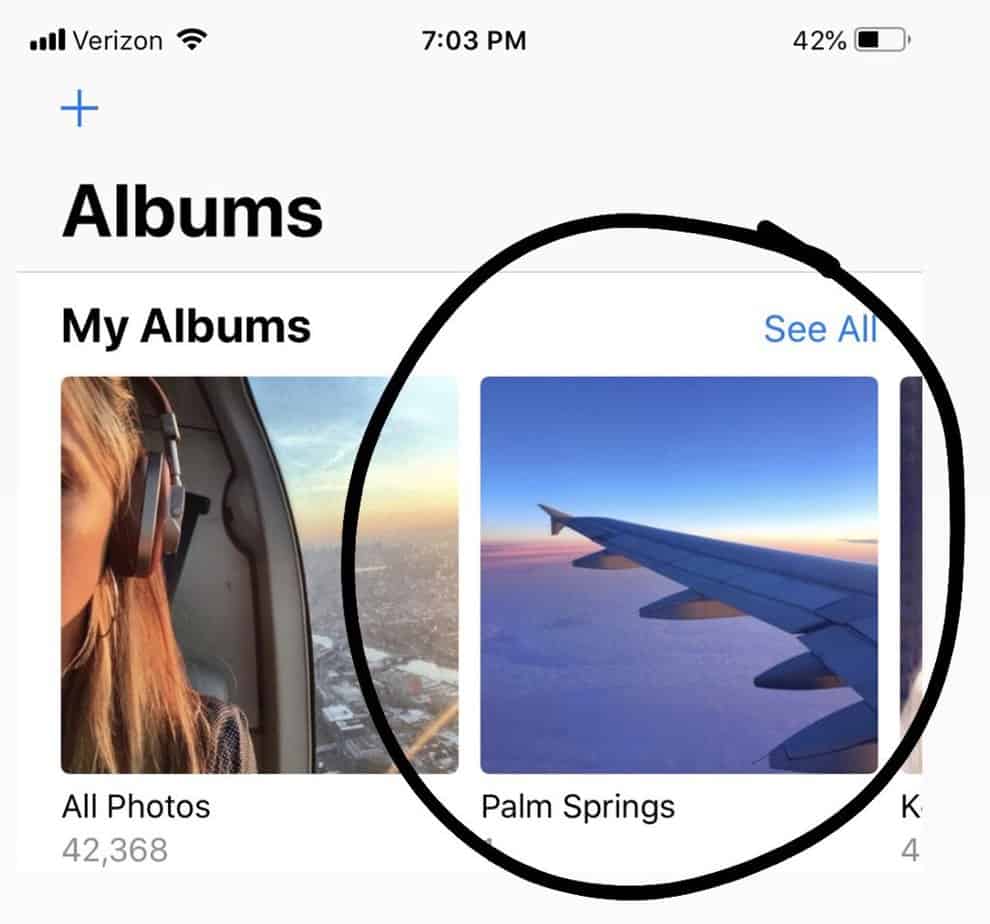
Save all of your favorite trip photos into an album in iPhoto so that you can find them quickly.
39. Turn your travel photos into cool animations using free apps.
One of my favorite ways to jazz up my photos following a trip is by using apps like KiraKira and Enlight Pixeloop. (For example, I have a little tutorial that shows you how to add falling snow to your photos in 30 seconds.)

40. Use a pants hanger to ensure blinds stay closed over night.
There’s nothing worse than waking up at the crack of dawn on vacation because of a small gap in the hotel drapes. I avoid this by using a hanger with trouser clips to secure the two window shades together.
41. To find cheap flights, consider looking beyond the obvious sites like Kayak and Expedia.
If you set the tab or filter to “everywhere” or “anywhere” and are flexible with your dates and travel time, you can find really inexpensive flights and even earn extra miles if you fly an extra leg.
A few of the best “deals” sites are:
- Sky Scanner
42. Always ask for an upgrade.

Unless you’re on an unlimited budget or celebrating a special occasion, never book the best room at a hotel—but always ask for an upgrade. I did this on a recent trip to Maui , as well as in the Maldives and St Barths , and totally lucked out!
Make sure to join the hotel’s loyalty program before arriving (they’re free), since they usually honor those requests for members as long as a higher room category is available.
43. Sometimes, the budget airlines have even cheaper flights on their sites.
Also, if you sign up for their newsletter and loyalty clubs, you get added perks and insider info. A few that comes to mind are Norwegian, Frontier, Southwest, and Spirit.
44. Be a “country counter.”
Download the “Been” app to keep track of the countries and states you’ve visited.
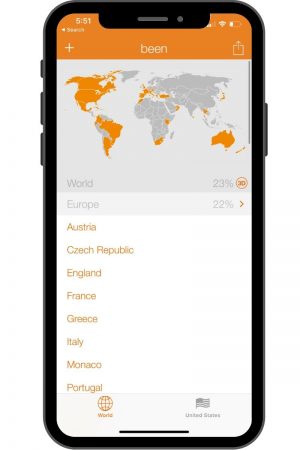
45. Get a more authentic “local” experience with your accommodation.
Using sites like Air BnB, VRBO, Booking and others gives you the opportunity to live more locally and at a significantly discounted rate. In fact, sometimes the house share experience is more personalized and luxurious.
46. Book a private room at a hostel to save money.
If hostels are an option (check HostelWorld.com), you can book private rooms for a really cheap rate. This is a great way to 1) save money 2) meet new people (perhaps people you could room with in another country on future trips.)
47. Always have a back-up power source.
Charge an external battery before you travel, and have it with you on the plane in case the seats don’t have outlets.
48. Compare flight prices using Airfare Matrix.
AirFare Matrix is something travel agents use. It is a Google tool and allows you to do some great price comparison without the third party interjection (that can sometimes cause you to pay more if you’re not searching in an incognito browser).
You can’t book directly from the site, but can use the codes as a source to get the cheapest price when you call an agent, or even the airline.
49. Try toggling to a different “home” country when searching for flights to get cheaper rates.
If you’re looking to fly a specific airline, set your country (usually in the top right hand corner or in the website’s footer) to one that has a good FX rate (of the countries available, of course).
This will allow you to view and purchase the flights in another currency, and potentially save big! It will take some time and some trial and error, but if you have the time, it’s worth it!
50. Mark your bag fragile.
It’ll be handled properly and make it to the top of the pile, ensuring your luggage comes out in the first batch!
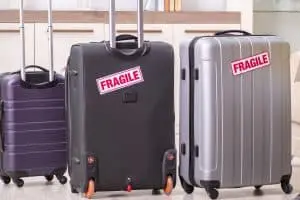
51. Before you pay for an upgraded cabin, see if the flight is full.
If not, put yourself on the upgrade list as soon as you can. Also, offering to get bumped from a flight and wait for the next flight could give you leverage to negotiate a better seat (and maybe even money or points).
52. Use FourSquare for Wifi.
You can find wifi passwords on FourSquare for restaurants, cafes and other places (just be careful, obviously, as not all of these are secure.)
53. Turn on “Private Browser” when searching for flights.
Prices do, in fact, fluctuate based on the cookies in your web browser and how many searches you’ve performed for a specific destination. Which is why searching for flights in a private browser (also known as “incognito mode”) is an absolute must.
If you’re using Google Chrome, you can enable Incognito mode by hitting Command + SHIFT + N.
If you’re using Firefox or IE, you can enable a private browser by hitting COMMAND + SHIFT + P.
54. Bring an oversize scarf on the plane that doubles as a blanket.
Then wear it as a chic cape during your trip.

55. Save on parking by pairing up with a local.
Garage Pointer is a website that connects you with people who own parking spaces and are willing to rent them (temporarily) to visitors. As of now Garage Pointer is only available in the U.S.
56. Rent a car…from a local.
Ready for the best car travel hack? Look into whether or not Turo is available in your destination. The app and website connects you with people who own cars and are willing to rent them out for a fee that is (usually) much less than traditional car rental.
57. Overwhelmed with what to pack? There’s an app for that.
PackPoint helps you determine what to pack based on where you are going and the length of your trip. It checks the weather in your upcoming destination and then provides a detailed packing list for you. (I would also recommend using my “what to wear” guide if you’re packing for trip to Europe in the winter .)
58. Use a service to ship your clothes ahead of your trip.
Sure, this might not be for everyone, but did you know there was a service that stores, packs, ships and cleans your clothes prior to trips? It’s a company called DUFL . While it’s definitely targeted to a very specific market, DUFL is an incredible concept.
You send them a capsule wardrobe (consisting of clothes you need for every trip, like business travel), and they’ll store the clothes in a “virtual closet,” which you can access through the app prior to your departure. They then send the clothes to your hotel ahead of your arrival, and collect them to dry clean and store when you leave.
59. Use FlightAware to track your flights.

The website and app allows you to track your flight (or the flights of loved ones) in real time. It’ll also keep you up to date on important info, like whether the incoming flight is delayed, or if the flight had to be rerouted for any reason.
60. Invest in a good adapter/plug converter.
I like this one because it works in all countries, and also has USB ports.
61. Book tours and experiences through AirBnB.
Did you know that Airbnb can be a great resource for things other than accommodations? Over the past few years, the company has expanded to include incredible local experiences and tours.
62. Wear a travel outfit that looks super chic—but it secretly comfortable.

I have an entire blog post dedicated to this (linked above!) but in a nutshell, I’m a big fan of looking put together when I travel. However, I also wouldn’t be caught dead wearing jeans on a long flight.
There are a few little tricks I use to turn otherwise sloppy outfits into something that you’d be confident walking into a luxury hotel wearing.
The most important thing? A lightweight fringed scarf (which doubles as a blanket mid-flight) and a leather or denim jacket.
63. Invest in a great pair of noise-cancelling headphones.

We’ve all been stuck next to a screaming child or chronic sniffler on long flights, and the experience can truly get your trip started off on the wrong foot.
I truly can not tell you how much of a game-changer noise-cancelling headphones are. While everyone else around you is having a meltdown over not being able to sleep or concentrate, you’ll be in your own little zen world.
Pro tip : if you don’t want to spring for the fanciest new technology, buy older or discontinued models of Bose headphones on Amazon for a fraction of the price for latest models.
64. Leverage special occasions for perks.
Celebrating a big anniversary or planning a trip for your honeymoon ? Be sure to let the hotel know in advance. When my husband and I went to Thailand and the Maldives for our honeymoon, we mentioned it to each property that we booked, and ended up with upgrades, bottles of champagne sent to the room, and other extra special perks from hotel staff.
65. Use your h otel’s shower cap to protect your toiletries from exploding.
Nervous about your liquids exploding in your toiletry bag on the flight home? Wrap them in the shower cap provided to you in the room. And if you don’t have a shower cap: use the plastic liner that comes with your ice bucket.
66. Download the Revolut app.
The popular European banking app recently launched in the U.S., and it allows users to exchange currencies from 55,000+ surcharge-free ATMs nationwide.
67. Seek itinerary inspiration through social media.
Use Instagram to inspire your itinerary. Browse through hashtags and geotags to see where people took gorgeous photos—and then go to those places! Alternatively, you can google things like “ The Best Instagram Spots in NYC ” or “ The Most Instagrammable Places in London ” for fun ideas.

68. Use AirHelp to get compensated for flight delays or cancelled flights.
We’ve all been there: you miss a connection because of a delayed flight, or your flight get inexplicably cancelled, and you know that the airline has to owe you some kind of compensation.
The problem is that actually getting what you’re owed can be a logistical nightmare that involves long wait times, endless phone calls, and unanswered emails. AirHelp essentially plays the middleman by acting on your behalf.
They do charge a fee (which is a percentage of what you’re ultimately compensated) but as someone who has used the service successfully, I can say that it is VERY much worth saving you the headache.
Plus, Airhelp knows exactly what you’re entitled to based on their expertise, so you’ll often end up getting more than you would have received on your own.
69. Do your souvenir research ahead of a trip.

One thing I always do before I travel is a bit of research about the most unique gifts and souvenirs to buy in the destination I’m heading to. Looking this up ahead of time might top you off to some really cool new boutiques, and it will also guarantee that you don’t end up at an airport gift shop wasting your money on a meaningless memento.
For example, this list of the best things to buy in Paris contains a ton of “hidden gems” within the city you might never have known about otherwise. There’s also something extremely satisfying about going on the hunt for a specific unique item—and then finding it!
70. Keep a note in your phone filled with travel quotes .
For those times that you desperately want to post an Instagram photo, but you’re at a loss for a caption.
Did you find this list helpful? Are there any travel hacks you love that I didn’t include? Drop them in the comments below!
Thank you to nicole cueto aka @thecubancarrie for her contributions to this piece.
Pin this post for later:

You Also Might Like

What to Buy in Paris: 12 Souvenirs You Can’t Leave Paris Without

The Best Things to Do in Positano, Italy

The Best Carry-On Luggage for Travelers
If you’re traveling with an infant/toddler; bookmark, screenshot AND print the rules for taking things like breastmilk/formula/snacks through security as well as the policy about early boarding for families. It helps to be prepared for any hiccups. And even if you just fly once or twice a year with a child, get TSA Precheck. Your child under 12 can go through the line with you, which makes things SO much faster.
Lindsay Silberman
this is SUCH a good tip (and one i would never have thought of!) thanks for sharing!
I always get a seat on the plane forward of the wings. Any turbulence the plane encounters dieting the flight is less bumpy in the front half.
Charles Loes
these hacks help me a lot thanks for such guidance.
I always get a seat on the plane forward of the wings. Any turbulence the plane encounters during the flight is less bumpy in the front half.
Helen Gaskin
Really a complete guide has never seen such stuff there. I am all the way from Pinterest and your pin is best to attract anyone. And guide too.
Leave a Reply Cancel Reply
Save my name, email, and website in this browser for the next time I comment.
The Perfect Skincare Routine for Beginners
60 quotes about travel that will inspire your wanderlust.
- Go to navigation
- Go to main content
- Go to search
- Go to footer
Main content

What the Hack: The Best Travel Hacks From the Pros
Flight attendant Florian Schwebel is always prepared for anything on his travels. He shares his best travel hacks with us
In my job, I quickly learned one thing: most of the time, you never need all the clothes you've packed in your suitcase. That's why I choose what I take with me very carefully. Especially when I'm only in one place for 24 hours, as is often the case.

Travel Hack #1: Jogsuit
I always have a "jogsuit" with me in a basic color like grey or blue. These are suits made from jogging trouser fabric, which are available from various brands. They don't have a pleat, don't crease and look very casual in combination with sneakers. You can put them in the washing machine when you get there and you're instantly styled if you want to go out in the evening shortly after your arrival.
Travel Hack #2: Longsleeve made from merino wool
A merino wool longsleeve is also always on my packing list. The material has the advantage that it is sweat-resistant and regulates the temperature well. This is very practical if you don't know what weather to expect when you get there. Just like a super-light, compressible and waterproof jacket that can be folded up into a small package.
Travel Hack #3: Moisturizing spray
To make sure I look fresh and awake after a long flight from Germany to the USA, I like to spray moisturizing spray on my face. It works wonders.
Travel Hack #4: Duffel bag
On short trips, I usually only have a small duffel bag with me instead of a hard-shell suitcase. It's easier to squeeze into the overhead compartment on the plane. And in case I have time to go shopping on the road, I always have a foldable mini travel bag with me. You never know what you might discover.
Florian Schwebel is a flight attendant at Lufthansa. He travels both intercontinental on long-haul routes and within Europe.
Ready to discover the world?
Book your flight and find new inspiration – wherever the journey may take you.
Find flight

Miles and Points to Japan
W e have a lot of people wanting to go to Japan (myself include) and it is reopening (finally) on October 11th. It is definitely on my radar and I’ve been wanting to plan a trip there soon. So, basically, this post is as much for me and my research as it is for our readers. Once I do finally get to go, I will for sure do a recap of my trip. Hold on, this could be a long post! Points and Miles to Japan – let’s go!
Most people want to go in the spring to see the cherry blossoms and this is the busiest time. The fall is also busy due to the changing of the leaves. The rainy season is the end of May to July and the hot and humid season is from June to August. I think that I will choose the fall to go as the weather is better for me and not as busy as cherry blossom time. You can check here for the weather and the best times to go. Be sure and listen to Podcast #64. Jess’s Luxurious Trip to Japan: Travel On Points to The Land of the Rising Sun for some great ideas too!
Although seeing the cherry blossoms in Japan would be wonderful, I don’t want to travel with crowds.
There are many ways to use points and miles for flights so this won’t cover them all. I’ll use my home airport, Denver, as a starting point so I can refer back to it. Some are easy redemptions, some are more complicated.
United Airlines
Let’s start with the easiest one for me as I live near a United hub. I will not be traveling all the way to Japan in economy class so my screenshots will be of business class. You can fly to Tokyo at two airports. I just searched all airports and found this landing at Narita airport which is outside of Tokyo. There were similar flights arriving at Haneda airport, inside Tokyo.
There were a ton of 70K award flights. Basically, this would be 140K for business class for a roundtrip ticket and 70K for economy class. What I love about this flight is that it is nonstop. I would probably look for an evening flight so I could sleep most of it. This is a very good (and easy) option for me or anyone who lives near a United hub or is willing to position to a hub.
I could use points from a United credit card or transfer points to United from my credit cards that earn Ultimate Rewards . The great news is that this opens up flights to all the Star Alliance partners. I may book on United but fly one of their partner airlines.
ANA (All Nippons Airway)
I like the idea of using ANA because of two things:
- The flights are cheaper than what I would pay to fly United to Japan.
- They are a transfer partner with American Express and I have a lot of points that I would like to use and thus save my frequently used United miles.
The con of using them is that they are difficult to use to fly to Japan for those reasons. Most people have to book almost a year out to find availability, whereas I can find availability much easier with United and other airlines.
I was able to find economy seats almost a year out for 55K seats roundtrip. I searched for business class seats for quite a while but they were all waitlisted and I wouldn’t want to take a chance on them opening up.
You cannot book on ANA using awards for a one-way flight. It has to be a round-trip flight to use miles/points. ANA is about 90K in business class round trip when you find it. Just know that you have to be diligent in searching and flexible with your dates.
American Airlines
American Airlines usually does not have award prices for a business class that are competitive but sometimes you get a web saver price that is great. I was completely shocked to find a 60K business class seat to Tokyo from Denver with only one stop. This gives me more options.
There are three solid options for me to get to Tokyo – if you have done others, let me know!
Since most people go to Tokyo for part of their stay, I am going to concentrate on hotels there. There are many of the same brands throughout Japan.
You can stay at some very nice Hyatt Hotels in Tokyo, anywhere from 12,000 points for a Hyatt Regency to an Andaz Tokyo for 30,000 points. Using points and miles to Japan does not cost you a ton to stay in a beautiful hotel. Here are some of the best choices:
Staying at the Hyatt Regency Tokyo will cost as little as 12K Hyatt points!
Using points and miles to Japan and booking a room at the beautiful Park Hyatt Tokyo will only cost 25K a night. You can use points from Chase Ultimate Rewards or Hyatt points to make this your dream lodging. Many, many people have written fabulous reviews after their stay here.
Park Hyatt Tokyo
Finally, here is where I might stay if I pass on the Park Hyatt. I am undecided right now. (Let me know if you have a review of one that you’ve stayed at.) The Andaz Tokyo looks amazing with gorgeous views of the city. I am a lover of the Hyatt Andaz brand so I might be willing to pay 30K/night to stay here. Here is a place to see a review comparing the two.
Hyatt Andaz in Tokyo is 25K a night off-peak.
Marriott Hotels
You can find rooms to book in Tokyo with Marriott points or annual free night certificates that range from 35k/night to 85K/night.
Cheaper-priced hotels include the Sheraton Miyako Hotel Tokyo and the Aloft Tokyo Ginza and the Courtyard Tokyo Ginza Hotel.
The Tokyo Marriott can be booked for as little as 40K points.
Other hotels you can book in Tokyo for around 50K points (depending on time) include the Courtyard Tokyo Station , Mesm Tokyo, Autograph Collection , The Prince Sakura Tower Tokyo, Autograph Collection , and The Westin Tokyo .
The Prince Sakura Tower Tokyo, Autograph Collection can be booked for 50K Marriott points.
Finally, we have some pure luxury with points and miles to Japan with these Marriott points that will book at 70K-85K points. If you have a lot of points, you can stay at the Tokyo EDITION, Toranomon , the Ritz-Carlton Tokyo , or the Prince Gallery Tokyo Kioicho, a Luxury Collection Hotel .
The Ritz Carlton is 100k/night.
When you are thinking about going to Japan on points and miles you probably don’t think of IHG because you think about the Holiday Inn Express. You might not want to stay there without kids on a dream vacation but have you ever stayed at an Intercontinental Hotel? They are fabulous and Asia is the perfect place to use IHG points.
I have always received upgrades, breakfasts, and elite recognition in Asia with my Platinum Elite Status (which comes free when you have the Chase IHG Rewards Club Premier Card ). It is my favorite card to use in Asia for hotels. And, speaking of Intercontinental Hotels, here are two possibilities. The IHG generally card gives you a 125,000+ point welcome offer. I can get 2-3 nights for free at these Intercontinentals!
Hilton Hotels
Last, but not least, let’s look at Hilton. One thing that I like about using a Hilton in Japan is that if you have the Hilton Aspire card, you could use your resort credit for one of your nights.
Hilton Tokyo Odaiba – 69K/night.
If luxury is your jam, stay at the Conrad Tokyo for 88K/night.
Bottom Line
I’m so excited that Japan is finally opening up completely. I am ready to plan a trip to Tokyo on points and miles. I know a lot of you have the same plans. Let me know in the comments where you plan to stay and how you are getting there!
Related Posts:
Podcast #64. Jess’s Luxurious Trip to Japan: Travel On Points to The Land of the Rising Sun
Ultimate Reader Success Story to Japan
Points and Miles to Tokyo
Andaz Tokyo Toranomon Hills Review
![We have a lot of people wanting to go to Japan (myself include) and it is reopening (finally) on October 11th. It is definitely on my radar and I’ve been wanting to plan a trip there soon. So, basically, this post is as much for me and my research as it is for our readers. Once I do finally get to go, I will for sure do a recap of my trip. Hold on, this could be a long post! Points and Miles to Japan – let’s go! Most people want to go in the spring to see the cherry […] We have a lot of people wanting to go to Japan (myself include) and it is reopening (finally) on October 11th. It is definitely on my radar and I’ve been wanting to plan a trip there soon. So, basically, this post is as much for me and my research as it is for our readers. Once I do finally get to go, I will for sure do a recap of my trip. Hold on, this could be a long post! Points and Miles to Japan – let’s go! Most people want to go in the spring to see the cherry […]](https://img-s-msn-com.akamaized.net/tenant/amp/entityid/BB1jz161.img?w=768&h=530&m=6)
Recommended
Liquid leaks down aisle from bathroom on spirit flight traveling to nj.

Jerry Seinfeld berated by anti-Israel protesters outside NYC event

Matthew McConaughey on why he feels so connected to Marfa, Texas

Two-toilet bathroom will make you do a double take

Japan’s Space One Kairos rocket explodes just seconds into inaugural flight

I’m a solo female traveler — I have to lie to strangers to stay safe

My travel hack saves so much time and stress — I never have to look at airport screens

Joe Rogan blasts ‘The View’ over co-hosts feud with author Coleman Hughes: ‘Rabies-infested henhouse’

Unbe-weed-able! Tumbleweeds take over Utah town

North Carolina HS student charged after slapping teacher in profanity-filled classroom tantrum

Video shows unsuspecting shopper falling into massive sinkhole as second floor of shopping center collapses

IMAGES
VIDEO
COMMENTS
Japan is a popular destination for its rich culture, delicious food, and stunning landscapes. However, Japan can also be expensive, so it's important to know some travel hacks to help you save time and money.. Japan is a cash-based society, so most businesses and restaurants don't accept credit cards.This can be difficult for foreigners not used to carrying large amounts of cash.
22. It's difficult to be gluten-free in Japan. While the abundance of rice may make you think Japan would be an easy country for gluten-free travelers, that's simply not the case. Soy sauce and other wheat-based seasonings are an integral part of Japanese cuisine, making it hard to avoid gluten.
Top 10 Japan Travel Hacks; Visiting Japan can be daunting with its sheer density and complexity — utilize these 10 tips for a smoother experience. A lot of tourists come to Japan with little idea of the available conveniences that can make traveling much easier. From coin lockers to manga cafes, these hacks are invaluable for making a more ...
Here are 10 Japan travel hacks and tips that will make your trip almost infinitely better. Chris Rowthorn traveling light in Japan. Don't wait on line when you arrive in Japan. Buy a SUICA card. Use Japan's luggage delivery services. Stay in nicer rooms in cheaper hotels. Travel light. Take taxis when it makes sense. Fly domestically.
Japan travel hack, guys! 8. Invest in a Cultural Experience. An absolute HIGHLIGHT of my time in Japan was spending a couple of hours learning all about Samurai culture! MANY dojos offer touristic samurai experiences, however, only a handful are the real deal, and I strongly recommend doing your research. The school we went to was amazing, I ...
tourist visiting Japan. . If you plan on visiting the likes of the Warner Bros. Studio Tour Tokyo - The Making of Harry Potter, Tokyo Disney Resort, Ghibli Park, Shibuya Sky observation deck ...
In this article, I will share some of the Japan travel hacks, tips, and some must-have essentials that enhanced my travel. Hopefully, they will help smoothen your future trip to Japan as well! Also read: 14 Common Culture Shocks Foreigners Have About Japan. Useful Japan travel hacks and tips you should know 1. Learn basic Japanese words and phrases
These travel hacks for Japan made my trip 10x easier. Japan makes the process of exploring its country as effortless as possible for travelers. After traveling for over half a decade, I've found that only a handful of countries are this mindful of ensuring convenience for visitors. The thing is — you can't take advantage of Japan's ...
Whether you're visiting Japan for the first time, or planning a return visit, these Japan travel tips will help you prepare for your trip and get the most out of your time in the country. This is a long article, featuring 39 of our best pieces of Japan travel advice. If you have the time and interest, we hope you'll read all the way through.
Subscribe to Japan Travel Hacks and embark on an adventure with us. Let's explore Japan's rich history, breathtaking landscapes, and vibrant cities while unlocking the secrets to hassle-free travel.
Well, calm your farm and settle your kettle because GaijinPot have teamed up with the guys at Travel Japan Wi-Fi to offer the following smart travel hacks that will help you make the most out of your Japan adventure. 1. Get a travel (IC) card. A post shared by よしだまさひこ (@yoshidamasapico) on Jan 29, 2017 at 3:18am PST.
To ensure your journey is as smooth and enjoyable as possible, here are six genius travel hacks tailored just for you. From navigating public transport like a pro to experiencing authentic local culture, these tips will help you make the most of your time in Japan. 1. Master the Art of Japanese Public Transport.
Japan offers many options, so your first time might feel overwhelming. A simple framework for your trip is to think of it as a meal: Appetizer: Soak in the vibe, and do some sampling while you get over the jet lag (Tokyo and Kyoto). Main Course: Attend some must-see sights and experiences (Tokyo and Kyoto).
Logistical Hacks. Within this section, you'll find all of my work that pertains to transportation, logistics, accommodations, etc. Whether you're wondering if that Japan Rail Pass is really going to save money or if a ryokan stay is really right for you, you'll find all of the answers to your travel queries here. See Articles.
Top 10 Japan Travel Hacks and Tips. I share my top 10 travel hacks and tips that will make your trip to Japan almost infinitely better - from finding a better hotel room at a cheaper rate to faster transport between cities and attractions. Read More. Nishimuraya Honkan.
Japan Travel Hacks Sometimes, it even feels like a whole different planet but Japan has its own charm and a lot of things to offer to tourists. In this section of our website, we'll share some of our most helpful Japan travel hacks that will make visiting Japan a lot easier.
Japan travel hack #3: Take a night bus to save on accommodation costs. Japan travel hack #4: Buy a regional JR Pass. Japan travel hack #5: Visit free attractions. Japan travel hack #6: Shop at a 100 Yen shop. Japan travel hack #7: Buy food and drinks from vending machines. 1.
First time visiting Japan? Here's a collection of the top tips you need to know before heading on your trip.VISIT JAPAN WEB:https://services.digital.go.jp/en...
Japan Transportation and Travel Guide Tips and Hacks.Check out Luggage-Free Travel Use CODE Paolo and Get 20% off- http://bit.ly/3a7Faas These are my must-kn...
A trip to Japan is a must do for any avid traveler. Here are our favorite Japan travel hacks to help you save time, money and have a better experience. Top Must-Have Travel Hacks When Visiting Japan. Travel hacking is one of my favorite hobbies. Through travel hacking, I can travel around the world for little to no cost.
The Travel Hack started in 2009 to document my two-year backpacking adventure around Asia and Australia. The blog has evolved over time and followed my travels and adventures around the world. I'm currently in Wales with my three children and I blog about our Welsh adventures, weekend breaks and family life.
How to Add a Digital Suica Card to Your Apple Wallet. Simply do this: Open Apple Wallet. Tap + sign or "add". Tap "transit card". Find "Suica" on the list. Add value to card (this will be charged to the credit card linked to your Apple Wallet) This process is described on the Apple site here.
70 Travel Hacks That Will Blow Your Mind. 1. Use my "contact lens case" hack for makeup and skincare products. This is one of my best space saving packing hacks. People tend to take up unnecessary room in their toiletry bags by bringing full-sized products. Here's the trick: put your foundation, moisturizer, eye cream, and any other ...
Travel Hack #2: Longsleeve made from merino wool. A merino wool longsleeve is also always on my packing list. The material has the advantage that it is sweat-resistant and regulates the temperature well. This is very practical if you don't know what weather to expect when you get there. Just like a super-light, compressible and waterproof ...
Hold on, this could be a long post! Points and Miles to Japan - let's go! Most people want to go in the spring to see the cherry blossoms and this is the busiest time. The fall is also busy ...
Appalling footage captured a mysterious liquid spilling out of the restroom and trailing down the airplane aisle on a Spirit Airlines flight to Newark. Passengers aboard a Spirit Airlines flight fr…